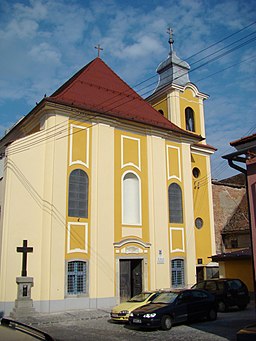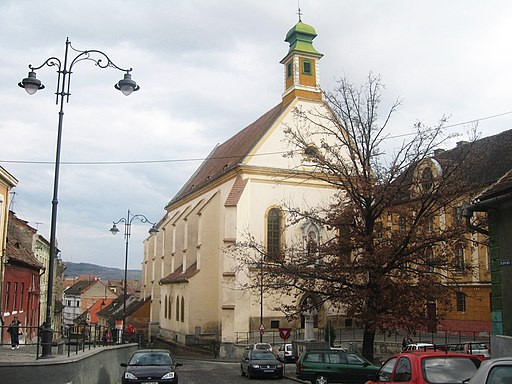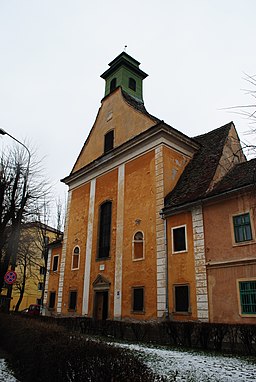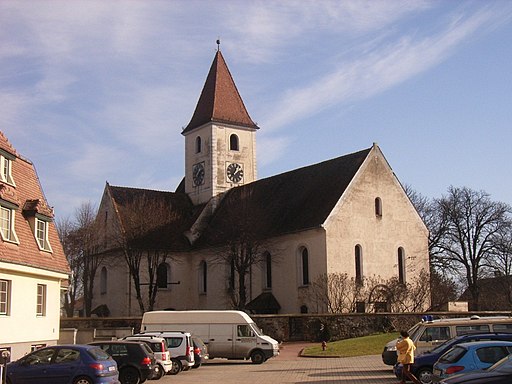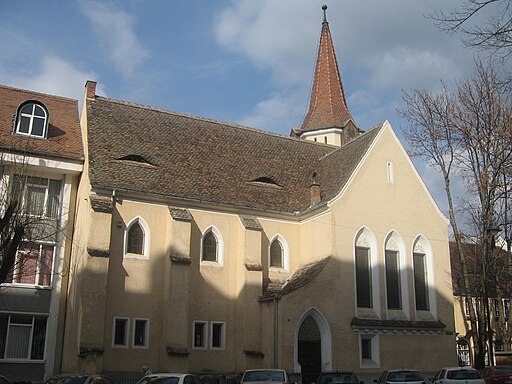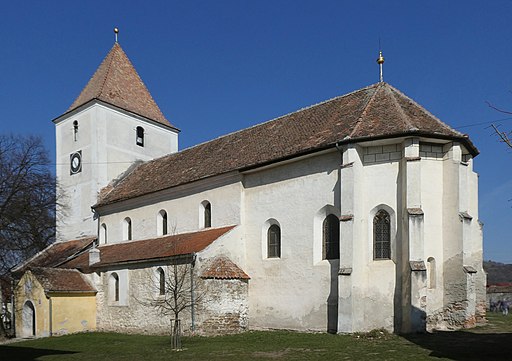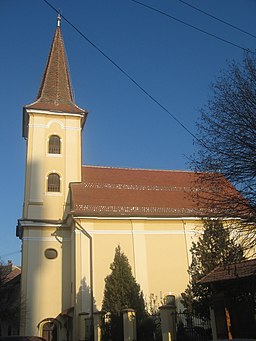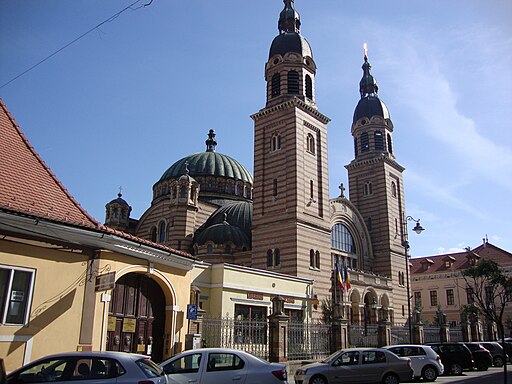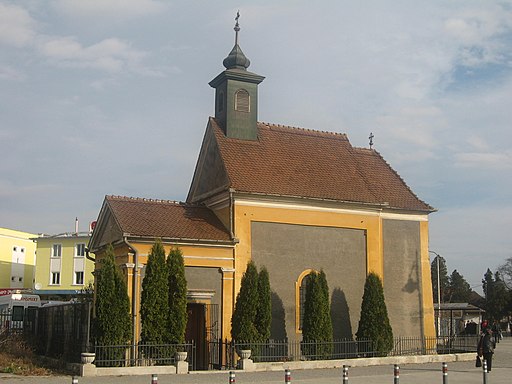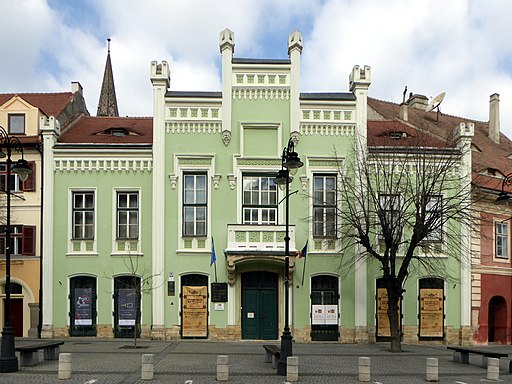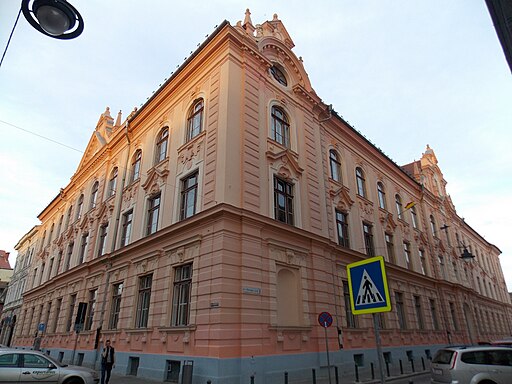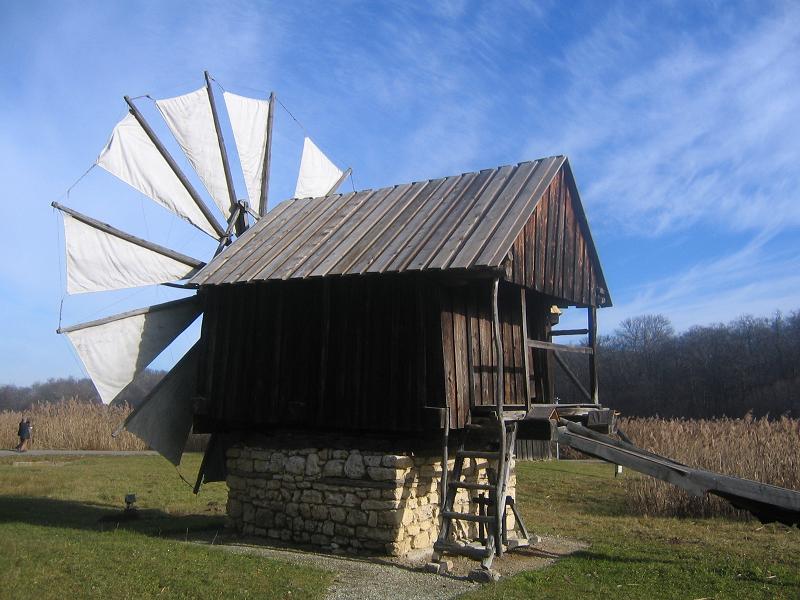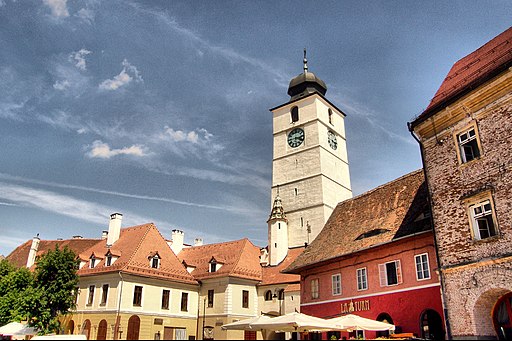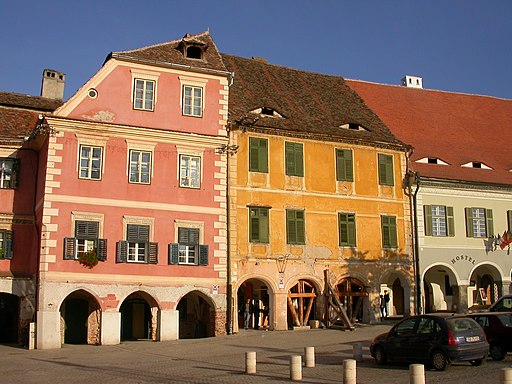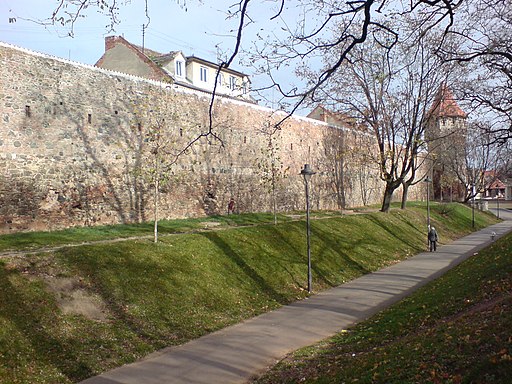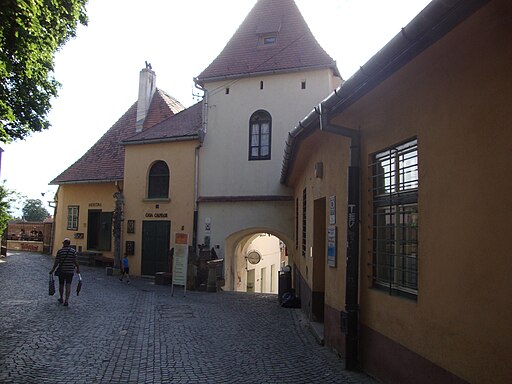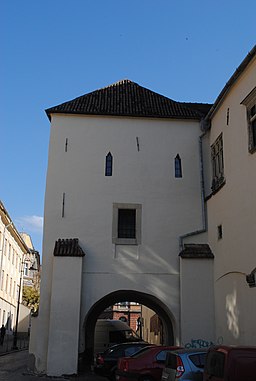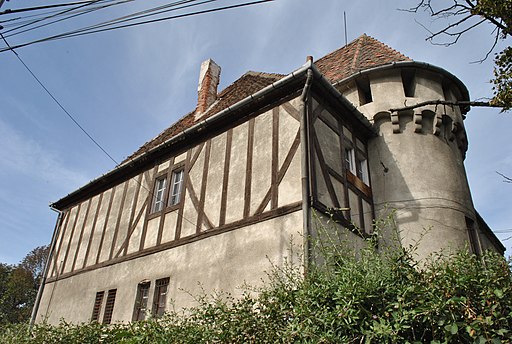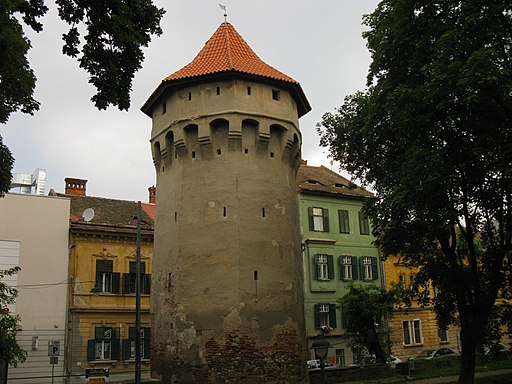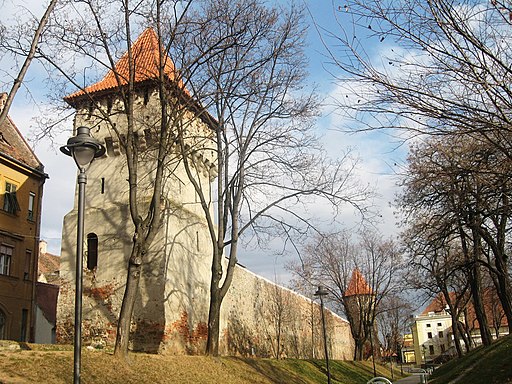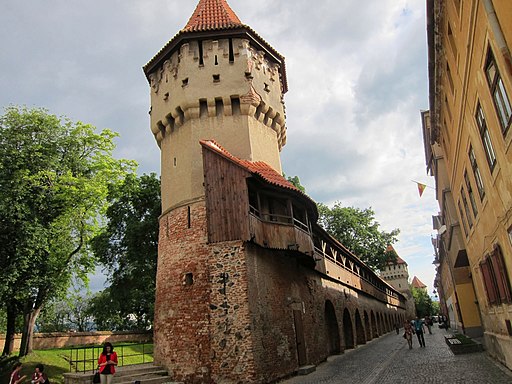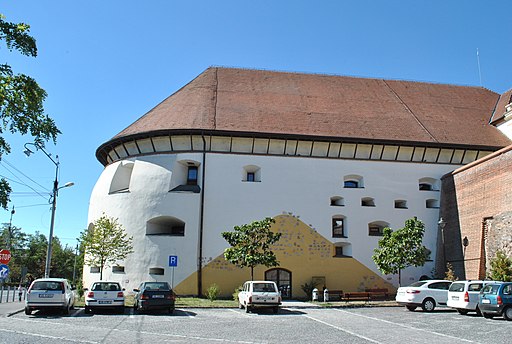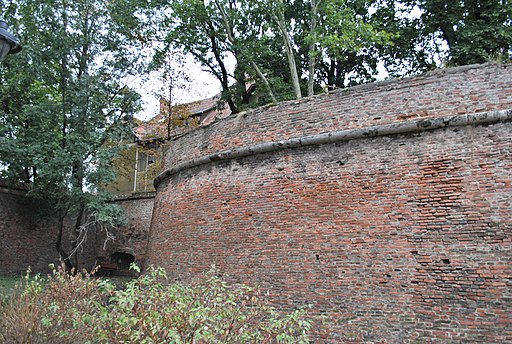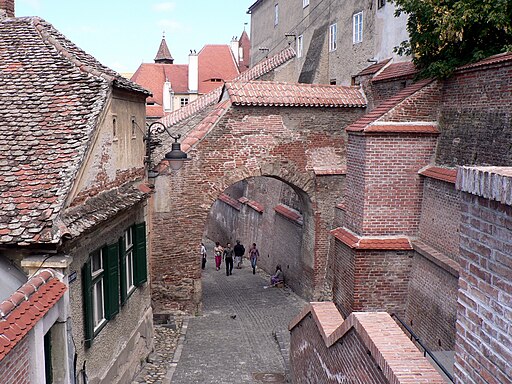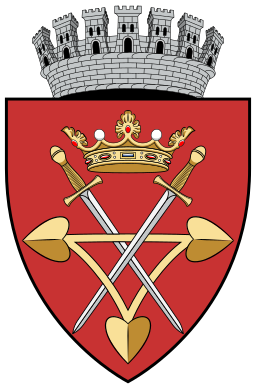Nagyszeben
Historical Hungarian county:
Szeben
GPS coordinates:
45.798068, 24.151418
Population
Population in 1910
| Total |
38061 |
| Hungarian |
19.17% |
| German |
52.59% |
| Vlach |
26.6% |
Coat of Arms
Madboy74, Public domain, via Wikimedia Commons
The town was founded in the 12th century by King Géza II of Hungary, who settled Germans here to protect the Vöröstorony Pass after the Székelys had been moved to present-day Székelyföld. The Transylvanian Saxons, as the German settlers were uniformly called, owed their extensive freedoms and autonomy to King Andrew II of Hungary. Until the 15th century, the provostry of Szeben was the Catholic ecclesiastical centre of the Transylvanian Saxons. The town soon became the commercial and spiritual centre of the Transylvanian Saxons. The head of the Saxons was the Count of Szeben, confirmed by the Hungarian king. King Charles I abolished the authority of the Count of Szeben and divided the Saxons' land (called King's land) into seats, the administration of which was entrusted to a royal judge appointed by the king. The town became the centre of Szeben Seat and a free royal town. The fortification of the town was carried out in several stages from the 13th to the 15th century. It was the most important Saxon town of the seven towns after which Transylvania got its German name Siebenbürgen. The town got rich from trade between Hungary and Wallachia. King Matthias of Hungary strengthened the autonomy of the Saxons, and the Transylvanian Saxon University was established, the self-governing body of the Transylvanian Saxons, which was subordinate to the king alone. The Count of the Saxons was elected by the Saxons from among the 12 members of the Szeben Town Council. The Saxons were to be judged exclusively by the Saxon University, and the official language was German. The Saxons converted to Lutheranism during the Reformation. From the 16th century onwards, the Saxons generally supported the Habsburgs against the Hungarians, despite the fact that most of the time they received only strong centralisation and violent recatholization in return, with the exception of their mostly loyal attitude towards the Principality of Transylvania, which had guaranteed their religious freedom and autonomy. For a long time after the Habsburg occupation of Transylvania in the 18th century, it was the seat of the Transylvanian provincial government. After the suppression of the Hungarian War of Independence in 1849, the Habsburg court abolished the autonomy of the Transylvanian Saxons who had supported them during the war. This was later restored, but was finally abolished with the modernisation of the public administration after the Austro-Hungarian Compromise. The fate of the Transylvanian Saxons was brought about by the Romanian occupation, after which the vast estates of the Saxon University were confiscated. The majority of the Saxons, who had been left in a hopeless situation, emigrated to Germany in exchange for ransom during the Ceaușescu era.
Check out other towns in Transylvania as well!
895
Arrival of the Hungarians
Little more...
895
The alliance of the seven Hungarian tribes took possession of the then largely uninhabited Carpathian Basin. Until then, the sparse Slavic population of the north-western Carpathians had lived under Moravian rule for a few decades after the collapse of the Avar Khaganate in the early 9th century.
after 895
After the Hungarians arrived in Transylvania, Székelys settled in the area.
1000
Foundation of the Hungarian Kingdom
Little more...
1000
The Kingdom of Hungary was established with the coronation of King Stephen I. He converted the Hungarians to Christianity and created two archdioceses (Esztergom and Kalocsa) and ten dioceses. He divided Hungary into counties led by ispáns, who were appointed by the king.
1141-1161
During the reign of King Géza II of Hungary, German, Flemish and in smaller numbers also Walloon settlers arrived in southern Transylvania. The settlers probably came after the second crusade crossed Hungary in 1147. People who couldn’t count on inheriting land in their homeland came from the territory of the dioceses of Cologne and Trier. They were granted new home in Hungary on lands that had recently become desolate after the Székely border guards living there had been relocated to the area of Háromszék by order of the king. These settlers were later called collectively Saxons, which does not mean that they came from Saxony.
around 1147
The town was established by King Géza II of Hungary, who invited Germans settlers to defend the Vöröstorony (Red Tower) Pass, after he relocated the Székelys. The town was named after the Szeben Stream, which might come from the Slavic svbina noun meaning cornel. According to others, the town’s name comes from the Turkic personal name Sebin.
1191
The town was mentioned for the first time as Cipin, when the Pope confirmed the establishment of the provostry of Nagyszeben. It was the Catholic church centre of the Transylvanian Saxons until the 15th century. The town soon became the trade and intellectual centre of the Transylvanian Saxons. Szeben was a free royal town and the centre of the Seat of Szeben (Szebenszék). Seats were the special administrative units of the Saxons.
1223
The town was called Villa Hermanni. The German name of the town, Hermannstadt, was used for the first time in 1366, but it already appeared in the form of Hermannsdorf in 1321. Its origin is uncertain. The town was either named after Bishop Hermann II of Cologne or Hermann of Nuremberg, who was the founder of the town according to the tradition.
1224
King Andrew II of Hungary issued the Andreanum, the golden charter of freedoms of the Transylvanian Saxons (goldener Freibrief). This recognized the Saxons as collective legal entity, removed them from the jurisdiction of the royal ispáns (the leaders of the counties), and placed the newly appointed ispán of Szeben over them. The territory inhabited by the Saxons became their own property, and they were legally equal. If the owner of the land died without inheritors, the property reverted to the community and not the king. The Saxons elected their own superiors and priests. Their leader, the ispán of Szeben, also called Count of the Saxons (comes Saxonum), was appointed by the king, but after 1486 they could choose the count themselves. Saxons were allowed to hold fairs and trade freely. Their land was called King's Land (Királyföld, Fundus Regius, Königsboden). Saxons had the most rights in Hungary, they were actually exempted from feudalism. King's Land stretched from Szászváros to Barót.
1241-1242
Mongol Invasion
Little more...
1241-1242
The hordes of the Mongol Empire invaded Hungary and almost completely destroyed it. One third to one half of the population was destroyed. The Mongols also suffered heavy losses in the battle of Muhi and they could not hunt down the king. After their withdrawal, King Béla IV reorganized Hungary. He allowed the feudal lords to build stone castles because they were able to successfully resist the nomadic Mongols. The vast majority of stone castles were built after this. The king called in German, Vlach (Romanian) and Slavic settlers to replace the destroyed population.
1241
The Mongol army of Bogutaj that broke into Hungary through the Ojtoz Pass plundered the settlement, which was only weekly defended with a palisade. The houses were burned and the inhabitants were slaughtered. After the Mongol invasion, the settlement was quickly repopulated, and, thanks to the privileges granted by the king, rapidly developed and was granted town status already in the 13th century. The parish church was built on the hummock in the heart of the settlement at that time, which was encircled by walls with towers. In addition to this, the upper town was fortified by the middle of the 14th century, and the fortification of the lower town was completed in the 15th century. Later a natural line of defence consisting of small lakes was also created beyond the third ring of walls from the surrounding marshlands and one of the distributaries of the Szeben Stream.
1301
The extinction of the House of Árpád
Little more...
1301
The House of Árpád, the first Hungarian royal dynasty, died out with the death of King Andrew III. Hungary was ruled by oligarchs, the most powerful of whom was Csák Máté, whose main ally was the Aba family. King Charles I (1308-1342), supported by the Pope, eventually emerged as the most prominent of the contenders for the Hungarian throne. But it took decades to break the power of the oligarchs.
14th century
Szeben was the most important of the seven Saxon towns, which gave Transylvania its German name Siebenbürgen. The town already had 19 guilds and it was engaged in extensive trade primarily with Wallachia outside Hungary, but its products reached also Western Europe. The rapidly accumulating wealth of the town made possible the constant improvement of its defences.
1324
King Charles I of Hungary abolished the authority of the ispán of Szeben having too much power by dividing the province into Saxon seats led by royal judges assigned by the king.
1432
The Turkish army of Bey Ali crossed the Danube at Nicopolis and broke into Transylvania together with the army of Voivode Vlad Dracul of Wallachia, who became a traitor. They plundered the Barcaság and also the lands of the Székelys and the Saxons enslaving many people. They besieged Nagyszeben and Brassó, but both towns resisted successfully. Finally, the rapidly raised army of the Hungarian nobility drove them out of Hungary causing heavy casualties to the army of Bey Ali. In the meantime, the army of Vlad Dracul of Wallachia captured Szörény Castle from Redwitz Miklós and slaughtered the German knights that defended the castle, which ceased to be the bastion of Western Christianity.
1437
The three nations of Transylvania (the Hungarian nobility, the Székelys and the Saxons) formed an alliance in Kápolna (Union of Kápolna). This union gained its true significance after 1570, when Transylvania became an independent principality due to the Turkish conquest of central Hungary. These three nations were represented in the Transylvanian Diet, and they elected the prince. Vlach migrants (mostly shepherds and peasants) were a small minority at the time and were excluded from the political power just like Hungarian peasants. According to the agreement, the Saxon fortified churches were opened for the non-Saxon population of the neighbourhood as well in times of danger. This was a great concession, because only Saxons (and not even Hungarian nobles) could acquire land and purchase house in King's Land. Only Saxon monks could live in their monasteries and Saxons were strictly forbidden by their priests to adopt Hungarian customs, dress and hairstyle. The Transylvanian Saxons were never integrated into the Hungarian community that welcomed them and gave them so many privileges, and they never had any inclination to do so.
1438
The Turks attacked Szeben unsuccessfully. Sultan Murad II sent an army of raiders against Hungary under the command of Bey Ali. The Turks were aided by the Vlach army of Voivode Vlad Drakul of Wallachia. They crossed the Danube at Szörény Castle. They captured Medgyes with an assault, but Szeben resisted the siege. Finally, they burned the outskirts of Brassó and left Hungary through the Törcsvár Pass.
1442
Bey Mezid broke into Transylvania with an army of 30.000.
March 18, 1442
Hunyadi János with his army of 10 thousand took on a battle with the three times larger army of Bey Mezid at Marosszentimre. After the first successes, the Turks finally gained victory. Bishop Lépes György of Transylvania fell in the battle and Hunyadi retreated to Gyulafehérvár. The Turks, hungry for the big booty, besieged the Saxon town of Nagyszeben, which repelled their attack.
March 25, 1442
Hunyadi János crushed the Turkis army of Bey Mezid on the plain next to Nagyszeben. The Turks wanted to achieve victory by killing Hunyadi, who was informed of this. The hero Kemény Simon put on the ornate armour of Hunyadi voluntarily. The Turks assaulted him with full force and killed him. But their delight didn’t last long as they noticed that in the meantime the real Hunyadi captured their camp and encircled them. 20.000 Turks fell in the battle including Bey Mezid. After that, Hunyadi defeated Beylerbey Sehabeddin of Rumelia in July next to the Iron Gates gorge. These victories brought Hunyadi the fame as Turk-beater.
1456
Siege of Nándorfehérvár (Belgrade)
Little more...
1456
The Turkish army of Sultan Mehmed II, the conqueror of Constantinople, besieged the castle of Nándorfehérvár (Belgrade), which was the southern gateway to Hungary. But the Hungarian army, led by Hunyadi János, won a decisive victory over the twice to three times larger Turkish army. The Pope had earlier ordered that church bells should be rung every noon to pray for the victory of the defenders. Hunyadi János died of plague in the camp after the battle.
15th century
The lower town was fortified with walls due to the Turkish threat. With its area of 75 hectares, Szeben was the largest town fortification in Transylvania. It had 40 bastions.
1486
King Matthias of Hungary confirmed the autonomy of the Saxons. The Transylvanian Saxon Universality (universitas saxonum) was established, which was the official body of self-governance of the Saxons. It had administrative, legislative and judicial powers and was only subordinate to the King of Hungary. Saxons could only be judged by the Saxon Universality. It had the right to elect the Count of the Saxons from among the 12 members of the town council of Nagyszeben. The official language of the Saxon Universality was German, while the official language of Hungary was Latin.
1526
Battle of Mohács and the splitting of Hungary into two parts
Little more...
1526
Sultan Suleiman I launched a war against Vienna, instigated by the French. Ferdinand I, Duke of Austria, was the brother-in-law of King Louis II of Hungary. The army of the Ottoman Empire defeated the much smaller Hungarian army at Mohács, and King Louis II died in the battle. A group of the barons elected Ferdinand I of the House of Habsburg to the throne, who promised to defend Hungary from the Turks. He was the younger brother of the most powerful European monarch Emperor Charles V. But the nobility chose the most powerful Hungarian baron, Szapolyai János, who was also crowned as King John I. The country was split in two and a decades-long struggle for power began.
after 1526
After the battle of Mohács, Szeben supported King Ferdinand I against King John I. King John I held the town under siege for two years unsuccessfully. Later Balassa, then Majláth took command of the siege. The Saxons finally surrendered in 1536 on condition that they can keep their privileges.
1529
The first printing press of Transylvania was established in the town.
1541
The Turkish occupation of the capital, Buda, and the division of Hungary into three parts
Little more...
1541
The Turks conquered Buda, the capital of Hungary, after the death of King John I. The central part of the country was under Turkish rule for 150 years. The western and northern parts (including present-day Slovakia) formed the Kingdom of Hungary ruled by the Habsburg emperors. The eastern parts (now mainly under Romanian rule) were ruled by the successors of King John I of Hungary, who later established the Principality of Transylvania.
16th century
The town was one of the centres of Reformation in Transylvania.
1556
Fire devastated the town. Two of the towers in which gunpowder was stored exploded. The explosions seriously damaged the walls, the defences and the houses. In autumn, the Saxons of Szeben rose up and killed royal judge Johannes Roth, because they thought that he endangered their autonomy and their privileges. Another fire devastated the town one and a half decades later, when towers used for storing gunpowder exploded again.
1570
The establishment of the Principality of Transylvania
Little more...
1570
John II (John Sigismund), the son of King John I of Hungary, renounced the title of King of Hungary in favor of King Maximilian of the House of Habsburg, and henceforth held the title of Prince. This formally created the Principality of Transylvania, which was the eastern half of Hungary not ruled by the Habsburgs and was also a vassal of the Ottoman Empire. John II died in 1571, after which the three nations of Transylvania (the Hungarian nobility, the Székelys and the Saxons) elected the prince.
1591-1606
Fifteen Years' War
Little more...
1591-1606
The Ottoman Empire started a war against the Habsburg Empire. The war was waged in the territory of Hungary. The Turks defeated the combined armies of the Habsburg Empire and the Principality of Transylvania in the battle of Mezőkeresztes in 1596, but their victory was not decisive. The war devastated the Principality of Transylvania, which was occupied by the Habsburg army, and General Basta introduced a reign of terror.
1604-1606
Uprising of Bocskai István
Little more...
1604-1606
The alliance of the Habsburgs and the Principality of Transylvania was defeated by the Ottoman Empire in the Fifteen Years' War. The war devastated Transylvania, which was occupied by the Habsburg imperial army, and General Basta introduced a reign of terror. The nobility and the burghers were upset about the terror, the plundering mercenaries and the violent Counter-Reformation. Bocskai István decided to lead their uprising after the Habsburg emperor tried to confiscate his estates. Bocskai also rallied the hajdú warriors to his side. He was elected Prince of Transylvania and soon liberated the Kingdom of Hungary from the Habsburgs. In 1605 Bocskai István was crowned King of Hungary with the crown he received from the Turks.
23 June 1606
Peace of Vienna
Little more...
23 June 1606
Bocski István made peace with Emperor Rudolf. Their agreement secured the constitutional rights of the Estates of Hungary, and the freedom of religion. The counties of Szatmár, Bereg and Ugocsa were annexed to the Principality of Transylvania. Bocskai died of illness in the same year, leaving to his successors the idea of unifying Hungary from Transylvania.
December 11, 1610
Prince Báthory Gábor of Transylvania occupied Szeben with a trick during the country assembly gathered here. The prince himself stood on the drawbridge so that the guards wouldn’t dare to raise it even when they saw the soldiers coming out of the bushes where they were hiding. The soldiers marched into the town in front of the prince like it was just a military drill. The protesting town was forced to pay a large tribute and its Saxon burghers had to participate in the campaign against Voivode Radu Serban of Wallachia. The violent and immoral prince was replaced by Bethlen Gábor in 1613 with Turkish help. The fallen prince was willing to hand over Várad, the most important border fortress of Transylvania, to the Turks just to keep the throne, but the hajdú warriors murdered him on 27 October, 1613.
1613
At the beginning of his rule, Prince Bethlen Gábor was planning to keep the town of Nagyszeben occupied by Báthory Gábor, but not wanting to risk the union of the three nations threatened by the protest of the Saxon towns, he finally gave back Nagyszeben to the Saxons in 1614.
1619
The campaign of Prince Bethlen Gábor of Transylvania in the Thirty Years' War
Little more...
1619
At the beginning of the Thirty Years' War (1618-1648), Prince Bethlen Gábor of Transylvania went to war against the Habsburg emperor as an ally of the rebelling Czech-Moravian-Austrian estates. The whole Kingdom of Hungary joined him, only the Austrian defenders of Pozsony had to be put to the sword. With his allies, he laid siege to Vienna. However, he was forced to abandon the siege because the Habsburg-loyal Hungarian aristocrat Homonnai Drugeth György attacked his heartland with Polish mercenaries. On 25 August 1620, the Diet of Besztercebánya elected Bethlen Gábor King of Hungary as vassal of the Turks. He continued to fight after the defeat of the Czechs at White Mountain on 8 November 1620, but without real chance to achieve decisive victory, he decided to come to an agreement with Emperor Ferdinand II.
31 December 1621
Peace of Nikolsburg
Little more...
31 December 1621
Prince Bethlen Gábor of Transylvania made peace with Emperor Ferdinand II. Their agreement secured the constitutional rights of the Estates of Hungary, and later it was supplemented with the freedom of religion. Bethlen renounced the title of King of Hungary in exchange for seven counties of the Upper Tisza region (Szabolcs, Szatmár, Bereg, Ugocsa, Zemplén, Borsod, Abaúj) for the rest of his life, other estates in Hungary as his private property and the imperial title of Duke of Oppeln and Ratibor (Opole and Racibórz), one of the Duchies of Silesia. Prince Bethlen went to war against the Habsburgs in 1623 and 1626, but was unable to negotiate more favourable terms.
1644-1645
The campaign of Prince Rákóczi György I of Transylvania in the Thirty Years' War
Little more...
1644-1645
Prince Rákóczi György I of Transylvania allied with the Swedes and the French in the Thirty Years' War and went to war against the Habsburg Emperor Ferdinand III. On 18 July 1645 his army joined forces with Torstenson's Swedish army under Brno (Moravia). The excellent artillery of Transylvania opened fire on the city walls. However, Rákóczi had to give up the siege, having been informed that the Turks were planning a punitive campaign against Transylvania, because he went to war against the Sultan's prohibition.
16 December 1645
Peace of Linz
Little more...
16 December 1645
Prince Rákóczi György I of Transylvania made peace with Emperor Ferdinand III. It secured the freedom of religion for the Protestants and extended it also to the serfs. Rákóczi received the same seven Hungarian counties that Prince Bethlen Gábor had also held (Abauj, Zemplén, Borsod, Bereg, Ugocsa, Szabolcs, Szatmár) until his death, and the counties of Szabolcs and Szatmár were also to be inherited by his sons. The Rákóczi family also received several new estates.
1657
Prince Rákóczi György II of Transylvania launched a campaign for the crown of Poland in alliance with Carl X Gustaf of Sweden. His aim was to unite the Hungarian-Polish-Wallachian forces against the Turks. The campaign started successfully with the prince taking Kraków and Warsawa, but then the King of Sweden abandoned him. The vengeful Poles invaded northern Transylvania, burning defenceless villages, destroying churches and castles. Soon the punitive campaign of Turkish and Tatar armies devastated Transylvania, as the prince launched his Polish campaign against the Sultan's will.
1658
The Tartars ravaged and plundered throughout Transylvania and Grand Vizier Köprülü Mehmed captured Jenő Castle. The Estates of Transylvania sent Barcsay Ákos to the camp of the grand vizier to beg for mercy. In return, the Grand Vizier demanded that the annual tax be raised from 15 to 40 thousand forints (gold coins) and that Lugos and Karansebes be ceded. This was the price for the Turks to leave Transylvania. The grand vizier appointed Barcsay prince on 14 September.
August 30, 1658
Tatars plundered the town during the retaliatory campaign of grand vizier Köprülü Mehmed.
1659
Prince Rákóczi György II returned to Transylvania and forced Barcsay Ákos to retreat to Szeben and besieged him. Rákóczi lifted the siege and retreated, when he was informed of the approaching Turkish army sent to help Barcsay.
May 22, 1660
In the battle of Sászfenes, Pasha Shejdi Ahmed of Buda defeated Rákóczi György II. Rákóczi died from his wound in Várad on 7 June, 1600. The Tatar armies invaded Transylvania for the second time.
December 31, 1660
Barcsay Ákos renounced the throne of Transylvania after the army of his brother, Gáspár, was defeated by Kemény János, the former commander of Prince Rákóczi György II. In 1661, Kemény János captured Barcsay Ákos and had him assassinated.
1661
The army of Pasha Seydi Ahmed of Buda marched into Transylvania, after the country assembly held in Beszterce on 23 April declared the independence of Transylvania from the Ottoman Empire and placed the country under the protection of Emperor Leopold I. On 14 September, Pasha Ali forced the country assembly to elect Apafi Mihály Prince of Transylvania in Marosvásárhely.
January 23, 1662
The deposed prince Kemény János, having been abandoned by his imperial allies, was defeated by the Turks at Nagyszőlős (near Segesvár), where he fell.
1683
Turkish defeat at Vienna and the formation of the Holy League
Little more...
1683
The combined armies of the Habsburg Empire and the Kingdom of Poland defeated the Turkish army besieging Vienna. Emperor Leopold I wanted to make peace with the Turks, but was refused by Sultan Mehmed IV. In 1684, at the persistent urging of Pope Innocent XI, the Holy League, an alliance of the Kingdom of Poland, the Habsburg Empire, the Republic of Venice and the Papal States, was formed to expel the Turks from Hungary. Thököly Imre, who had allied himself with the Turks, was gradually driven out of northern Hungary.
1686
Recapture of Buda and the liberation of Hungary from the Turks
Little more...
1686
The army of the Holy League recaptured Buda from the Turks by siege. In 1687, the Imperial army invaded the Principality of Transylvania. The liberation was hindered by the French breaking their promise of peace in 1688 and attacking the Habsburg Empire. By 1699, when the Peace of Karlóca was signed, all of Hungary and Croatia had been liberated from the Ottoman Empire with the exception of Temesköz, the area bounded by the Maros, the Tisza and the Danube rivers. It was not until the Peace of Požarevac in 1718 that Temesköz was liberated from the Turks. However, the continuous war against the Turkish invaders and the Habsburg autocracy, which lasted for more than 150 years, wiped out large areas of the Hungarian population, which had previously made up 80% of the country's population, and was replaced by Vlachs (Romanians), Serbs and other Slavic settlers and Germans. The Habsburgs also favoured the settlement of these foreign peoples over the 'rebellious' Hungarians.
May 9, 1688
After most of Hungary was liberated from the Turks, General Caraffa, the commander of the imperial forces in Transylvania, made Prince Apafi Mihály and the Estates of Transylvania accept and sign the so called Declaration of Fogaras in Szeben. This annulled the Turkish patronage over Transylvania, which became part of the Kingdom of Hungary again and the authority of Emperor Leopold I as King of Hungary was extended over Transylvania.
August 21, 1690
Thököly Imre, the former leader of the anti-Habsburg Hungarian kuruc uprising, crossed the mountains with Turkish and Wallachian auxiliaries, attacked the imperial army of General Heisler from behind and defeated him.
September 21, 1690
The nobility of Transylvania joined Thököly Imre and he was elected Prince of Transylvania in Szeben. Soon the combined armies of Castelli and Heisler pushed him out of Transylvania.
1690
Transylvania became part of the Kingdom of Hungary again, with internal autonomy and freedom of religion
Little more...
1690
According to the Diploma Leopoldinum issued by Emperor Leopold I, Transylvania became part of the Kingdom of Hungary again and Hungarian law remained in force. The three nations (the Hungarians, the Székelys – who are also Hungarians –, and the Saxons) administered its internal affairs with autonomy and the freedom of religion was also preserved. The incorporation of Transylvania into the Habsburg Empire was prevented by the temporary election of Thököly Imre as Prince of Transylvania in 1690 with Turkish help.
1699
39 towers and 4 gate towers protected Szeben.
from the early 18th century
The Saxon villages that were left desolate by the wars were repopulated by Vlach migrants from Wallachia. Vlachs appeared in the Saxon towns as well. This was the start of the process by the end of which Vlachs were in the majority in Transylvania instead of Hungarians.
1703-1711
Hungarian War of Independence led by Prince Rákóczi Ferenc II
Little more...
1703-1711
After the expulsion of the Turks, the Habsburgs treated Hungary as a newly conquered province and did not respect its constitution. The serfs rose up against the Habsburg ruler because of the sufferings caused by the war and the heavy burdens, and they invited Rákóczi Ferenc II to lead them. Trusting in the help promised by King Louis XIV of France, he accepted. Rákóczi rallied the nobility to his side, and soon most of the country was under his control. The rebels were called the kurucs. In 1704, the French and the Bavarians were defeated at the Battle of Blenheim, depriving the Hungarians of their international allies. The Rusyn, Slovak and Vlach peasants and the Saxons of Szepes supported the fight for freedom, while the Serbs in the south and the Saxons in Transylvania served the Habsburgs. Due to lack of funds Rákóczi could not raise a strong regular army, and in 1710, Hungary was also hit by a severe plague. Rákóczi tried unsuccessfully to forge an alliance with Tsar Peter the Great of Russia. In his absence, without his knowledge, his commander-in-chief, Károlyi Sándor, accepted Emperor Joseph I's peace offer. The Peace of Szatmár formally restored the Hungarian constitution and religious freedom and granted amnesty, but did not ease the burden of serfdom. Rákóczi refused to accept the pardon and went into exile. He died in Rodosto, Turkey.
1703
During the Hungarian War of Independence of Rákóczi Ferenc II, the imperial General Rabutin moved the seat of the government of Transylvania (Gubernium) from Gyulafehérvár to Szeben.
from 1703 to 1719 and from 1732 to 1791
Szeben was the seat of the government of Transylvania (Főkormányszék, Gubernium). Kolozsvár was the seat of the government from 1719 to1732 and from 1791 again.
1781
The decree of Emperor Joseph II introduced "concivility", which allowed non-Saxons to settle and acquire property in King's Land.
1783
Emperor Joseph II abolished the Transylvanian Saxon Universality and the Saxon seats (traditional administrative units) were incorporated into the new county system. Joseph II, who was never crowned King of Hungary, thus he was called ’the king in hat’, made German the official language of Hungary instead of Latin, which the Saxons protested against together with the Hungarian Estates.
1790
When Emperor Joseph II, the ’enlightened’ absolute ruler of Hungary died, bonfires were lit throughout Transylvania and Hungarians and Saxons celebrated the repeal of his decrees as one. The Transylvanian Saxon Universality was restored, but the "concivility", the decree that allowed non-Saxons to settle in the land of the Saxons was not withdrawn.
1848-1849
Hungarian Revolution and War of Independence
Little more...
1848-1849
Following the news of the Paris Revolution on 22 February 1848, the Hungarian liberal opposition led by Kossuth Lajos demanded the abolition of serfdom, the abolition of the tax exemption of the nobility, a parliament elected by the people, and an independent and accountable national government. The revolution that broke out in Pest on 15 March expressed its demands in 12 points, which, in addition to the above mentioned, included the freedom of the press, equality before the law, the release of the political prisoners and the union with Transylvania. A Hungarian government was formed, Batthyány Lajos became prime minister, and on 11 April Emperor Ferdinand V ratified the reform laws. On August 31 the Emperor demanded the repeal of the laws threatening with military intervention. In September the Emperor unleashed the army of Jelacic, Ban of Croatia, on Hungary, but they were defeated by the Hungarians in the Battle of Pákozd on 29 September. An open war began for the independence of Hungary. The Habsburgs incited the nationalities against the Hungarians. The Rusyns, the Slovenes and most of the Slovaks and Germans supported the cause persistently, but the Vlachs (Romanians) and the Serbians turned against the Hungarians. The glorious Spring Campaign in 1849 led by General Görgei Artúr liberated almost all of Hungary. On 1 May 1849, Emperor Franz Joseph, effectively admitting defeat, asked for the help of Tsar Nicholas I of Russia, who sent an intervention army of 200,000 soldiers against Hungary. The resistance became hopeless against the overwhelming enemy forces and on 13 August Görgei Artúr surrendered to the Russians at Világos. Bloody reprisals followed, and on 6 October 1849, 12 generals and a colonel of the Hungarian Revolution, the martyrs of Arad, were executed in Arad. On the same day, Batthyány Lajos, the first Hungarian Prime Minister, was executed by firing squad in Pest. The Habsburgs introduced total authoritarianism in Hungary, but they also failed to fulfil their promises to the nationalities that had betrayed the Hungarians.
1848
The Transylvanian Saxons also voted in favour of the reunion with Hungary. However, during the Hungarian War of Independence, they supported the Habsburgs because of their German national consciousness and their loyalty to the Emperor.
1848-49
Szeben was the centre of the imperial forces during the Hungarian War of Independence. General Bem József attacked Szeben for the first time at the end of 1848, but he had to lift the siege after two months on 21 January 1849.
March 11, 1849
The Hungarian army of General Bem József appeared at the gates of Nagyszeben and captured the town after a few days of siege from its Russian and Austrian defenders. Previously Bem managed to break out of Segesvár encircled by the imperial army of General Puchner. The panoramic picture Transylvanian Panorama depicted the battle of Nagyszeben. The painting ordered by the Hungarian Bánffy government was made by Jan Styka in 1897. Sorrowfully, most of the painting has been lost.
August 5, 1849
In the battle of Nagycsűr, General Bem defeated the Russian garrison of Nagyszeben led by General Hasford and captured the town again.
August 6, 1849
The Russian army of General Lüderz arrived to help out Hasford, and they defeated the Hungarian army of General Bem József, who waited for the reinforcement of General Stein from Gyulafehérvár in vain. During the street fights one of the citizens of Nagyszeben attempted to assassinate General Bem, but his secretary Major Anton Kurz was shot to death instead. Bem retreated towards Szászsebes, where he united with the army of Stein, who was also defeated by General Lüderz in Szászsebes on 12 August.
after 1849
After the fall of the Hungarian War of Independence, the Saxons’ reward for supporting the Habsburgs against Hungary was that the Habsburg emperor abolished their autonomy and incorporated King's Land into the new centralized administrative system controlled from Vienna. The Count of the Saxons was removed, the locally elected magistrates were replaced by centrally assigned clerks and the Saxons lost their control over the judicial system as well.
1861
The October Diploma issued by Emperor Franz Joseph eased the absolutism and restored the autonomy of the Saxons. The old administrative system of King's Land was restored and the seat of Szászváros (Szászvárosszék) was resurrected for one and a half decades.
1867
Austro-Hungarian Compromise
Little more...
1867
The Habsburg Empire was weakened by the defeats it suffered in the implementation of Italian and German unity. The Hungarians wanted to return to the reform laws of 1848, but they did not have the strength to do so. Emperor Franz Joseph and the Hungarian opposition, led by Deák Ferenc, finally agreed to restructure the Empire and abolish absolutism. Hungary was given autonomy in its internal affairs, with its own government and parliament, which was essential for the development of its economy and culture. However, foreign and military affairs remained in the hands of the Habsburgs and served their aspiration for becoming a great power. The majority wanted Hungary's independence, but they were excluded from political power.
between 1849 and 1865
Nagyszeben was the capitol of Transylvania.
19th century
The gates of the town were demolished one by one, but most of its walls and towers have been preserved.
1876
Public administration was modernized and medieval structures were abolished in Hungary. The autonomy of the Saxons was abolished (as was that of the Hungarian Székelys) and their seats were incorporated into the county system. King's Land had already lost its Saxon homogeneity (which was mainly due to low Saxon fertility) by that time making territorial autonomy redundant.
1876
With the administrative modernization of Hungary, the Saxon autonomy was abolished and King's Land was also incorporated into the uniform county system. The former territory of the Seat of Szeben was incorporated into Szeben County. Nagyszeben became the seat of the county.
after 1876
The Saxon Universality was transformed into a foundation to foster culture and education.
1914-1918
World War I
Little more...
1914-1918
As part of the Austro-Hungarian Monarchy, Hungary took part in the war on the side of the Central Powers.
1916
On 27 August, Romania declared war on the Austro-Hungarian Monarchy and launched an attack against Hungary. This triggered a huge wave of refugees from Transylvania, as the population feared a repeat of the Romanian ethnic cleansing of 1848-49. The Saxon Arthur Arz von Straussenberg led the defence of Transylvania until the arrival of German reinforcement. Austro-Hungarian and German forces drove the invaders out of the country by mid-October and occupied Bucharest on 6 December. Romania surrendered and signed a peace treaty with the central powers on 7 May 1918 (Treaty of Bucharest).
1916
The Romanian army occupied Nagyszeben with a hard siege, but the Austro-Hungarian and German armies took back the town in the autumn with another hard siege.
1918
On 3 November, the Austro-Hungarian Monarchy signed the Armistice of Padua. The already defeated Romania then declared war on Germany on 10 November, just one day before the Germans signed the armistice near Compiègne. The Romanians then launched an offensive against Hungary, which had already unconditionally ceased fighting at the demand of the Entente. Romania was only recognised by the Entente powers as one of the victors of WWI only later.
November 1918 - January 1919
The Czech, Romanian and Serbian occupation of Hungary
Little more...
November 1918 - January 1919
In Hungary, the freemasonic subversion brought the pro-Entente Károlyi Mihály to power. The new government, naively trusting the Entente powers, met all their demands and disbanded the Hungarian military, which rendered the country completely defenseless in the most dire need. Under French and Italian command, Czech, Romanian and Serbian troops invaded large parts of Hungary, where they immediately began the takeover. They fired Hungarian railway workers, officials and teachers, banned the use of the Hungarian language, abolished Hungarian education, and disposed of everything that reminded them of the country's Hungarian past. Hundreds of thousands of Hungarians were forced to leave their homeland, and the forcible assimilation of the remaining Hungarians was begun.
January 8, 1919
In the shadow of Romanian occupation, the assembly of the Saxon delegates in Medgyes accepted the union with Romania with the promise of the restoration of Saxon autonomy. In 1910 only 231,000 Saxons lived in Transylvania.
4 June 1920
Trianon Dictate
Little more...
4 June 1920
Hungary was forced to sign the Treaty of Trianon, although the country was not invited to the peace talks. Hungary lost two thirds of its territory that had belonged to it for more than 1000 years. One-third of the Hungarian population came under foreign rule. On the basis of the national principle, countries with a more mixed and less ethnically balanced composition than the former Hungary were created, such as Czechoslovakia and the Kingdom of Serbs, Croats and Slovenes (later Yugoslavia). For example, while 48% of the population of the territory ceded to Czechoslovakia was Slovak and 30% Hungarian, 54% of the population of the former Hungary was Hungarian and 10.6% Slovak. And in the territory that is now part of Serbia, the Hungarians outnumbered the Serbs. The part of the territory allocated to Romania from Hungary was larger than the remaining territory of Hungary, despite the fact that there were 10 million Hungarians and less than 3 million Romanians in the former Hungary. While Hungary used to have the most liberal nationality policy in Europe, the successor states had no respect at all for the national and cultural rights of the indigenous Hungarians and engaged in forced assimilation. The Trianon Dictate destroyed the organic economic unity of the region. Before the First World War, Hungary had a dynamic economy, more advanced than Spain's. After 1920, the successor states formed the so-called "Little Entente", putting Hungary under an economic blockade and sabotaging it on the international stage.
1923
The Romanian government abolished all what remained of the Saxon autonomy. The vast estates of the Saxon Universality were confiscated, just like the lands of the Hungarian nobility and the historical churches, which almost exclusively financed Hungarian and Saxon education systems in Transylvania. Once again, Saxons were rewarded for betraying Hungary, though it depended by no means on their decision that Transylvania was united with Wallachia and Moldova, which was a decision similar to uniting Switzerland with Nigeria.
until 1941
As a result of the Romanian settlements, the Saxons lost their majority in every town. In desperation, the Saxons joined the SS en masse.
1944
The German high command ordered the evacuation of King's Land, just like East Prussia, but the majority stayed in their homeland. Romania betrayed their allies and sided with the Soviet Union, as soon as the first Soviet forces reached their eastern borders. After that, Saxons were also obliged to enlist in the Romanian army. Soviets despised the traitors, so they sent the Romanians to the front line to catch the bullet, which meant that Saxons had to fight against Saxons.
1950s
Illegal emigration to Germany began with the bribery of state employees. The Romanian secret service, the Securitate and the Directorate for Foreign Intelligence (DIE) became aware of the process and wanted to turn it to their own advantage.
from 1962
The state-coordinated sale of German nationalities in Romania has been launched. The so called ’products’ were divided into four categories with different prices. For example West Germany had to pay 11,000 marks for a highly qualified person, while a student could be ransomed for only 1,800 marks.
from 1970
Romania made the process more democratic, because the FRG had to pay a uniform 8,000 marks for each German. This was the price of the one-way visa to West Germany.
from 1982
The price increased, because West Germany had to reimburse also the money the high quality education system of Romania spent on the German people wishing to leave the country. Moreover, the emigrants had to sign a declaration that they would leave their assets to the Romanian state. West Germany was allowed to pay in kind as well. For example, when the Germans said that they could only supply Volkswagen cars, the Romanians said that they would prefer Mercedes cars, but were willing to wait.
until 1990
Approximately 250 to 400 thousand Germans were ransomed to West Germany together with the Swabians that lived in the Bánság (Banat). Seeing the success of the deal, the Romanians also started selling Jews to Israel, and eventually they sold literally anyone, who had someone to pay the ransom.
1991-1992
With the opening of the borders, 75,000 of the remaining 95,000 Transylvanian Saxons emigrated to Germany voluntarily, leaving ghost villages behind. Those few that remained became more Romanian than Romanians, just as the example of the ’liberal’ President of Romania, Klaus Iohannis shows, who took political advantage by accusing the ’social democrats’ of wanting to hand over Transylvania to the Hungarians. This describes political conditions in Romania and the mental state of an average Romanian quite well.
2002
7.2 million people lived in Transylvania, including 1.42 million Hungarians. There were 1.65 million Hungarians out of 5.2 million in 1910. The proportion of the Romanians increased from 53.78% to 74.69%, while the proportion of the Hungarians decreased from 31.64% to 19.6%. The proportion of the Germans dropped from 10.75% to below 1%. These changes were mainly the results of migration and the persecution of Hungarians and Saxons. Transylvania here refers to the entire territory that once belonged to Hungary, which is much larger than historical Transylvania.
2007
Nagyszeben became the European Capital of Culture together with Luxembourg, because the local Saxons came from the territory of Luxembourg. The squares and museums of the town were renovated. The 18th century theatre became a cultural centre, where the local philharmony is also located. The wine region of Szeben yielded very well already in the 10th century. But loose soil made the harvest difficult. They employed beasts of burden, which made the harvest easier and more efficient. This method was unique in the world for a long time. The wine of the region is still called Szeben wine of burden.
Sights
All
Churches, religious buildings
Public buildings
Cultural facilities
Commerce, industry, hospitality
Town infrastructure
Private buildings
Museums and Galleries
Churches, religious buildings
Lutheran Cathedral
Catedrala Evanghelică C.A. Sfânta Maria
Show on map
Visit
Lutheran Cathedral
History
The church was built in the 14th century, and the construction of its 73-metre tower was begun in 1371. Its reconstruction was completed in 1520. It became a Lutheran church after the Reformation and was restored in 1855. In front of it stands a statue of the Saxon Lutheran bishop Georg Daniel Teutsch.
For the roof over the crossing and the south transept, trees felled between 1351 and 1353 were used, while for the nave roof, trees felled between 1362 and 1354 were used. At the end of the 14th century, the sanctuary was given a new roof and a longitudinal brace was built into all the standing structures using pine trees felled between 1393 and 1397. The roof structure of the vestibule west of the tower was made of pine trees felled in winter between 1458 and 1459, and that of the southern aisle between 1517 and 1518.
The bronze baptismal font was made by Master Leonhardus in 1438, allegedly cast from cannons captured by the Saxons of Szeben in the battle against the Turks in 1437. The organ was made in 1672.
Holy Trinity Roman Catholic Church
Biserica Romano-Catolică Sfânta Treime
Show on map
Visit
Holy Trinity Roman Catholic Church
History
After the Reformation, Catholics returned to the town in 1687. In 1691, Jesuits arrived with the occupying Austrian imperial forces.
The church was built between 1726 and 1733.
The stained glass made in Budapest dates from the early 20th century. The mural behind the high altar was painted in 1777 by the Austrian artist Anton Steinwald. The other paintings were made in 1904 by Ludwig Kandler from Munich. The organ is by Carl Hesse from Vienna (1860).
St. Francis Franciscan Church
Biserica Sfântul Francisc
Show on map
Visit
St. Francis Franciscan Church
History
The monastery of the Cistercian nuns ceased to exist when the town became Lutheran. The building was used as a grannary and became dilapidated. In 1716 it was taken over by the Franciscans. The crypt also shelters, among others, the tombstone of Haller János, the governor of Transylvania who died in 1786. In the vestibule is a 15th century lime wood statue of Mary holding Jesus in her arms.
Ursuline Church
Biserica Romano-Catolică Ursulinelor
Show on map
Visit
Ursuline Church
History
The church of the Dominican Order was built in 1474, when the Dominicans moved inside the defensive walls. In 1543, the Lutherans took the buildings from the Dominicans, and in 1755 the Ursuline nuns received it. With the financial support of Empress Maria Theresia, the Gothic church was restored in Baroque style. In 1949, the convent was nationalised and closed by the communists.
Visitation of Our Lady Roman Catholic Church
Biserica Sfânta Elisabeta
Show on map
Visit
Visitation of Our Lady Roman Catholic Church
History
The church was built at the order of Empress Maria Theresa at the same time as the Theresa Orphanage in Baroque style.
Calvinist Church
Biserica Reformată
Show on map
Visit
Calvinist Church
History
The Calvinist church was built between 1783 and 1786 on the plot donated by Baron Losontzi Bánffy Farkas with the approval of Emperor Joseph II. The construction was financed by Count Bethlen Gergely and his wife Nalátzi Borbála.
Lutheran Church in Neppendorf (Kistorony, Turnișor)
Biserica Evanghelică din Turnișor
Visit
Lutheran Church in Neppendorf (Kistorony, Turnișor)
History
Kistorony (Neppendorf, Turnişor) was once an independent municipality and is now part of Nagyszeben. Its fortified church is the only one of the Saxon churches to have a cruciform layout, and its tower was originally used as a watchtower.
Its parish church was first mentioned in 1327, and its parish priest, Nicholas, was also the dean of the district of Seben.
According to researchers, the church is at least a century older than the first known record of its parish priest. Based on this, it could have been built in the first decade of the 13th century. It was originally a three-nave, pillared basilica church with a transept and a tower.
The Romanesque church was destroyed by the Turks in 1493, and it took nearly a century of construction to restore it from its ruins. The sanctuary was restored in 1548, and in 1747 the original square tower was rebuilt, above a crossing at the junction of the sanctuary and nave, but on a narrower base, so that the east wall is supported by two new built-in pillars. The three-nave basilica layout was abolished: only one nave joins the old transept, with an extended width.
The vault of the nave and the sanctuary were rebuilt between 1759 and 1762, the vault of the southern transept in 1771. In 1782, a new part was built on the foundations of the former north aisle. At the same time, the medieval bulwark with arrowslits was restored, but today it is unfortunately only partially intact. Its defence tower was demolished in the mid-20th century when the school was built.
St. John Lutheran Church
Biserica Evanghelică Sfântul Ioan
Show on map
Visit
St. John Lutheran Church
History
In 1827, Johann Engelleiter, pastor of Kistorony, bequeathed a substantial sum for the construction of the church and the pastor's residence, which were completed by 1883. The building work, which began in 1881, was carried out by the firm Baumann
St. Andrew Fortified Church in Hammersdorf (Szenterzsébet, Gușterița)
Biserica Sfântul Andrei
Visit
St. Andrew Fortified Church in Hammersdorf (Szenterzsébet, Gușterița)
History
Originally a three-nave Romanesque basilica built in the early 13th century. At the end of the 15th century, it underwent a major Gothic rebuilding. It was severely damaged during the Tatar raids of 1658 and 1661. The bell tower was built in 1742. The enclosure wall and the Gothic chapel within it date from the 16th century, but probably have Romanesque foundations.
Annunciation Orthodox Church
Biserica Buna Vestire
Show on map
Visit
Annunciation Orthodox Church
History
The church was built between 1788 and 1789, and was completely rebuilt between 1802 and 1803 after being destroyed in the 1802 earthquake.
St Luke Orthodox Church
Biserica Sf Luca
Show on map
Visit
St Luke Orthodox Church
History
The church was built in 1791.
St. Peter and Paul Orthodox (Former Greek Catholic) Church
Biserica Sfinţii Apostoli Petru şi Pavel
Show on map
Visit
St. Peter and Paul Orthodox (Former Greek Catholic) Church
History
The church was built in 1788 for Greek Catholics.
Holy Trinity Romanian Orthodox Cathedral
Catedrala Sfânta Treime
Show on map
Visit
Holy Trinity Romanian Orthodox Cathedral
History
The Orthodox cathedral was built between 1902-1906 in Byzantine style on the model of the Church of St. Sophia in Istanbul, based on the designs of Nagy Virgil and Kommer József from Budapest. The paintings on the dome and the iconostasis were made by Octavian Smigelschi and Arthur Coulin.
Holy Cross Chapel
Show on map
Visit
Holy Cross Chapel
History
In 1219, King Andrew II of Hungary, returning from his crusade, ordered a cross to be erected in front of the castle gates of Nagyszeben and a chapel to be built where mass would be celebrated every Friday. The chapel was later joined with the Dominican monastery. In 1417, a stone cross 7.3 metres high, the work of Austrian sculptor Peter Lantregen, was placed above the altar. As the monastery and church stood outside the defensive wall, the Tatars destroyed it and, although it was soon rebuilt, the Dominican monks moved inside the wall with the permission of the town in 1474 and built a new church. The monastery and church were left to the town, and they set up a hospital for lepers in the building. The complex remained intact until 1659. In the meantime, Prince Rákóczi György II of Transylvania launched a war to seize the Polish throne, but his plan failed, and as the Turks did not give their consent to the attack, they put Barcsay Ákos on the throne of Transylvania. Barcsay fled from Rákóczi with his troops of Turks to the town, so Rákóczi attacked Nagyszeben. At this time, the leadership of Nagyszeben demolished the buildings around the town, including the monastery and the chapel, so that they would not serve as cover for the attackers. The cross was buried under the ruins. The siege ended in 1660 and the troops withdrew. And in 1683, when the Turks were defeated at Vienna, the mayor of Nagyszeben ordered the huge cross to be dug up and erected. In 1755, the Chapel of the Cross was built over it.
Former Jesuit Monastery and Seminary, Catholic Parish
Originally:
monastery / nunnery / canon's house / provost residence, seminary
Show on map
Visit
Former Jesuit Monastery and Seminary, Catholic Parish
History
After the Reformation, Catholics returned to the town in 1687. In 1691, Jesuits arrived with the occupying Austrian imperial troops. The monastery was completed by 1739.
Former Lutheran Seminary, Ev. Landeskirchen-Seminar.
Karate Sibiu - Clubul Sportiv Hirsch
Currently:
stadium / sports facility
Show on map
Visit
Former Lutheran Seminary, Ev. Landeskirchen-Seminar.
History
Synagogue
Sinagoga Mare
Show on map
Visit
Synagogue
History
The synagogue was built in 1898, uniquely among the synagogues of the former Kingdom of Hungary, in the Florentine Renaissance style, based on the plans of the architect Szalay Ferenc. This style was used for palaces and villas built on Andrássy Avenue in Budapest at this time. The interior imitates the Florence Cathedral, with coffered ceilings and semicircular arcades. Even the partition in the female gallery is Renaissance. The first Jews in Nagyszeben were granted a settlement permit in 1845 and were free to move in from 1850. In 1897, Rónai János organised the first Zionist circle in the Kingdom of Hungary. The largest Jewish population in Nagyszeben was reached in 1930, with 1441 inhabitants. After the Second World War, the number of Jews diminished as a result of emigration to Israel, but in 1970 there were still 125 Jews living in Nagyszeben, who used the synagogue on a weekly basis.
Public buildings
Former Town Hall, Museum of History
Casa Altemberger - Muzeul de Istorie
Show on map
Visit
Former Town Hall, Museum of History
History
The building was built between 1470 and 1491 under Thomas Altemberger. In 1545 it became the property of the town and was converted into a town hall. The Latin inscription above the door commemorates the visit of Emperor Joseph II. Later, two wings were added to the building. In 1948, the town hall moved to a new building. The old town hall was renovated between 1967 and 1984 and became the seat of the History Museum.
Former Palace of Justice, Justizpalais
Show on map
Visit
Former Palace of Justice, Justizpalais
History
Former Austro-Hungarian Military Hospital, k. u. k. Garnison Spital
Spitalul Militar de Urgență
Originally:
hospital / clinic / sanatorium / doctor's office
Currently:
hospital / clinic / sanatorium / doctor's office
Show on map
Visit
Former Austro-Hungarian Military Hospital, k. u. k. Garnison Spital
History
Cultural facilities
Former Lutheran High School, Samuel von Brukenthal College
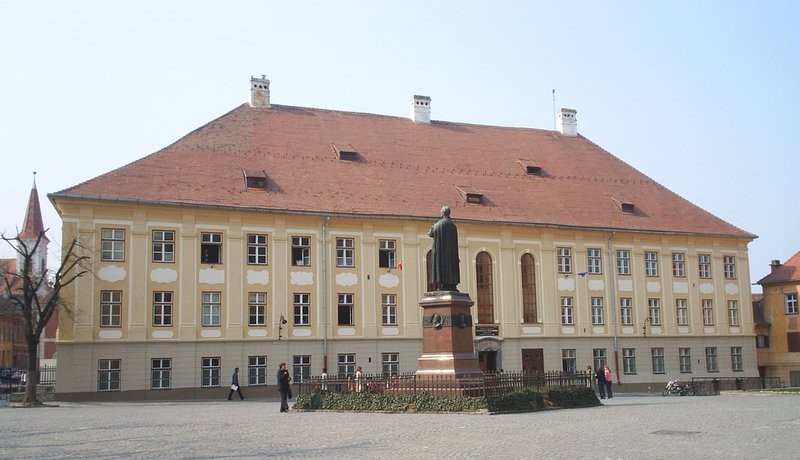
Karin1992, Public domain, via Wikimedia Commons
Show on map
Visit
Former Lutheran High School, Samuel von Brukenthal College
History
The school was built in Baroque style between 1779 and 1781 on the foundations of the old 14th century school, but was completed by 1786.
Former Craftsmen's House, Gewerbeverein Haus, Franz Binder Museum of Universal Ethnography
Muzeul de Etnografie Universală Franz Binder
Originally:
casino, library, school, commercial building
Show on map
Visit
Former Craftsmen's House, Gewerbeverein Haus, Franz Binder Museum of Universal Ethnography
History
The former Craftsmen's House (Burger- und Gewerbeverein-Haus) was built between 1865 and 1867. It was a club, library, apprentice school and exhibition space for artisans' products, before being renovated in 1989 and becoming the home of the Franz Binder Museum.
Franz Binder, a merchant, lived in Egypt for 10 years and was appointed Honorary Deputy Consul to Sudan by the Austrian Imperial Court in 1857. In 1862, he donated a collection of 500 items from the tribes along the Nile to the museums.
Former Roman Catholic Grammar School
Colegiul Național Gheorghe Lazăr
Show on map
Visit
Former Roman Catholic Grammar School
History
In 1692 the Jesuits founded the grammar school. In 1773, the grammar school was abolished together with the Jesuit order. In 1780 Emperor Joseph II approved the reorganisation of the school under the name Gymnasium regium Cibiniensis. In 1789 it moved to the former Jesuit monastery in the main square, where it remained until 1898, when it moved to its new building. The language of instruction was originally Latin, then German from 1850, Hungarian from 1868 and Romanian from 1918.
Former Theresianum Orphanage
Orfelinatul Terezian
Originally:
orphanage / children's shelter
Show on map
Visit
Former Theresianum Orphanage
History
The orphanage was built at the order of Empress Maria Theresa, at the same time as the Church of the Assumption, in Baroque style.
ASTRA Open-Air Ethnographic Museum
Muzeul civilizatiei populare, Muzeul ASTRA
Visit
ASTRA Open-Air Ethnographic Museum
History
The ASTRA Museum of Traditional Folk Culture is an open-air museum located on the outskirts of Nagyszeben.
Natural History Museum
Muzeul de Istorie Naturală
Show on map
Visit
Natural History Museum
History
The museum was founded in 1849 by the Transylvanian Natural History Society (Siebenburgischer Verein für Naturwiessenschaften). By 1895 the present museum building was completed. The more than 1,000,000 objects on display were partly collected by the museum's specialists, partly donated to the museums.
The museum was built between 1894 and 1895 in the Italian Renaissance style.
Commerce, industry, hospitality
Former Butchery, House of Arts, Emil Sigerus Museum of Saxon Ethnography
Casa Artelor,
Originally:
commercial building
Show on map
Visit
Former Butchery, House of Arts, Emil Sigerus Museum of Saxon Ethnography
History
The house was built in the 15th century. It was first a butchery, and thus took the name of the House of the Butchers. Later, the upstairs was occupird by furriers, then was used as a granary and for a short time as a performance space. During the restoration work in 1787, the building was decorated with the coat of arms of the town.
Former Land Credit Bank, Town Hall
Primăria
Show on map
Visit
Former Land Credit Bank, Town Hall
History
It was built in 1906 as the palace of the credit bank. In 1948 the town hall moved into it.
Pharmacy History Museum
Muzeul de Farmacie
Show on map
Visit
Pharmacy History Museum
History
In 1494, the first pharmacy in what is now Romania was opened in Nagyszeben, and Christian Friedrich Samuel Hahnemann (1755-1843), the German physician and founder of naturopathy, lived there. The museum is housed in a 15th century building, which has been the site of the Black Bear pharmacy since 1568. The museum was founded in 1972.
Former Hotel Römischer Kaiser
Hotel Împăratul Romanilor
Originally:
hotel / tavern / guesthouse
Currently:
hotel / tavern / guesthouse
Show on map
Visit
Former Hotel Römischer Kaiser
History
The hotel was built between 1894 and 1895 on the site of the old inn, it was designed by Friederich Maetz and hosted Liszt Ferenc in November 1846, Johann Strauss in December 1847 and Johannes Brahms in September 1879.
Former Hotel Europe
Hotel Continental Forum
Originally:
hotel / tavern / guesthouse
Currently:
hotel / tavern / guesthouse
Show on map
Visit
Former Hotel Europe
History
The hotel was built in 1914 by the Orthodox Church. From 1915 to 1923 it was known as Hotel Europa.
Town infrastructure
Council Tower
Turnul Sfatului
Originally:
municipal tower / fire tower
Currently:
municipal tower / fire tower
Show on map
Visit
Council Tower
History
According to archaeologists, the tower was built at the same time as the second defensive wall, between 1224 and 1241. On 26 April 1586, the upper floors of the tower collapsed. Over a period of two years (1586-1588), the gate tower was restored. In the 19th century, the former roof with four turrets was replaced by the present one. From its roof you can enjoy a magnificent view of the city.
Tower of the Goldsmiths' Stairway
Turnul Scării Aurarilor
Originally:
town fortification
Show on map
Visit
Tower of the Goldsmiths' Stairway
History
The arched passageway on the ground floor of the two-storey building takes to the stairs leading to the Goldsmith's Square. The upper floors have been turned into a habitation and fitted with large windows, losing their original 13th-14th century defensive role.
Town Walls
Originally:
town fortification
Currently:
town fortification
Show on map
Visit
Town Walls
History
The parish church, built on a hill in the heart of the town, was the first to be surrounded by walls reinforced with towers. By the middle of the 14th century, the upper town to the south of the old town and, in the 15th century, the lower town to the north of the old town had been fortified. According to a town plan drawn by the Italian architect Visconti in 1699, Nagyszeben was protected by 39 towers and 4 gate towers.
Stairs' Tower
Turnul Scărilor
Originally:
town fortification
Currently:
town fortification
Show on map
Visit
Stairs' Tower
History
The tower was built as part of the first fortification system in the 13th century. It took its present form in 1542. It stands at the top of the staircase connecting the upper and lower town.
Gate Tower
Originally:
town fortification
Currently:
town fortification
Show on map
Visit
Gate Tower
History
The tower was built in the 14th century and was merged with the old town hall.
Gunpowder Bastion, Smiths' Bastion
Turnul Pulberăriei
Originally:
town fortification
Currently:
town fortification
Show on map
Visit
Gunpowder Bastion, Smiths' Bastion
History
The tower was built in 1552 and was used to store gunpowder. It was part of the defence system of a nearby gate of the lower town (Shoemaker's Gate).
Tanners' Tower
Turnul Pielarilor
Originally:
town fortification
Currently:
town fortification
Show on map
Visit
Tanners' Tower
History
The tower fitted into the defensive system of a nearby gateway to the lower town.
It was built in 1457. On 31 March 1566, the gunpowder stored in the tower exploded in a great fire. It happened again on 7 September 1570. On 28 August 1638, it exploded for the third time, this time as a result of a lightning strike.
Soldisch Bastion, Soldischbastei
Bastionul Soldisch
Originally:
town fortification
Currently:
town fortification
Show on map
Visit
Soldisch Bastion, Soldischbastei
History
Armorers' Tower, Waffenschmiedturm, Weavers’ Tower
Turnul Archebuzierilor
Originally:
town fortification
Currently:
town fortification
Show on map
Visit
Armorers' Tower, Waffenschmiedturm, Weavers’ Tower
History
Built between 1357 and 1366, it was later called Weaver's Tower.
Potters' Tower, Töpferturm
Originally:
town fortification
Currently:
town fortification
Show on map
Visit
Potters' Tower, Töpferturm
History
Coopers' Tower, Binderturm
Turnul Dulgherilor
Originally:
town fortification
Currently:
town fortification
Show on map
Visit
Coopers' Tower, Binderturm
History
Thick Tower, Dicke Turm, State Philharmonics, Thalia Concert Hall
Turnul Gros, Filarmonica de Stat - Sala Thalia
Originally:
town fortification, theatre/opera
Currently:
dancing / concert hall
Show on map
Visit
Thick Tower, Dicke Turm, State Philharmonics, Thalia Concert Hall
History
The round bastion was built in 1540. It was built about 25 metres further out than the town walls. It was in this building that the printer Martin Hochmeister established the town's first German-language theatre in 1778. In the beginning it was only used for children's performances, but from 1787 onwards it was a real theatre until the fire in 1949.
Haller Bastion, Hallerbastei
Bastionul Haller
Originally:
town fortification
Currently:
town fortification
Show on map
Visit
Haller Bastion, Hallerbastei
History
The bastion was built in 1551 by the town judge Petrus Haller.
Stairs
History
The stairway creates a link between the upper and lower town. It was built in the 19th century to connect the two parts of the town.
Bridge of Liars, Liegende Brücke
Podul Minciunilor
Show on map
Visit
Bridge of Liars, Liegende Brücke
History
The oldest cast iron bridge in present day Romania. The Liegende Brücke, or Lying Bridge, was built in 1859 to replace a wooden bridge. The wooden bridge was called the Liars' Bridge because of the lies and tall tales of the market-women who sold their goods in the area. On one side is the year of construction, on the other the Saxon coat of arms. A crown above two crossed swords indicates that the Saxons recognised the sovereignty of the Hungarian king.
Private buildings
Brukenthal Palace, Brukenthal Museum and Gallery
Muzeul Național Brukenthal
Originally:
palace, gallery, museum, library
Show on map
Visit
Brukenthal Palace, Brukenthal Museum and Gallery
History
The palace was once the residence of Baron Samuel von Brukenthal, who was governor of Transylvania from 1777. Its collection is one of the richest in Romania.
The palace was built by Samuel von Brukenthal between 1778 and 1788, on the site of the medieval Klockner and Offner houses. He inaugurated his vast picture gallery in the palace in 1790, 3 years before the Louvre. The master builder was Franz Burger, the sculptor was Simon Hoffmeyer from Kolozsvár and the stone carver was Anton Hertzum. Above the gate is Brukenthal's gilded coat of arms. The gateway on the left side incorporates the gate frame of the house at number 4 Petőfi/Rét Street (Wiesengasse, Strada Tipografilor) (the so-called Hermann Wagner House) from 1552, the work of Thomas Lapicida. The winter residence of Samuel Brukenthal was on the first floor, where the drawing room, the reception room, and the guest rooms were located. The latter are covered with wallpaper imitating Chinese paintings, the music room with wood panelling and oriental floral wallpaper. Eight of the door woodcarvings depict stories from Ovid's Metamorphoses. The second floor was home to the Baron's gradually growing collection of works of art. He laid the foundations for the collection in Vienna between 1759 and 1772. By his will, the palace was declared a museum and passed to the Lutheran Church. The collection of works of art and a library of 100,000 volumes formed the basis of the museum, which opened to the public on 25 February 1817. Its paintings were evacuated to Budapest in the autumn of 1916 to escape the attack of the Romanian army, and were only returned in 1919. The museum was nationalised in 1946, and the most valuable paintings were transferred to the Art Museum in Bucharest. In 2006, the museum was returned to the Lutheran Church. Borsos Miklós (1906-1990), a sculptor, spent his childhood in the apartment overlooking the back courtyard of the palace.
August von Spiess Museum of Arms and Hunting Trophies
Muzeul de Vânătoare August von Spiess
Show on map
Visit
August von Spiess Museum of Arms and Hunting Trophies
History
The museum opened in 1966 and moved to the former villa of Colonel Spiess in 1981. Spiess was the Royal Court's gamekeeper for many years. The museum was based on his collection of hunting weapons, domestic and exotic trophies, traps and photographs.
Müller House
Show on map
Visit
Müller House
History
At the end of the 18th century, this house was the home of Franz Josef Müller, the discoverer of tellurium, who was born in Poysdorf, Austria. Müller was chief inspector of the Transylvanian mines from 1775 and moved to Szeben at the invitation of Baron Brukenthal and with the recomendation of the Viennese court to carry out his research. Here he discovered the new element in 1782.
A mineral called nagyágit, a sulphide containing gold, lead, antimony and tellurium, is named after the village of Nagyág in the Transylvanian Ore Mountains. This is the mineral in which Müller discovered the chemical element tellurium.
House with Caryatides, House of Bethlen Gergelyné
Casa cu Cariatide
Show on map
Visit
House with Caryatides, House of Bethlen Gergelyné
History
The widow of Bethlen Gergely built her late Baroque house in 1786, after the settlement of other nationalities (not Saxons) in the town was allowed by decree of Emberor Joseph II in 1781. The two huge caryatids (female figures used instead of columns) supporting the wrought-iron balustrade balcony that gives the house its name were probably made in Simon Hoffmayer's workshop.
Luxemburg House
Casa Luxemburg
Currently:
hotel / tavern / guesthouse
Show on map
Visit
Luxemburg House
History
The lower three floors were built in the 15th century, while the mansard was built in the 18th century. In 2005, the building was officially named Luxembourg House when the Archduke of Luxembourg and his wife visited it.
Museums and Galleries
Former Butchery, House of Arts, Emil Sigerus Museum of Saxon Ethnography
Casa Artelor,
Originally:
commercial building
Show on map
Visit
Former Butchery, House of Arts, Emil Sigerus Museum of Saxon Ethnography
History
The house was built in the 15th century. It was first a butchery, and thus took the name of the House of the Butchers. Later, the upstairs was occupird by furriers, then was used as a granary and for a short time as a performance space. During the restoration work in 1787, the building was decorated with the coat of arms of the town.
Former Town Hall, Museum of History
Casa Altemberger - Muzeul de Istorie
Show on map
Visit
Former Town Hall, Museum of History
History
The building was built between 1470 and 1491 under Thomas Altemberger. In 1545 it became the property of the town and was converted into a town hall. The Latin inscription above the door commemorates the visit of Emperor Joseph II. Later, two wings were added to the building. In 1948, the town hall moved to a new building. The old town hall was renovated between 1967 and 1984 and became the seat of the History Museum.
Brukenthal Palace, Brukenthal Museum and Gallery
Muzeul Național Brukenthal
Originally:
palace, gallery, museum, library
Show on map
Visit
Brukenthal Palace, Brukenthal Museum and Gallery
History
The palace was once the residence of Baron Samuel von Brukenthal, who was governor of Transylvania from 1777. Its collection is one of the richest in Romania.
The palace was built by Samuel von Brukenthal between 1778 and 1788, on the site of the medieval Klockner and Offner houses. He inaugurated his vast picture gallery in the palace in 1790, 3 years before the Louvre. The master builder was Franz Burger, the sculptor was Simon Hoffmeyer from Kolozsvár and the stone carver was Anton Hertzum. Above the gate is Brukenthal's gilded coat of arms. The gateway on the left side incorporates the gate frame of the house at number 4 Petőfi/Rét Street (Wiesengasse, Strada Tipografilor) (the so-called Hermann Wagner House) from 1552, the work of Thomas Lapicida. The winter residence of Samuel Brukenthal was on the first floor, where the drawing room, the reception room, and the guest rooms were located. The latter are covered with wallpaper imitating Chinese paintings, the music room with wood panelling and oriental floral wallpaper. Eight of the door woodcarvings depict stories from Ovid's Metamorphoses. The second floor was home to the Baron's gradually growing collection of works of art. He laid the foundations for the collection in Vienna between 1759 and 1772. By his will, the palace was declared a museum and passed to the Lutheran Church. The collection of works of art and a library of 100,000 volumes formed the basis of the museum, which opened to the public on 25 February 1817. Its paintings were evacuated to Budapest in the autumn of 1916 to escape the attack of the Romanian army, and were only returned in 1919. The museum was nationalised in 1946, and the most valuable paintings were transferred to the Art Museum in Bucharest. In 2006, the museum was returned to the Lutheran Church. Borsos Miklós (1906-1990), a sculptor, spent his childhood in the apartment overlooking the back courtyard of the palace.
August von Spiess Museum of Arms and Hunting Trophies
Muzeul de Vânătoare August von Spiess
Show on map
Visit
August von Spiess Museum of Arms and Hunting Trophies
History
The museum opened in 1966 and moved to the former villa of Colonel Spiess in 1981. Spiess was the Royal Court's gamekeeper for many years. The museum was based on his collection of hunting weapons, domestic and exotic trophies, traps and photographs.
Pharmacy History Museum
Muzeul de Farmacie
Show on map
Visit
Pharmacy History Museum
History
In 1494, the first pharmacy in what is now Romania was opened in Nagyszeben, and Christian Friedrich Samuel Hahnemann (1755-1843), the German physician and founder of naturopathy, lived there. The museum is housed in a 15th century building, which has been the site of the Black Bear pharmacy since 1568. The museum was founded in 1972.
Former Craftsmen's House, Gewerbeverein Haus, Franz Binder Museum of Universal Ethnography
Muzeul de Etnografie Universală Franz Binder
Originally:
casino, library, school, commercial building
Show on map
Visit
Former Craftsmen's House, Gewerbeverein Haus, Franz Binder Museum of Universal Ethnography
History
The former Craftsmen's House (Burger- und Gewerbeverein-Haus) was built between 1865 and 1867. It was a club, library, apprentice school and exhibition space for artisans' products, before being renovated in 1989 and becoming the home of the Franz Binder Museum.
Franz Binder, a merchant, lived in Egypt for 10 years and was appointed Honorary Deputy Consul to Sudan by the Austrian Imperial Court in 1857. In 1862, he donated a collection of 500 items from the tribes along the Nile to the museums.
ASTRA Open-Air Ethnographic Museum
Muzeul civilizatiei populare, Muzeul ASTRA
Visit
ASTRA Open-Air Ethnographic Museum
History
The ASTRA Museum of Traditional Folk Culture is an open-air museum located on the outskirts of Nagyszeben.
Natural History Museum
Muzeul de Istorie Naturală
Show on map
Visit
Natural History Museum
History
The museum was founded in 1849 by the Transylvanian Natural History Society (Siebenburgischer Verein für Naturwiessenschaften). By 1895 the present museum building was completed. The more than 1,000,000 objects on display were partly collected by the museum's specialists, partly donated to the museums.
The museum was built between 1894 and 1895 in the Italian Renaissance style.
{"item":"town","set":{"mapcenter":{"lat":"45.7980680000","long":"24.1514180000"},"townlink":"nagyszeben-sibiu","town":{"townId":75,"active":1,"name_HU":"Nagyszeben","name_LO":"Sibiu","name_GE":"Hermannstadt","name_LT":"Cibinium","seolink":"nagyszeben-sibiu","listorder":12,"oldcounty":36,"country":4,"division":21,"altitude":"431","gps_lat":"45.7980680000","gps_long":"24.1514180000","population":147,"hungarian_2011":1.47,"population_1910":38061,"hungarian_1910":19.17,"german_1910":52.59,"slovak_1910":0,"romanian_1910":26.6,"rusin_1910":0,"serbian_1910":0,"croatian_1910":0,"slovenian_1910":0,"coatofarms":"","coatofarms_ref":"","picture":"\u003Ca title=\u0022Dan Tiganila, CC BY-SA 3.0 RO \u003Chttps:\/\/creativecommons.org\/licenses\/by-sa\/3.0\/ro\/deed.en\u003E, via Wikimedia Commons\u0022 href=\u0022https:\/\/commons.wikimedia.org\/wiki\/File:Piata_Mica_si_Turnul_Sfatului.jpg\u0022\u003E\u003Cimg width=\u0022512\u0022 alt=\u0022Piata Mica si Turnul Sfatului\u0022 src=\u0022https:\/\/upload.wikimedia.org\/wikipedia\/commons\/thumb\/4\/4b\/Piata_Mica_si_Turnul_Sfatului.jpg\/512px-Piata_Mica_si_Turnul_Sfatului.jpg\u0022\u003E\u003C\/a\u003E","picture_ref":"\u003Ca href=\u0022https:\/\/commons.wikimedia.org\/wiki\/File:Piata_Mica_si_Turnul_Sfatului.jpg\u0022\u003EDan Tiganila\u003C\/a\u003E, \u003Ca href=\u0022https:\/\/creativecommons.org\/licenses\/by-sa\/3.0\/ro\/deed.en\u0022\u003ECC BY-SA 3.0 RO\u003C\/a\u003E, via Wikimedia Commons","georegion":"Szeben Basin, Sz\u00e1szf\u00f6ld","river":"Szeben","description":"The town was founded in the 12th century by King G\u00e9za II of Hungary, who settled Germans here to protect the V\u00f6r\u00f6storony Pass after the Sz\u00e9kelys had been moved to present-day Sz\u00e9kelyf\u00f6ld. The Transylvanian Saxons, as the German settlers were uniformly called, owed their extensive freedoms and autonomy to King Andrew II of Hungary. Until the 15th century, the provostry of Szeben was the Catholic ecclesiastical centre of the Transylvanian Saxons. The town soon became the commercial and spiritual centre of the Transylvanian Saxons. The head of the Saxons was the Count of Szeben, confirmed by the Hungarian king. King Charles I abolished the authority of the Count of Szeben and divided the Saxons' land (called King's land) into seats, the administration of which was entrusted to a royal judge appointed by the king. The town became the centre of Szeben Seat and a free royal town. The fortification of the town was carried out in several stages from the 13th to the 15th century. It was the most important Saxon town of the seven towns after which Transylvania got its German name Siebenb\u00fcrgen. The town got rich from trade between Hungary and Wallachia. King Matthias of Hungary strengthened the autonomy of the Saxons, and the Transylvanian Saxon University was established, the self-governing body of the Transylvanian Saxons, which was subordinate to the king alone. The Count of the Saxons was elected by the Saxons from among the 12 members of the Szeben Town Council. The Saxons were to be judged exclusively by the Saxon University, and the official language was German. The Saxons converted to Lutheranism during the Reformation. From the 16th century onwards, the Saxons generally supported the Habsburgs against the Hungarians, despite the fact that most of the time they received only strong centralisation and violent recatholization in return, with the exception of their mostly loyal attitude towards the Principality of Transylvania, which had guaranteed their religious freedom and autonomy. For a long time after the Habsburg occupation of Transylvania in the 18th century, it was the seat of the Transylvanian provincial government. After the suppression of the Hungarian War of Independence in 1849, the Habsburg court abolished the autonomy of the Transylvanian Saxons who had supported them during the war. This was later restored, but was finally abolished with the modernisation of the public administration after the Austro-Hungarian Compromise. The fate of the Transylvanian Saxons was brought about by the Romanian occupation, after which the vast estates of the Saxon University were confiscated. The majority of the Saxons, who had been left in a hopeless situation, emigrated to Germany in exchange for ransom during the Ceau\u0219escu era.","nameorigin":"","history":"#1|@after 895|After the Hungarians arrived in Transylvania, Sz\u00e9kelys settled in the area.@#3|@1141-1161|During the reign of King G\u00e9za II of Hungary, German, Flemish and in smaller numbers also Walloon settlers arrived in southern Transylvania. The settlers probably came after the second crusade crossed Hungary in 1147. People who couldn\u2019t count on inheriting land in their homeland came from the territory of the dioceses of Cologne and Trier. They were granted new home in Hungary on lands that had recently become desolate after the Sz\u00e9kely border guards living there had been relocated to the area of H\u00e1romsz\u00e9k by order of the king. These settlers were later called collectively Saxons, which does not mean that they came from Saxony.@around 1147|The town was established by King G\u00e9za II of Hungary, who invited Germans settlers to defend the V\u00f6r\u00f6storony (Red Tower) Pass, after he relocated the Sz\u00e9kelys. The town was named after the Szeben Stream, which might come from the Slavic svbina noun meaning cornel. According to others, the town\u2019s name comes from the Turkic personal name Sebin.@1191|The town was mentioned for the first time as Cipin, when the Pope confirmed the establishment of the provostry of Nagyszeben. It was the Catholic church centre of the Transylvanian Saxons until the 15th century. The town soon became the trade and intellectual centre of the Transylvanian Saxons. Szeben was a free royal town and the centre of the Seat of Szeben (Szebensz\u00e9k). Seats were the special administrative units of the Saxons.@1223|The town was called Villa Hermanni. The German name of the town, Hermannstadt, was used for the first time in 1366, but it already appeared in the form of Hermannsdorf in 1321. Its origin is uncertain. The town was either named after Bishop Hermann II of Cologne or Hermann of Nuremberg, who was the founder of the town according to the tradition.@1224|King Andrew II of Hungary issued the Andreanum, the golden charter of freedoms of the Transylvanian Saxons (goldener Freibrief). This recognized the Saxons as collective legal entity, removed them from the jurisdiction of the royal isp\u00e1ns (the leaders of the counties), and placed the newly appointed isp\u00e1n of Szeben over them. The territory inhabited by the Saxons became their own property, and they were legally equal. If the owner of the land died without inheritors, the property reverted to the community and not the king. The Saxons elected their own superiors and priests. Their leader, the isp\u00e1n of Szeben, also called Count of the Saxons (comes Saxonum), was appointed by the king, but after 1486 they could choose the count themselves. Saxons were allowed to hold fairs and trade freely. Their land was called King's Land (Kir\u00e1lyf\u00f6ld, Fundus Regius, K\u00f6nigsboden). Saxons had the most rights in Hungary, they were actually exempted from feudalism. King's Land stretched from Sz\u00e1szv\u00e1ros to Bar\u00f3t.@#5|@1241|The Mongol army of Bogutaj that broke into Hungary through the Ojtoz Pass plundered the settlement, which was only weekly defended with a palisade. The houses were burned and the inhabitants were slaughtered. After the Mongol invasion, the settlement was quickly repopulated, and, thanks to the privileges granted by the king, rapidly developed and was granted town status already in the 13th century. The parish church was built on the hummock in the heart of the settlement at that time, which was encircled by walls with towers. In addition to this, the upper town was fortified by the middle of the 14th century, and the fortification of the lower town was completed in the 15th century. Later a natural line of defence consisting of small lakes was also created beyond the third ring of walls from the surrounding marshlands and one of the distributaries of the Szeben Stream.@#6|@14th century|Szeben was the most important of the seven Saxon towns, which gave Transylvania its German name Siebenb\u00fcrgen. The town already had 19 guilds and it was engaged in extensive trade primarily with Wallachia outside Hungary, but its products reached also Western Europe. The rapidly accumulating wealth of the town made possible the constant improvement of its defences.@1324|King Charles I of Hungary abolished the authority of the isp\u00e1n of Szeben having too much power by dividing the province into Saxon seats led by royal judges assigned by the king.@1432|The Turkish army of Bey Ali crossed the Danube at Nicopolis and broke into Transylvania together with the army of Voivode Vlad Dracul of Wallachia, who became a traitor. They plundered the Barcas\u00e1g and also the lands of the Sz\u00e9kelys and the Saxons enslaving many people. They besieged Nagyszeben and Brass\u00f3, but both towns resisted successfully. Finally, the rapidly raised army of the Hungarian nobility drove them out of Hungary causing heavy casualties to the army of Bey Ali. In the meantime, the army of Vlad Dracul of Wallachia captured Sz\u00f6r\u00e9ny Castle from Redwitz Mikl\u00f3s and slaughtered the German knights that defended the castle, which ceased to be the bastion of Western Christianity.@1437|The three nations of Transylvania (the Hungarian nobility, the Sz\u00e9kelys and the Saxons) formed an alliance in K\u00e1polna (Union of K\u00e1polna). This union gained its true significance after 1570, when Transylvania became an independent principality due to the Turkish conquest of central Hungary. These three nations were represented in the Transylvanian Diet, and they elected the prince. Vlach migrants (mostly shepherds and peasants) were a small minority at the time and were excluded from the political power just like Hungarian peasants. According to the agreement, the Saxon fortified churches were opened for the non-Saxon population of the neighbourhood as well in times of danger. This was a great concession, because only Saxons (and not even Hungarian nobles) could acquire land and purchase house in King's Land. Only Saxon monks could live in their monasteries and Saxons were strictly forbidden by their priests to adopt Hungarian customs, dress and hairstyle. The Transylvanian Saxons were never integrated into the Hungarian community that welcomed them and gave them so many privileges, and they never had any inclination to do so.@1438|The Turks attacked Szeben unsuccessfully. Sultan Murad II sent an army of raiders against Hungary under the command of Bey Ali. The Turks were aided by the Vlach army of Voivode Vlad Drakul of Wallachia. They crossed the Danube at Sz\u00f6r\u00e9ny Castle. They captured Medgyes with an assault, but Szeben resisted the siege. Finally, they burned the outskirts of Brass\u00f3 and left Hungary through the T\u00f6rcsv\u00e1r Pass.@1442|Bey Mezid broke into Transylvania with an army of 30.000.@March 18, 1442|Hunyadi J\u00e1nos with his army of 10 thousand took on a battle with the three times larger army of Bey Mezid at Marosszentimre. After the first successes, the Turks finally gained victory. Bishop L\u00e9pes Gy\u00f6rgy of Transylvania fell in the battle and Hunyadi retreated to Gyulafeh\u00e9rv\u00e1r. The Turks, hungry for the big booty, besieged the Saxon town of Nagyszeben, which repelled their attack.@March 25, 1442|Hunyadi J\u00e1nos crushed the Turkis army of Bey Mezid on the plain next to Nagyszeben. The Turks wanted to achieve victory by killing Hunyadi, who was informed of this. The hero Kem\u00e9ny Simon put on the ornate armour of Hunyadi voluntarily. The Turks assaulted him with full force and killed him. But their delight didn\u2019t last long as they noticed that in the meantime the real Hunyadi captured their camp and encircled them. 20.000 Turks fell in the battle including Bey Mezid. After that, Hunyadi defeated Beylerbey Sehabeddin of Rumelia in July next to the Iron Gates gorge. These victories brought Hunyadi the fame as Turk-beater.@#7|@15th century|The lower town was fortified with walls due to the Turkish threat. With its area of 75 hectares, Szeben was the largest town fortification in Transylvania. It had 40 bastions.@1486|King Matthias of Hungary confirmed the autonomy of the Saxons. The Transylvanian Saxon Universality (universitas saxonum) was established, which was the official body of self-governance of the Saxons. It had administrative, legislative and judicial powers and was only subordinate to the King of Hungary. Saxons could only be judged by the Saxon Universality. It had the right to elect the Count of the Saxons from among the 12 members of the town council of Nagyszeben. The official language of the Saxon Universality was German, while the official language of Hungary was Latin.@#8|@after 1526|After the battle of Moh\u00e1cs, Szeben supported King Ferdinand I against King John I. King John I held the town under siege for two years unsuccessfully. Later Balassa, then Majl\u00e1th took command of the siege. The Saxons finally surrendered in 1536 on condition that they can keep their privileges.@1529|The first printing press of Transylvania was established in the town.@#9|@16th century|The town was one of the centres of Reformation in Transylvania.@1556|Fire devastated the town. Two of the towers in which gunpowder was stored exploded. The explosions seriously damaged the walls, the defences and the houses. In autumn, the Saxons of Szeben rose up and killed royal judge Johannes Roth, because they thought that he endangered their autonomy and their privileges. Another fire devastated the town one and a half decades later, when towers used for storing gunpowder exploded again.@#10|@#12|@#13|@#14|@December 11, 1610|Prince B\u00e1thory G\u00e1bor of Transylvania occupied Szeben with a trick during the country assembly gathered here. The prince himself stood on the drawbridge so that the guards wouldn\u2019t dare to raise it even when they saw the soldiers coming out of the bushes where they were hiding. The soldiers marched into the town in front of the prince like it was just a military drill. The protesting town was forced to pay a large tribute and its Saxon burghers had to participate in the campaign against Voivode Radu Serban of Wallachia. The violent and immoral prince was replaced by Bethlen G\u00e1bor in 1613 with Turkish help. The fallen prince was willing to hand over V\u00e1rad, the most important border fortress of Transylvania, to the Turks just to keep the throne, but the hajd\u00fa warriors murdered him on 27 October, 1613.@1613|At the beginning of his rule, Prince Bethlen G\u00e1bor was planning to keep the town of Nagyszeben occupied by B\u00e1thory G\u00e1bor, but not wanting to risk the union of the three nations threatened by the protest of the Saxon towns, he finally gave back Nagyszeben to the Saxons in 1614.@#15|@#16|@#17|@#18|@1657|Prince R\u00e1k\u00f3czi Gy\u00f6rgy II of Transylvania launched a campaign for the crown of Poland in alliance with Carl X Gustaf of Sweden. His aim was to unite the Hungarian-Polish-Wallachian forces against the Turks. The campaign started successfully with the prince taking Krak\u00f3w and Warsawa, but then the King of Sweden abandoned him. The vengeful Poles invaded northern Transylvania, burning defenceless villages, destroying churches and castles. Soon the punitive campaign of Turkish and Tatar armies devastated Transylvania, as the prince launched his Polish campaign against the Sultan's will.@1658|The Tartars ravaged and plundered throughout Transylvania and Grand Vizier K\u00f6pr\u00fcl\u00fc Mehmed captured Jen\u0151 Castle. The Estates of Transylvania sent Barcsay \u00c1kos to the camp of the grand vizier to beg for mercy. In return, the Grand Vizier demanded that the annual tax be raised from 15 to 40 thousand forints (gold coins) and that Lugos and Karansebes be ceded. This was the price for the Turks to leave Transylvania. The grand vizier appointed Barcsay prince on 14 September.@August 30, 1658|Tatars plundered the town during the retaliatory campaign of grand vizier K\u00f6pr\u00fcl\u00fc Mehmed.@1659|Prince R\u00e1k\u00f3czi Gy\u00f6rgy II returned to Transylvania and forced Barcsay \u00c1kos to retreat to Szeben and besieged him. R\u00e1k\u00f3czi lifted the siege and retreated, when he was informed of the approaching Turkish army sent to help Barcsay.@May 22, 1660|In the battle of S\u00e1szfenes, Pasha Shejdi Ahmed of Buda defeated R\u00e1k\u00f3czi Gy\u00f6rgy II. R\u00e1k\u00f3czi died from his wound in V\u00e1rad on 7 June, 1600. The Tatar armies invaded Transylvania for the second time.@December 31, 1660|Barcsay \u00c1kos renounced the throne of Transylvania after the army of his brother, G\u00e1sp\u00e1r, was defeated by Kem\u00e9ny J\u00e1nos, the former commander of Prince R\u00e1k\u00f3czi Gy\u00f6rgy II. In 1661, Kem\u00e9ny J\u00e1nos captured Barcsay \u00c1kos and had him assassinated.@1661|The army of Pasha Seydi Ahmed of Buda marched into Transylvania, after the country assembly held in Beszterce on 23 April declared the independence of Transylvania from the Ottoman Empire and placed the country under the protection of Emperor Leopold I. On 14 September, Pasha Ali forced the country assembly to elect Apafi Mih\u00e1ly Prince of Transylvania in Marosv\u00e1s\u00e1rhely.@January 23, 1662|The deposed prince Kem\u00e9ny J\u00e1nos, having been abandoned by his imperial allies, was defeated by the Turks at Nagysz\u0151l\u0151s (near Segesv\u00e1r), where he fell.@#23|@#25|@May 9, 1688|After most of Hungary was liberated from the Turks, General Caraffa, the commander of the imperial forces in Transylvania, made Prince Apafi Mih\u00e1ly and the Estates of Transylvania accept and sign the so called Declaration of Fogaras in Szeben. This annulled the Turkish patronage over Transylvania, which became part of the Kingdom of Hungary again and the authority of Emperor Leopold I as King of Hungary was extended over Transylvania.@August 21, 1690|Th\u00f6k\u00f6ly Imre, the former leader of the anti-Habsburg Hungarian kuruc uprising, crossed the mountains with Turkish and Wallachian auxiliaries, attacked the imperial army of General Heisler from behind and defeated him.@September 21, 1690|The nobility of Transylvania joined Th\u00f6k\u00f6ly Imre and he was elected Prince of Transylvania in Szeben. Soon the combined armies of Castelli and Heisler pushed him out of Transylvania.@#26|@1699|39 towers and 4 gate towers protected Szeben.@from the early 18th century|The Saxon villages that were left desolate by the wars were repopulated by Vlach migrants from Wallachia. Vlachs appeared in the Saxon towns as well. This was the start of the process by the end of which Vlachs were in the majority in Transylvania instead of Hungarians.@#27|@1703|During the Hungarian War of Independence of R\u00e1k\u00f3czi Ferenc II, the imperial General Rabutin moved the seat of the government of Transylvania (Gubernium) from Gyulafeh\u00e9rv\u00e1r to Szeben.@from 1703 to 1719 and from 1732 to 1791|Szeben was the seat of the government of Transylvania (F\u0151korm\u00e1nysz\u00e9k, Gubernium). Kolozsv\u00e1r was the seat of the government from 1719 to1732 and from 1791 again.@1781|The decree of Emperor Joseph II introduced \u0022concivility\u0022, which allowed non-Saxons to settle and acquire property in King's Land.@1783|Emperor Joseph II abolished the Transylvanian Saxon Universality and the Saxon seats (traditional administrative units) were incorporated into the new county system. Joseph II, who was never crowned King of Hungary, thus he was called \u2019the king in hat\u2019, made German the official language of Hungary instead of Latin, which the Saxons protested against together with the Hungarian Estates.@1790|When Emperor Joseph II, the \u2019enlightened\u2019 absolute ruler of Hungary died, bonfires were lit throughout Transylvania and Hungarians and Saxons celebrated the repeal of his decrees as one. The Transylvanian Saxon Universality was restored, but the \u0022concivility\u0022, the decree that allowed non-Saxons to settle in the land of the Saxons was not withdrawn.@#28|@1848|The Transylvanian Saxons also voted in favour of the reunion with Hungary. However, during the Hungarian War of Independence, they supported the Habsburgs because of their German national consciousness and their loyalty to the Emperor.@1848-49|Szeben was the centre of the imperial forces during the Hungarian War of Independence. General Bem J\u00f3zsef attacked Szeben for the first time at the end of 1848, but he had to lift the siege after two months on 21 January 1849.@March 11, 1849|The Hungarian army of General Bem J\u00f3zsef appeared at the gates of Nagyszeben and captured the town after a few days of siege from its Russian and Austrian defenders. Previously Bem managed to break out of Segesv\u00e1r encircled by the imperial army of General Puchner. The panoramic picture Transylvanian Panorama depicted the battle of Nagyszeben. The painting ordered by the Hungarian B\u00e1nffy government was made by Jan Styka in 1897. Sorrowfully, most of the painting has been lost.@August 5, 1849|In the battle of Nagycs\u0171r, General Bem defeated the Russian garrison of Nagyszeben led by General Hasford and captured the town again.@August 6, 1849|The Russian army of General L\u00fcderz arrived to help out Hasford, and they defeated the Hungarian army of General Bem J\u00f3zsef, who waited for the reinforcement of General Stein from Gyulafeh\u00e9rv\u00e1r in vain. During the street fights one of the citizens of Nagyszeben attempted to assassinate General Bem, but his secretary Major Anton Kurz was shot to death instead. Bem retreated towards Sz\u00e1szsebes, where he united with the army of Stein, who was also defeated by General L\u00fcderz in Sz\u00e1szsebes on 12 August.@after 1849|After the fall of the Hungarian War of Independence, the Saxons\u2019 reward for supporting the Habsburgs against Hungary was that the Habsburg emperor abolished their autonomy and incorporated King's Land into the new centralized administrative system controlled from Vienna. The Count of the Saxons was removed, the locally elected magistrates were replaced by centrally assigned clerks and the Saxons lost their control over the judicial system as well.@1861|The October Diploma issued by Emperor Franz Joseph eased the absolutism and restored the autonomy of the Saxons. The old administrative system of King's Land was restored and the seat of Sz\u00e1szv\u00e1ros (Sz\u00e1szv\u00e1rossz\u00e9k) was resurrected for one and a half decades.@#30|@between 1849 and 1865|Nagyszeben was the capitol of Transylvania.@19th century|The gates of the town were demolished one by one, but most of its walls and towers have been preserved.@1876|Public administration was modernized and medieval structures were abolished in Hungary. The autonomy of the Saxons was abolished (as was that of the Hungarian Sz\u00e9kelys) and their seats were incorporated into the county system. King's Land had already lost its Saxon homogeneity (which was mainly due to low Saxon fertility) by that time making territorial autonomy redundant.@1876|With the administrative modernization of Hungary, the Saxon autonomy was abolished and King's Land was also incorporated into the uniform county system. The former territory of the Seat of Szeben was incorporated into Szeben County. Nagyszeben became the seat of the county.@after 1876|The Saxon Universality was transformed into a foundation to foster culture and education.@#31|@1916|On 27 August, Romania declared war on the Austro-Hungarian Monarchy and launched an attack against Hungary. This triggered a huge wave of refugees from Transylvania, as the population feared a repeat of the Romanian ethnic cleansing of 1848-49. The Saxon Arthur Arz von Straussenberg led the defence of Transylvania until the arrival of German reinforcement. Austro-Hungarian and German forces drove the invaders out of the country by mid-October and occupied Bucharest on 6 December. Romania surrendered and signed a peace treaty with the central powers on 7 May 1918 (Treaty of Bucharest).@1916|The Romanian army occupied Nagyszeben with a hard siege, but the Austro-Hungarian and German armies took back the town in the autumn with another hard siege.@1918|On 3 November, the Austro-Hungarian Monarchy signed the Armistice of Padua. The already defeated Romania then declared war on Germany on 10 November, just one day before the Germans signed the armistice near Compi\u00e8gne. The Romanians then launched an offensive against Hungary, which had already unconditionally ceased fighting at the demand of the Entente. Romania was only recognised by the Entente powers as one of the victors of WWI only later.@#32|@January 8, 1919|In the shadow of Romanian occupation, the assembly of the Saxon delegates in Medgyes accepted the union with Romania with the promise of the restoration of Saxon autonomy. In 1910 only 231,000 Saxons lived in Transylvania.@#36|@1923|The Romanian government abolished all what remained of the Saxon autonomy. The vast estates of the Saxon Universality were confiscated, just like the lands of the Hungarian nobility and the historical churches, which almost exclusively financed Hungarian and Saxon education systems in Transylvania. Once again, Saxons were rewarded for betraying Hungary, though it depended by no means on their decision that Transylvania was united with Wallachia and Moldova, which was a decision similar to uniting Switzerland with Nigeria.@until 1941|As a result of the Romanian settlements, the Saxons lost their majority in every town. In desperation, the Saxons joined the SS en masse.@1944|The German high command ordered the evacuation of King's Land, just like East Prussia, but the majority stayed in their homeland. Romania betrayed their allies and sided with the Soviet Union, as soon as the first Soviet forces reached their eastern borders. After that, Saxons were also obliged to enlist in the Romanian army. Soviets despised the traitors, so they sent the Romanians to the front line to catch the bullet, which meant that Saxons had to fight against Saxons.@1950s|Illegal emigration to Germany began with the bribery of state employees. The Romanian secret service, the Securitate and the Directorate for Foreign Intelligence (DIE) became aware of the process and wanted to turn it to their own advantage.@from 1962|The state-coordinated sale of German nationalities in Romania has been launched. The so called \u2019products\u2019 were divided into four categories with different prices. For example West Germany had to pay 11,000 marks for a highly qualified person, while a student could be ransomed for only 1,800 marks.@from 1970|Romania made the process more democratic, because the FRG had to pay a uniform 8,000 marks for each German. This was the price of the one-way visa to West Germany.@from 1982|The price increased, because West Germany had to reimburse also the money the high quality education system of Romania spent on the German people wishing to leave the country. Moreover, the emigrants had to sign a declaration that they would leave their assets to the Romanian state. West Germany was allowed to pay in kind as well. For example, when the Germans said that they could only supply Volkswagen cars, the Romanians said that they would prefer Mercedes cars, but were willing to wait.@until 1990|Approximately 250 to 400 thousand Germans were ransomed to West Germany together with the Swabians that lived in the B\u00e1ns\u00e1g (Banat). Seeing the success of the deal, the Romanians also started selling Jews to Israel, and eventually they sold literally anyone, who had someone to pay the ransom.@1991-1992|With the opening of the borders, 75,000 of the remaining 95,000 Transylvanian Saxons emigrated to Germany voluntarily, leaving ghost villages behind. Those few that remained became more Romanian than Romanians, just as the example of the \u2019liberal\u2019 President of Romania, Klaus Iohannis shows, who took political advantage by accusing the \u2019social democrats\u2019 of wanting to hand over Transylvania to the Hungarians. This describes political conditions in Romania and the mental state of an average Romanian quite well.@2002|7.2 million people lived in Transylvania, including 1.42 million Hungarians. There were 1.65 million Hungarians out of 5.2 million in 1910. The proportion of the Romanians increased from 53.78% to 74.69%, while the proportion of the Hungarians decreased from 31.64% to 19.6%. The proportion of the Germans dropped from 10.75% to below 1%. These changes were mainly the results of migration and the persecution of Hungarians and Saxons. Transylvania here refers to the entire territory that once belonged to Hungary, which is much larger than historical Transylvania.@2007|Nagyszeben became the European Capital of Culture together with Luxembourg, because the local Saxons came from the territory of Luxembourg. The squares and museums of the town were renovated. The 18th century theatre became a cultural centre, where the local philharmony is also located. The wine region of Szeben yielded very well already in the 10th century. But loose soil made the harvest difficult. They employed beasts of burden, which made the harvest easier and more efficient. This method was unique in the world for a long time. The wine of the region is still called Szeben wine of burden.&latvany-terkep.hu: Nagyszeben t\u00f6rt\u00e9nete \u00e9s l\u00e1tv\u00e1nyt\u00e9rk\u00e9pe|https:\/\/www.latvany-terkep.hu\/magyar\/oldalak\/nagyszeben_tortenete_es_latvanyterkepe\/\nerdelyinaplo.ro: Ellenfelei letasz\u00edtott\u00e1k a tr\u00f3nr\u00f3l B\u00e1thory G\u00e1bort|https:\/\/erdelyinaplo.ro\/elo-emlekezet\/ellenfelei-letaszitottak-a-tronrol-bathory-gabort\npangea.blog.hu: Az erd\u00e9lyi sz\u00e1sz etnikai t\u00e9rszerkezet kialakul\u00e1sa|https:\/\/pangea.blog.hu\/2014\/12\/03\/erdelyi_szasz_etnikai_terszerkezet_kialakulasa\npangea.blog.hu: Az erd\u00e9lyi sz\u00e1sz etnikai t\u00e9rszerkezet megsemmis\u00fcl\u00e9se|https:\/\/pangea.blog.hu\/2014\/12\/31\/az_erdelyi_szasz_etnikai_terszerkezet_megsemmisulese"},"sights":[{"sightId":1910,"townId":75,"active":2,"name_LO":"Catedrala Evanghelic\u0103 C.A. Sf\u00e2nta Maria","address":"Pia\u021ba Albert Huet","mapdata":"1|1493|1788","gps_lat":"45.7977677308","gps_long":"24.1501111385","religion":3,"oldtype":"1","newtype":"1","homepage":"","openinghours":"","muemlekemlink":"","csemadoklink":"","picture":"\u003Ca title=\u0022Rdiana.cris, CC BY-SA 4.0 \u003Chttps:\/\/creativecommons.org\/licenses\/by-sa\/4.0\u003E, via Wikimedia Commons\u0022 href=\u0022https:\/\/commons.wikimedia.org\/wiki\/File:Catedrala_Evanghelic%C4%83_Sibiu.jpg\u0022\u003E\u003Cimg width=\u0022512\u0022 alt=\u0022Catedrala Evanghelic\u0103 Sibiu\u0022 src=\u0022https:\/\/upload.wikimedia.org\/wikipedia\/commons\/thumb\/0\/05\/Catedrala_Evanghelic%C4%83_Sibiu.jpg\/512px-Catedrala_Evanghelic%C4%83_Sibiu.jpg\u0022\u003E\u003C\/a\u003E","picture_ref":"\u003Ca href=\u0022https:\/\/commons.wikimedia.org\/wiki\/File:Catedrala_Evanghelic%C4%83_Sibiu.jpg\u0022\u003ERdiana.cris\u003C\/a\u003E, \u003Ca href=\u0022https:\/\/creativecommons.org\/licenses\/by-sa\/4.0\u0022\u003ECC BY-SA 4.0\u003C\/a\u003E, via Wikimedia Commons","name":"Lutheran Cathedral","seolink":"lutheran-cathedral","note":"","history":"The church was built in the 14th century, and the construction of its 73-metre tower was begun in 1371. Its reconstruction was completed in 1520. It became a Lutheran church after the Reformation and was restored in 1855. In front of it stands a statue of the Saxon Lutheran bishop Georg Daniel Teutsch.@\nFor the roof over the crossing and the south transept, trees felled between 1351 and 1353 were used, while for the nave roof, trees felled between 1362 and 1354 were used. At the end of the 14th century, the sanctuary was given a new roof and a longitudinal brace was built into all the standing structures using pine trees felled between 1393 and 1397. The roof structure of the vestibule west of the tower was made of pine trees felled in winter between 1458 and 1459, and that of the southern aisle between 1517 and 1518.@\nThe bronze baptismal font was made by Master Leonhardus in 1438, allegedly cast from cannons captured by the Saxons of Szeben in the battle against the Turks in 1437. The organ was made in 1672."},{"sightId":1911,"townId":75,"active":1,"name_LO":"Biserica Romano-Catolic\u0103 Sf\u00e2nta Treime","address":"Pia\u021ba Mare 3","mapdata":"1|1650|1902","gps_lat":"45.7969981870","gps_long":"24.1513498281","religion":1,"oldtype":"1","newtype":"1","homepage":"https:\/\/ersekseg.ro\/hu\/templom\/658","openinghours":"","muemlekemlink":"","csemadoklink":"","picture":"\u003Ca title=\u0022Andrei Stroe, CC BY-SA 4.0 <https:\/\/creativecommons.org\/licenses\/by-sa\/4.0>, via Wikimedia Commons\u0022 href=\u0022https:\/\/commons.wikimedia.org\/wiki\/File:RO_SB_Holy_Trinity_Roman_catholic_church.jpg\u0022\u003E\u003Cimg width=\u0022512\u0022 alt=\u0022RO SB Holy Trinity Roman catholic church\u0022 src=\u0022https:\/\/upload.wikimedia.org\/wikipedia\/commons\/thumb\/9\/96\/RO_SB_Holy_Trinity_Roman_catholic_church.jpg\/512px-RO_SB_Holy_Trinity_Roman_catholic_church.jpg\u0022\u003E\u003C\/a\u003E","picture_ref":"\u003Ca href=\u0022https:\/\/commons.wikimedia.org\/wiki\/File:RO_SB_Holy_Trinity_Roman_catholic_church.jpg\u0022\u003EAndrei Stroe\u003C\/a\u003E, \u003Ca href=\u0022https:\/\/creativecommons.org\/licenses\/by-sa\/4.0\u0022\u003ECC BY-SA 4.0\u003C\/a\u003E, via Wikimedia Commons","name":"Holy Trinity Roman Catholic Church","seolink":"holy-trinity-roman-catholic-church","note":"","history":"After the Reformation, Catholics returned to the town in 1687. In 1691, Jesuits arrived with the occupying Austrian imperial forces.@\nThe church was built between 1726 and 1733.@\nThe stained glass made in Budapest dates from the early 20th century. The mural behind the high altar was painted in 1777 by the Austrian artist Anton Steinwald. The other paintings were made in 1904 by Ludwig Kandler from Munich. The organ is by Carl Hesse from Vienna (1860)."},{"sightId":1912,"townId":75,"active":1,"name_LO":"Biserica Sf\u00e2ntul Francisc","address":"Str. \u015eelarilor 12-14,","mapdata":"1|2140|1887","gps_lat":"45.7971846243","gps_long":"24.1556827743","religion":1,"oldtype":"1","newtype":"1","homepage":"https:\/\/ersekseg.ro\/hu\/templom\/660","openinghours":"","muemlekemlink":"","csemadoklink":"","picture":"\u003Ca title=\u0022\u021aetcu Mircea Rare\u0219, CC BY-SA 3.0 RO <https:\/\/creativecommons.org\/licenses\/by-sa\/3.0\/ro\/deed.en>, via Wikimedia Commons\u0022 href=\u0022https:\/\/commons.wikimedia.org\/wiki\/File:Biserica_romano-_catolica_Sf._Francisc_(fosta_manastire_franciscana)_(20).JPG\u0022\u003E\u003Cimg width=\u0022256\u0022 alt=\u0022Biserica romano- catolica Sf. Francisc (fosta manastire franciscana) (20)\u0022 src=\u0022https:\/\/upload.wikimedia.org\/wikipedia\/commons\/thumb\/4\/42\/Biserica_romano-_catolica_Sf._Francisc_%28fosta_manastire_franciscana%29_%2820%29.JPG\/256px-Biserica_romano-_catolica_Sf._Francisc_%28fosta_manastire_franciscana%29_%2820%29.JPG\u0022\u003E\u003C\/a\u003E","picture_ref":"\u003Ca href=\u0022https:\/\/commons.wikimedia.org\/wiki\/File:Biserica_romano-_catolica_Sf._Francisc_(fosta_manastire_franciscana)_(20).JPG\u0022\u003E\u021aetcu Mircea Rare\u0219\u003C\/a\u003E, \u003Ca href=\u0022https:\/\/creativecommons.org\/licenses\/by-sa\/3.0\/ro\/deed.en\u0022\u003ECC BY-SA 3.0 RO\u003C\/a\u003E, via Wikimedia Commons","name":"St. Francis Franciscan Church","seolink":"st-francis-franciscan-church","note":"","history":"The monastery of the Cistercian nuns ceased to exist when the town became Lutheran. The building was used as a grannary and became dilapidated. In 1716 it was taken over by the Franciscans. The crypt also shelters, among others, the tombstone of Haller J\u00e1nos, the governor of Transylvania who died in 1786. In the vestibule is a 15th century lime wood statue of Mary holding Jesus in her arms."},{"sightId":1913,"townId":75,"active":1,"name_LO":"Biserica Romano-Catolic\u0103 Ursulinelor","address":"Str. Gen. Magheru nr. 38","mapdata":"1|2164|1696","gps_lat":"45.7982721518","gps_long":"24.1557612505","religion":1,"oldtype":"1","newtype":"1","homepage":"https:\/\/ersekseg.ro\/hu\/templom\/661","openinghours":"","muemlekemlink":"","csemadoklink":"","picture":"\u003Ca title=\u0022Cezar Suceveanu, CC BY-SA 3.0 RO <https:\/\/creativecommons.org\/licenses\/by-sa\/3.0\/ro\/deed.en>, via Wikimedia Commons\u0022 href=\u0022https:\/\/commons.wikimedia.org\/wiki\/File:Biserica_ursulinelor_din_Sibiu.jpg\u0022\u003E\u003Cimg width=\u0022512\u0022 alt=\u0022Biserica ursulinelor din Sibiu\u0022 src=\u0022https:\/\/upload.wikimedia.org\/wikipedia\/commons\/thumb\/f\/f7\/Biserica_ursulinelor_din_Sibiu.jpg\/512px-Biserica_ursulinelor_din_Sibiu.jpg\u0022\u003E\u003C\/a\u003E","picture_ref":"\u003Ca href=\u0022https:\/\/commons.wikimedia.org\/wiki\/File:Biserica_ursulinelor_din_Sibiu.jpg\u0022\u003ECezar Suceveanu\u003C\/a\u003E, \u003Ca href=\u0022https:\/\/creativecommons.org\/licenses\/by-sa\/3.0\/ro\/deed.en\u0022\u003ECC BY-SA 3.0 RO\u003C\/a\u003E, via Wikimedia Commons","name":"Ursuline Church","seolink":"ursuline-church","note":"","history":"The church of the Dominican Order was built in 1474, when the Dominicans moved inside the defensive walls. In 1543, the Lutherans took the buildings from the Dominicans, and in 1755 the Ursuline nuns received it. With the financial support of Empress Maria Theresia, the Gothic church was restored in Baroque style. In 1949, the convent was nationalised and closed by the communists."},{"sightId":1914,"townId":75,"active":1,"name_LO":"","address":"Pia\u0163a 1 Decembrie 1918 nr. 2","mapdata":"1|2683|1361","gps_lat":"45.8002954492","gps_long":"24.1603276908","religion":1,"oldtype":"2","newtype":"2","homepage":"","openinghours":"","muemlekemlink":"","csemadoklink":"","picture":"\u003Ca title=\u0022Cezar Suceveanu, CC BY-SA 3.0 <https:\/\/creativecommons.org\/licenses\/by-sa\/3.0>, via Wikimedia Commons\u0022 href=\u0022https:\/\/commons.wikimedia.org\/wiki\/File:Capela_Sf._Cruce_din_Sibiu.jpg\u0022\u003E\u003Cimg width=\u0022512\u0022 alt=\u0022Capela Sf. Cruce din Sibiu\u0022 src=\u0022https:\/\/upload.wikimedia.org\/wikipedia\/commons\/thumb\/7\/7b\/Capela_Sf._Cruce_din_Sibiu.jpg\/512px-Capela_Sf._Cruce_din_Sibiu.jpg\u0022\u003E\u003C\/a\u003E","picture_ref":"\u003Ca href=\u0022https:\/\/commons.wikimedia.org\/wiki\/File:Capela_Sf._Cruce_din_Sibiu.jpg\u0022\u003ECezar Suceveanu\u003C\/a\u003E, \u003Ca href=\u0022https:\/\/creativecommons.org\/licenses\/by-sa\/3.0\u0022\u003ECC BY-SA 3.0\u003C\/a\u003E, via Wikimedia Commons","name":"Holy Cross Chapel","seolink":"holy-cross-chapel","note":"","history":"In 1219, King Andrew II of Hungary, returning from his crusade, ordered a cross to be erected in front of the castle gates of Nagyszeben and a chapel to be built where mass would be celebrated every Friday. The chapel was later joined with the Dominican monastery. In 1417, a stone cross 7.3 metres high, the work of Austrian sculptor Peter Lantregen, was placed above the altar. As the monastery and church stood outside the defensive wall, the Tatars destroyed it and, although it was soon rebuilt, the Dominican monks moved inside the wall with the permission of the town in 1474 and built a new church. The monastery and church were left to the town, and they set up a hospital for lepers in the building. The complex remained intact until 1659. In the meantime, Prince R\u00e1k\u00f3czi Gy\u00f6rgy II of Transylvania launched a war to seize the Polish throne, but his plan failed, and as the Turks did not give their consent to the attack, they put Barcsay \u00c1kos on the throne of Transylvania. Barcsay fled from R\u00e1k\u00f3czi with his troops of Turks to the town, so R\u00e1k\u00f3czi attacked Nagyszeben. At this time, the leadership of Nagyszeben demolished the buildings around the town, including the monastery and the chapel, so that they would not serve as cover for the attackers. The cross was buried under the ruins. The siege ended in 1660 and the troops withdrew. And in 1683, when the Turks were defeated at Vienna, the mayor of Nagyszeben ordered the huge cross to be dug up and erected. In 1755, the Chapel of the Cross was built over it.\n&\nwelcometoromania.eu: Nagyszeben, Szent Kereszt K\u00e1polna|https:\/\/www.welcometoromania.eu\/Sibiu\/Sibiu_Capela_Sfcruci_m.htm"},{"sightId":1915,"townId":75,"active":1,"name_LO":"Biserica Evanghelic\u0103 Sf\u00e2ntul Ioan","address":"Strada Mitropoliei 32","mapdata":"1|1041|2444","gps_lat":"45.7937927555","gps_long":"24.1462070558","religion":3,"oldtype":"1","newtype":"1","homepage":"","openinghours":"","muemlekemlink":"","csemadoklink":"","picture":"\u003Ca title=\u0022Cezar Suceveanu, CC BY-SA 3.0 <https:\/\/creativecommons.org\/licenses\/by-sa\/3.0>, via Wikimedia Commons\u0022 href=\u0022https:\/\/commons.wikimedia.org\/wiki\/File:Biserica_Sf._Johannis_din_Sibiu.jpg\u0022\u003E\u003Cimg width=\u0022512\u0022 alt=\u0022Biserica Sf. Johannis din Sibiu\u0022 src=\u0022https:\/\/upload.wikimedia.org\/wikipedia\/commons\/thumb\/0\/02\/Biserica_Sf._Johannis_din_Sibiu.jpg\/512px-Biserica_Sf._Johannis_din_Sibiu.jpg\u0022\u003E\u003C\/a\u003E","picture_ref":"\u003Ca href=\u0022https:\/\/commons.wikimedia.org\/wiki\/File:Biserica_Sf._Johannis_din_Sibiu.jpg\u0022\u003ECezar Suceveanu\u003C\/a\u003E, \u003Ca href=\u0022https:\/\/creativecommons.org\/licenses\/by-sa\/3.0\u0022\u003ECC BY-SA 3.0\u003C\/a\u003E, via Wikimedia Commons","name":"St. John Lutheran Church","seolink":"st-john-lutheran-church","note":"","history":"In 1827, Johann Engelleiter, pastor of Kistorony, bequeathed a substantial sum for the construction of the church and the pastor's residence, which were completed by 1883. The building work, which began in 1881, was carried out by the firm Baumann & K\u00f6niger. The altar and pulpit were made by carpenter Johann Barthmes. The complex also included an orphanage, a day-care centre for school children and a Lutheran school. In 1910 the buildings had to be closed due to dilapidation. Later that year the church was demolished and rebuilt in its present form in 1912.\n&\npatrimoniu.sibiu.ro|https:\/\/patrimoniu.sibiu.ro\/biserici\/biserica\/32"},{"sightId":1916,"townId":75,"active":1,"name_LO":"Biserica Sf\u00e2nta Elisabeta","address":"Strada Gladiolelor 4-8","mapdata":"1|1265|287","gps_lat":"45.8067459176","gps_long":"24.1481513838","religion":1,"oldtype":"1","newtype":"1","homepage":"https:\/\/ersekseg.ro\/hu\/templom\/659","openinghours":"","muemlekemlink":"","csemadoklink":"","picture":"\u003Ca title=\u0022Andrei kokelburg, CC BY-SA 3.0 RO <https:\/\/creativecommons.org\/licenses\/by-sa\/3.0\/ro\/deed.en>, via Wikimedia Commons\u0022 href=\u0022https:\/\/commons.wikimedia.org\/wiki\/File:Sibiu_Biserica_Terezian.jpg\u0022\u003E\u003Cimg width=\u0022256\u0022 alt=\u0022Sibiu Biserica Terezian\u0022 src=\u0022https:\/\/upload.wikimedia.org\/wikipedia\/commons\/thumb\/e\/e1\/Sibiu_Biserica_Terezian.jpg\/256px-Sibiu_Biserica_Terezian.jpg\u0022\u003E\u003C\/a\u003E","picture_ref":"\u003Ca href=\u0022https:\/\/commons.wikimedia.org\/wiki\/File:Sibiu_Biserica_Terezian.jpg\u0022\u003EAndrei kokelburg\u003C\/a\u003E, \u003Ca href=\u0022https:\/\/creativecommons.org\/licenses\/by-sa\/3.0\/ro\/deed.en\u0022\u003ECC BY-SA 3.0 RO\u003C\/a\u003E, via Wikimedia Commons","name":"Visitation of Our Lady Roman Catholic Church","seolink":"visitation-of-our-lady-roman-catholic-church","note":"","history":"The church was built at the order of Empress Maria Theresa at the same time as the Theresa Orphanage in Baroque style.\n&\npatrimoniu.sibiu.ro|https:\/\/patrimoniu.sibiu.ro\/biserici\/biserica\/31"},{"sightId":1917,"townId":75,"active":1,"name_LO":"Biserica Reformat\u0103","address":"Str. Mitropoliei 9","mapdata":"1|1427|2049","gps_lat":"45.7962240812","gps_long":"24.1494699864","religion":2,"oldtype":"1","newtype":"1","homepage":"","openinghours":"","muemlekemlink":"","csemadoklink":"","picture":"\u003Ca title=\u0022Aisano, CC BY-SA 3.0 <https:\/\/creativecommons.org\/licenses\/by-sa\/3.0>, via Wikimedia Commons\u0022 href=\u0022https:\/\/commons.wikimedia.org\/wiki\/File:Hermannstadt,_Johanniskirche,_17.jpeg\u0022\u003E\u003Cimg width=\u0022256\u0022 alt=\u0022Hermannstadt, Johanniskirche, 17\u0022 src=\u0022https:\/\/upload.wikimedia.org\/wikipedia\/commons\/thumb\/3\/31\/Hermannstadt%2C_Johanniskirche%2C_17.jpeg\/256px-Hermannstadt%2C_Johanniskirche%2C_17.jpeg\u0022\u003E\u003C\/a\u003E","picture_ref":"\u003Ca href=\u0022https:\/\/commons.wikimedia.org\/wiki\/File:Hermannstadt,_Johanniskirche,_17.jpeg\u0022\u003EAisano\u003C\/a\u003E, \u003Ca href=\u0022https:\/\/creativecommons.org\/licenses\/by-sa\/3.0\u0022\u003ECC BY-SA 3.0\u003C\/a\u003E, via Wikimedia Commons","name":"Calvinist Church","seolink":"calvinist-church","note":"","history":"The Calvinist church was built between 1783 and 1786 on the plot donated by Baron Losontzi B\u00e1nffy Farkas with the approval of Emperor Joseph II. The construction was financed by Count Bethlen Gergely and his wife Nal\u00e1tzi Borb\u00e1la."},{"sightId":1918,"townId":75,"active":1,"name_LO":"Catedrala Sf\u00e2nta Treime","address":"Str. Mitropoliei nr. 33","mapdata":"1|1268|2319","gps_lat":"45.7945347262","gps_long":"24.1481368976","religion":5,"oldtype":"1","newtype":"1","homepage":"","openinghours":"","muemlekemlink":"","csemadoklink":"","picture":"\u003Ca title=\u0022XeresNelro, CC BY-SA 4.0 <https:\/\/creativecommons.org\/licenses\/by-sa\/4.0>, via Wikimedia Commons\u0022 href=\u0022https:\/\/commons.wikimedia.org\/wiki\/File:Sibiu,_May_2018_554.jpg\u0022\u003E\u003Cimg width=\u0022512\u0022 alt=\u0022Sibiu, May 2018 554\u0022 src=\u0022https:\/\/upload.wikimedia.org\/wikipedia\/commons\/thumb\/0\/01\/Sibiu%2C_May_2018_554.jpg\/512px-Sibiu%2C_May_2018_554.jpg\u0022\u003E\u003C\/a\u003E","picture_ref":"\u003Ca href=\u0022https:\/\/commons.wikimedia.org\/wiki\/File:Sibiu,_May_2018_554.jpg\u0022\u003EXeresNelro\u003C\/a\u003E, \u003Ca href=\u0022https:\/\/creativecommons.org\/licenses\/by-sa\/4.0\u0022\u003ECC BY-SA 4.0\u003C\/a\u003E, via Wikimedia Commons","name":"Holy Trinity Romanian Orthodox Cathedral","seolink":"holy-trinity-romanian-orthodox-cathedral","note":"","history":"The Orthodox cathedral was built between 1902-1906 in Byzantine style on the model of the Church of St. Sophia in Istanbul, based on the designs of Nagy Virgil and Kommer J\u00f3zsef from Budapest. The paintings on the dome and the iconostasis were made by Octavian Smigelschi and Arthur Coulin."},{"sightId":1919,"townId":75,"active":1,"name_LO":"Biserica Sfin\u0163ii Apostoli Petru \u015fi Pavel","address":"Strada Reconstruc\u021biei 17","mapdata":"1|460|1425","gps_lat":"45.7998982698","gps_long":"24.1411386161","religion":5,"oldtype":"1","newtype":"1","homepage":"","openinghours":"","muemlekemlink":"","csemadoklink":"","picture":"\u003Ca title=\u0022Andrei kokelburg, CC BY-SA 3.0 RO <https:\/\/creativecommons.org\/licenses\/by-sa\/3.0\/ro\/deed.en>, via Wikimedia Commons\u0022 href=\u0022https:\/\/commons.wikimedia.org\/wiki\/File:Sibiu_Biserica_greco-catolica_Dintre_Brazi.jpg\u0022\u003E\u003Cimg width=\u0022256\u0022 alt=\u0022Sibiu Biserica greco-catolica Dintre Brazi\u0022 src=\u0022https:\/\/upload.wikimedia.org\/wikipedia\/commons\/thumb\/7\/70\/Sibiu_Biserica_greco-catolica_Dintre_Brazi.jpg\/256px-Sibiu_Biserica_greco-catolica_Dintre_Brazi.jpg\u0022\u003E\u003C\/a\u003E","picture_ref":"\u003Ca href=\u0022https:\/\/commons.wikimedia.org\/wiki\/File:Sibiu_Biserica_greco-catolica_Dintre_Brazi.jpg\u0022\u003EAndrei kokelburg\u003C\/a\u003E, \u003Ca href=\u0022https:\/\/creativecommons.org\/licenses\/by-sa\/3.0\/ro\/deed.en\u0022\u003ECC BY-SA 3.0 RO\u003C\/a\u003E, via Wikimedia Commons","name":"St. Peter and Paul Orthodox (Former Greek Catholic) Church","seolink":"st-peter-and-paul-orthodox-former-greek-catholic-church","note":"","history":"The church was built in 1788 for Greek Catholics.\n&\npatrimoniu.sibiu.ro|https:\/\/patrimoniu.sibiu.ro\/biserici\/biserica\/29"},{"sightId":1920,"townId":75,"active":1,"name_LO":"Biserica Sf Luca","address":"Str. Lung\u0103 25","mapdata":"1|753|744","gps_lat":"45.8039579448","gps_long":"24.1438076060","religion":5,"oldtype":"1","newtype":"1","homepage":"","openinghours":"","muemlekemlink":"","csemadoklink":"","picture":"","picture_ref":"","name":"St Luke Orthodox Church","seolink":"st-luke-orthodox-church","note":"","history":"The church was built in 1791.\n&\npatrimoniu.sibiu.ro|https:\/\/patrimoniu.sibiu.ro\/biserici\/biserica\/30"},{"sightId":1921,"townId":75,"active":1,"name_LO":"Biserica Buna Vestire","address":"Str. Justi\u0163iei 5","mapdata":"1|1046|3407","gps_lat":"45.7880595504","gps_long":"24.1462315965","religion":5,"oldtype":"1","newtype":"1","homepage":"","openinghours":"","muemlekemlink":"","csemadoklink":"","picture":"\u003Ca title=\u0022Cezar Suceveanu, CC BY-SA 3.0 RO <https:\/\/creativecommons.org\/licenses\/by-sa\/3.0\/ro\/deed.en>, via Wikimedia Commons\u0022 href=\u0022https:\/\/commons.wikimedia.org\/wiki\/File:Biserica_Buna_Vestire_din_Sibiu2.jpg\u0022\u003E\u003Cimg width=\u0022256\u0022 alt=\u0022Biserica Buna Vestire din Sibiu2\u0022 src=\u0022https:\/\/upload.wikimedia.org\/wikipedia\/commons\/thumb\/6\/66\/Biserica_Buna_Vestire_din_Sibiu2.jpg\/256px-Biserica_Buna_Vestire_din_Sibiu2.jpg\u0022\u003E\u003C\/a\u003E","picture_ref":"\u003Ca href=\u0022https:\/\/commons.wikimedia.org\/wiki\/File:Biserica_Buna_Vestire_din_Sibiu2.jpg\u0022\u003ECezar Suceveanu\u003C\/a\u003E, \u003Ca href=\u0022https:\/\/creativecommons.org\/licenses\/by-sa\/3.0\/ro\/deed.en\u0022\u003ECC BY-SA 3.0 RO\u003C\/a\u003E, via Wikimedia Commons","name":"Annunciation Orthodox Church","seolink":"annunciation-orthodox-church","note":"","history":"The church was built between 1788 and 1789, and was completely rebuilt between 1802 and 1803 after being destroyed in the 1802 earthquake.\n&\npatrimoniu.sibiu.ro|https:\/\/patrimoniu.sibiu.ro\/biserici\/biserica\/28"},{"sightId":1922,"townId":75,"active":1,"name_LO":"Sinagoga Mare","address":"Str. Constitu\u0163iei 19","mapdata":"1|2403|1644","gps_lat":"45.7985995190","gps_long":"24.1578636453","religion":6,"oldtype":"8","newtype":"8","homepage":"","openinghours":"","muemlekemlink":"","csemadoklink":"","picture":"\u003Ca title=\u0022Renardo la vulpo, CC BY-SA 3.0 <https:\/\/creativecommons.org\/licenses\/by-sa\/3.0>, via Wikimedia Commons\u0022 href=\u0022https:\/\/commons.wikimedia.org\/wiki\/File:Hermannstadt,_Synagoge,_15.jpeg\u0022\u003E\u003Cimg width=\u0022512\u0022 alt=\u0022Hermannstadt, Synagoge, 15\u0022 src=\u0022https:\/\/upload.wikimedia.org\/wikipedia\/commons\/thumb\/f\/ff\/Hermannstadt%2C_Synagoge%2C_15.jpeg\/512px-Hermannstadt%2C_Synagoge%2C_15.jpeg\u0022\u003E\u003C\/a\u003E","picture_ref":"\u003Ca href=\u0022https:\/\/commons.wikimedia.org\/wiki\/File:Hermannstadt,_Synagoge,_15.jpeg\u0022\u003ERenardo la vulpo\u003C\/a\u003E, \u003Ca href=\u0022https:\/\/creativecommons.org\/licenses\/by-sa\/3.0\u0022\u003ECC BY-SA 3.0\u003C\/a\u003E, via Wikimedia Commons","name":"Synagogue","seolink":"synagogue","note":"","history":"The synagogue was built in 1898, uniquely among the synagogues of the former Kingdom of Hungary, in the Florentine Renaissance style, based on the plans of the architect Szalay Ferenc. This style was used for palaces and villas built on Andr\u00e1ssy Avenue in Budapest at this time. The interior imitates the Florence Cathedral, with coffered ceilings and semicircular arcades. Even the partition in the female gallery is Renaissance. The first Jews in Nagyszeben were granted a settlement permit in 1845 and were free to move in from 1850. In 1897, R\u00f3nai J\u00e1nos organised the first Zionist circle in the Kingdom of Hungary. The largest Jewish population in Nagyszeben was reached in 1930, with 1441 inhabitants. After the Second World War, the number of Jews diminished as a result of emigration to Israel, but in 1970 there were still 125 Jews living in Nagyszeben, who used the synagogue on a weekly basis."},{"sightId":1923,"townId":75,"active":1,"name_LO":"","address":"Pia\u021ba Mare 2","mapdata":"1|1698|1875","gps_lat":"45.7971989586","gps_long":"24.1518289684","religion":1,"oldtype":"5,6","newtype":"4","homepage":"","openinghours":"","muemlekemlink":"","csemadoklink":"","picture":"\u003Ca title=\u0022Cezar Suceveanu, CC BY-SA 3.0 RO <https:\/\/creativecommons.org\/licenses\/by-sa\/3.0\/ro\/deed.en>, via Wikimedia Commons\u0022 href=\u0022https:\/\/commons.wikimedia.org\/wiki\/File:Biserica_romano-catolica_din_Sibiu.jpg\u0022\u003E\u003Cimg width=\u0022512\u0022 alt=\u0022Biserica romano-catolica din Sibiu\u0022 src=\u0022https:\/\/upload.wikimedia.org\/wikipedia\/commons\/thumb\/5\/5b\/Biserica_romano-catolica_din_Sibiu.jpg\/512px-Biserica_romano-catolica_din_Sibiu.jpg\u0022\u003E\u003C\/a\u003E","picture_ref":"\u003Ca href=\u0022https:\/\/commons.wikimedia.org\/wiki\/File:Biserica_romano-catolica_din_Sibiu.jpg\u0022\u003ECezar Suceveanu\u003C\/a\u003E, \u003Ca href=\u0022https:\/\/creativecommons.org\/licenses\/by-sa\/3.0\/ro\/deed.en\u0022\u003ECC BY-SA 3.0 RO\u003C\/a\u003E, via Wikimedia Commons","name":"Former Jesuit Monastery and Seminary, Catholic Parish","seolink":"former-jesuit-monastery-and-seminary-catholic-parish","note":"","history":"After the Reformation, Catholics returned to the town in 1687. In 1691, Jesuits arrived with the occupying Austrian imperial troops. The monastery was completed by 1739."},{"sightId":1924,"townId":75,"active":1,"name_LO":"Muzeul Na\u021bional Brukenthal","address":"Pia\u021ba Mare 4","mapdata":"1|1558|1989","gps_lat":"45.7965530042","gps_long":"24.1506259401","religion":0,"oldtype":"50,99,98,76","newtype":"98","homepage":"http:\/\/www.brukenthalmuseum.ro\/","openinghours":"","muemlekemlink":"","csemadoklink":"","picture":"\u003Ca title=\u0022I, Sailko, CC BY-SA 3.0 <https:\/\/creativecommons.org\/licenses\/by-sa\/3.0>, via Wikimedia Commons\u0022 href=\u0022https:\/\/commons.wikimedia.org\/wiki\/File:Museo_bruckenthal,_ext.JPG\u0022\u003E\u003Cimg width=\u0022512\u0022 alt=\u0022Museo bruckenthal, ext\u0022 src=\u0022https:\/\/upload.wikimedia.org\/wikipedia\/commons\/thumb\/2\/2e\/Museo_bruckenthal%2C_ext.JPG\/512px-Museo_bruckenthal%2C_ext.JPG\u0022\u003E\u003C\/a\u003E","picture_ref":"\u003Ca href=\u0022https:\/\/commons.wikimedia.org\/wiki\/File:Museo_bruckenthal,_ext.JPG\u0022\u003EI, Sailko\u003C\/a\u003E, \u003Ca href=\u0022https:\/\/creativecommons.org\/licenses\/by-sa\/3.0\u0022\u003ECC BY-SA 3.0\u003C\/a\u003E, via Wikimedia Commons","name":"Brukenthal Palace, Brukenthal Museum and Gallery","seolink":"brukenthal-palace-brukenthal-museum-and-gallery","note":"","history":"The palace was once the residence of Baron Samuel von Brukenthal, who was governor of Transylvania from 1777. Its collection is one of the richest in Romania.@\nThe palace was built by Samuel von Brukenthal between 1778 and 1788, on the site of the medieval Klockner and Offner houses. He inaugurated his vast picture gallery in the palace in 1790, 3 years before the Louvre. The master builder was Franz Burger, the sculptor was Simon Hoffmeyer from Kolozsv\u00e1r and the stone carver was Anton Hertzum. Above the gate is Brukenthal's gilded coat of arms. The gateway on the left side incorporates the gate frame of the house at number 4 Pet\u0151fi\/R\u00e9t Street (Wiesengasse, Strada Tipografilor) (the so-called Hermann Wagner House) from 1552, the work of Thomas Lapicida. The winter residence of Samuel Brukenthal was on the first floor, where the drawing room, the reception room, and the guest rooms were located. The latter are covered with wallpaper imitating Chinese paintings, the music room with wood panelling and oriental floral wallpaper. Eight of the door woodcarvings depict stories from Ovid's Metamorphoses. The second floor was home to the Baron's gradually growing collection of works of art. He laid the foundations for the collection in Vienna between 1759 and 1772. By his will, the palace was declared a museum and passed to the Lutheran Church. The collection of works of art and a library of 100,000 volumes formed the basis of the museum, which opened to the public on 25 February 1817. Its paintings were evacuated to Budapest in the autumn of 1916 to escape the attack of the Romanian army, and were only returned in 1919. The museum was nationalised in 1946, and the most valuable paintings were transferred to the Art Museum in Bucharest. In 2006, the museum was returned to the Lutheran Church. Borsos Mikl\u00f3s (1906-1990), a sculptor, spent his childhood in the apartment overlooking the back courtyard of the palace."},{"sightId":1925,"townId":75,"active":2,"name_LO":"Turnul Sfatului","address":"Pia\u021ba Mic\u0103 1","mapdata":"1|1732|1815","gps_lat":"45.7976061207","gps_long":"24.1521444156","religion":0,"oldtype":"25","newtype":"25","homepage":"","openinghours":"","muemlekemlink":"","csemadoklink":"","picture":"\u003Ca title=\u0022Andrei Dan Suciu, CC BY 3.0 \u003Chttps:\/\/creativecommons.org\/licenses\/by\/3.0\u003E, via Wikimedia Commons\u0022 href=\u0022https:\/\/commons.wikimedia.org\/wiki\/File:Turnul_Sfatului_Sibiu_-_panoramio.jpg\u0022\u003E\u003Cimg width=\u0022512\u0022 alt=\u0022Turnul Sfatului Sibiu - panoramio\u0022 src=\u0022https:\/\/upload.wikimedia.org\/wikipedia\/commons\/thumb\/8\/86\/Turnul_Sfatului_Sibiu_-_panoramio.jpg\/512px-Turnul_Sfatului_Sibiu_-_panoramio.jpg\u0022\u003E\u003C\/a\u003E","picture_ref":"\u003Ca href=\u0022https:\/\/commons.wikimedia.org\/wiki\/File:Turnul_Sfatului_Sibiu_-_panoramio.jpg\u0022\u003EAndrei Dan Suciu\u003C\/a\u003E, \u003Ca href=\u0022https:\/\/creativecommons.org\/licenses\/by\/3.0\u0022\u003ECC BY 3.0\u003C\/a\u003E, via Wikimedia Commons","name":"Council Tower","seolink":"council-tower","note":"","history":"According to archaeologists, the tower was built at the same time as the second defensive wall, between 1224 and 1241. On 26 April 1586, the upper floors of the tower collapsed. Over a period of two years (1586-1588), the gate tower was restored. In the 19th century, the former roof with four turrets was replaced by the present one. From its roof you can enjoy a magnificent view of the city."},{"sightId":1926,"townId":75,"active":1,"name_LO":"Casa Altemberger - Muzeul de Istorie","address":"Strada Mitropoliei 2","mapdata":"1|1391|1905","gps_lat":"45.7969814124","gps_long":"24.1493100383","religion":0,"oldtype":"12","newtype":"98","homepage":"http:\/\/www.brukenthalmuseum.ro\/istorie_en\/index.html","openinghours":"","muemlekemlink":"","csemadoklink":"","picture":"\u003Ca title=\u0022Aisano, CC BY-SA 4.0 <https:\/\/creativecommons.org\/licenses\/by-sa\/4.0>, via Wikimedia Commons\u0022 href=\u0022https:\/\/commons.wikimedia.org\/wiki\/File:Hermannstadt,_Altemberger-Haus_1.jpeg\u0022\u003E\u003Cimg width=\u0022512\u0022 alt=\u0022Hermannstadt, Altemberger-Haus 1\u0022 src=\u0022https:\/\/upload.wikimedia.org\/wikipedia\/commons\/thumb\/b\/bf\/Hermannstadt%2C_Altemberger-Haus_1.jpeg\/512px-Hermannstadt%2C_Altemberger-Haus_1.jpeg\u0022\u003E\u003C\/a\u003E","picture_ref":"\u003Ca href=\u0022https:\/\/commons.wikimedia.org\/wiki\/File:Hermannstadt,_Altemberger-Haus_1.jpeg\u0022\u003EAisano\u003C\/a\u003E, \u003Ca href=\u0022https:\/\/creativecommons.org\/licenses\/by-sa\/4.0\u0022\u003ECC BY-SA 4.0\u003C\/a\u003E, via Wikimedia Commons","name":"Former Town Hall, Museum of History","seolink":"former-town-hall-museum-of-history","note":"","history":"The building was built between 1470 and 1491 under Thomas Altemberger. In 1545 it became the property of the town and was converted into a town hall. The Latin inscription above the door commemorates the visit of Emperor Joseph II. Later, two wings were added to the building. In 1948, the town hall moved to a new building. The old town hall was renovated between 1967 and 1984 and became the seat of the History Museum.\n&\nwelcometoromania.eu: Nagyszeben, T\u00f6rt\u00e9nelmi m\u00fazeum|https:\/\/www.welcometoromania.eu\/Sibiu\/Sibiu_Muzeul_istorie_m.htm"},{"sightId":1927,"townId":75,"active":2,"name_LO":"Prim\u0103ria","address":"Strada Samuel Von Brukenthal 2","mapdata":"1|1588|1943","gps_lat":"45.7967757507","gps_long":"24.1509544478","religion":0,"oldtype":"84","newtype":"12","homepage":"https:\/\/www.sibiu.ro\/","openinghours":"","muemlekemlink":"","csemadoklink":"","picture":"\u003Ca title=\u00227castle, CC BY-SA 3.0 \u003Chttps:\/\/creativecommons.org\/licenses\/by-sa\/3.0\u003E, via Wikimedia Commons\u0022 href=\u0022https:\/\/commons.wikimedia.org\/wiki\/File:City-hall-sibiu-001.jpg\u0022\u003E\u003Cimg width=\u0022512\u0022 alt=\u0022City-hall-sibiu-001\u0022 src=\u0022https:\/\/upload.wikimedia.org\/wikipedia\/commons\/2\/23\/City-hall-sibiu-001.jpg\u0022\u003E\u003C\/a\u003E","picture_ref":"\u003Ca href=\u0022https:\/\/commons.wikimedia.org\/wiki\/File:City-hall-sibiu-001.jpg\u0022\u003E7castle\u003C\/a\u003E, \u003Ca href=\u0022https:\/\/creativecommons.org\/licenses\/by-sa\/3.0\u0022\u003ECC BY-SA 3.0\u003C\/a\u003E, via Wikimedia Commons","name":"Former Land Credit Bank, Town Hall","seolink":"former-land-credit-bank-town-hall","note":"","history":"It was built in 1906 as the palace of the credit bank. In 1948 the town hall moved into it.\n&\npatrimoniu.sibiu.ro|https:\/\/patrimoniu.sibiu.ro\/cladiri2_en\/piata_mare\/129"},{"sightId":1928,"townId":75,"active":1,"name_LO":"Bastionul Haller","address":"Bulevardul Corneliu Coposu","mapdata":"1|2320|2111","gps_lat":"45.7957940257","gps_long":"24.1571170237","religion":0,"oldtype":"24","newtype":"24","homepage":"","openinghours":"","muemlekemlink":"https:\/\/www.muemlekem.hu\/hatareset\/Varoserodites-Nagyszeben-3063","csemadoklink":"","picture":"\u003Ca title=\u0022Andrei kokelburg, CC BY-SA 3.0 RO <https:\/\/creativecommons.org\/licenses\/by-sa\/3.0\/ro\/deed.en>, via Wikimedia Commons\u0022 href=\u0022https:\/\/commons.wikimedia.org\/wiki\/File:Sibiu_Bastionul_Haller_(4).jpg\u0022\u003E\u003Cimg width=\u0022512\u0022 alt=\u0022Sibiu Bastionul Haller (4)\u0022 src=\u0022https:\/\/upload.wikimedia.org\/wikipedia\/commons\/thumb\/5\/5b\/Sibiu_Bastionul_Haller_%284%29.jpg\/512px-Sibiu_Bastionul_Haller_%284%29.jpg\u0022\u003E\u003C\/a\u003E","picture_ref":"\u003Ca href=\u0022https:\/\/commons.wikimedia.org\/wiki\/File:Sibiu_Bastionul_Haller_(4).jpg\u0022\u003EAndrei kokelburg\u003C\/a\u003E, \u003Ca href=\u0022https:\/\/creativecommons.org\/licenses\/by-sa\/3.0\/ro\/deed.en\u0022\u003ECC BY-SA 3.0 RO\u003C\/a\u003E, via Wikimedia Commons","name":"Haller Bastion, Hallerbastei","seolink":"haller-bastion-hallerbastei","note":"","history":"The bastion was built in 1551 by the town judge Petrus Haller."},{"sightId":1929,"townId":75,"active":1,"name_LO":"Turnul Gros, Filarmonica de Stat - Sala Thalia","address":"Strada Cet\u0103\u021bii 3-5","mapdata":"1|1944|2393","gps_lat":"45.7941107062","gps_long":"24.1540079976","religion":0,"oldtype":"24,91","newtype":"92","homepage":"","openinghours":"","muemlekemlink":"https:\/\/www.muemlekem.hu\/hatareset\/Varoserodites-Nagyszeben-3063","csemadoklink":"","picture":"\u003Ca title=\u0022Andrei kokelburg, CC BY-SA 3.0 RO <https:\/\/creativecommons.org\/licenses\/by-sa\/3.0\/ro\/deed.en>, via Wikimedia Commons\u0022 href=\u0022https:\/\/commons.wikimedia.org\/wiki\/File:Sibiu_Sala_Thalia_(9).jpg\u0022\u003E\u003Cimg width=\u0022512\u0022 alt=\u0022Sibiu Sala Thalia (9)\u0022 src=\u0022https:\/\/upload.wikimedia.org\/wikipedia\/commons\/thumb\/1\/19\/Sibiu_Sala_Thalia_%289%29.jpg\/512px-Sibiu_Sala_Thalia_%289%29.jpg\u0022\u003E\u003C\/a\u003E","picture_ref":"\u003Ca href=\u0022https:\/\/commons.wikimedia.org\/wiki\/File:Sibiu_Sala_Thalia_(9).jpg\u0022\u003EAndrei kokelburg\u003C\/a\u003E, \u003Ca href=\u0022https:\/\/creativecommons.org\/licenses\/by-sa\/3.0\/ro\/deed.en\u0022\u003ECC BY-SA 3.0 RO\u003C\/a\u003E, via Wikimedia Commons","name":"Thick Tower, Dicke Turm, State Philharmonics, Thalia Concert Hall","seolink":"thick-tower-dicke-turm-state-philharmonics-thalia-concert-hall","note":"","history":"The round bastion was built in 1540. It was built about 25 metres further out than the town walls. It was in this building that the printer Martin Hochmeister established the town's first German-language theatre in 1778. In the beginning it was only used for children's performances, but from 1787 onwards it was a real theatre until the fire in 1949."},{"sightId":1930,"townId":75,"active":1,"name_LO":"Turnul Dulgherilor","address":"Strada Cet\u0103\u021bii","mapdata":"1|1857|2379","gps_lat":"45.7942529342","gps_long":"24.1532237398","religion":0,"oldtype":"24","newtype":"24","homepage":"","openinghours":"","muemlekemlink":"https:\/\/www.muemlekem.hu\/hatareset\/Varoserodites-Nagyszeben-3063","csemadoklink":"","picture":"\u003Ca title=\u0022Alex Chitu, CC BY 3.0 <https:\/\/creativecommons.org\/licenses\/by\/3.0>, via Wikimedia Commons\u0022 href=\u0022https:\/\/commons.wikimedia.org\/wiki\/File:Historic_Center,_Sibiu,_Romania_-_panoramio_(1).jpg\u0022\u003E\u003Cimg width=\u0022512\u0022 alt=\u0022Historic Center, Sibiu, Romania - panoramio (1)\u0022 src=\u0022https:\/\/upload.wikimedia.org\/wikipedia\/commons\/thumb\/3\/31\/Historic_Center%2C_Sibiu%2C_Romania_-_panoramio_%281%29.jpg\/512px-Historic_Center%2C_Sibiu%2C_Romania_-_panoramio_%281%29.jpg\u0022\u003E\u003C\/a\u003E","picture_ref":"\u003Ca href=\u0022https:\/\/commons.wikimedia.org\/wiki\/File:Historic_Center,_Sibiu,_Romania_-_panoramio_(1).jpg\u0022\u003EAlex Chitu\u003C\/a\u003E, \u003Ca href=\u0022https:\/\/creativecommons.org\/licenses\/by\/3.0\u0022\u003ECC BY 3.0\u003C\/a\u003E, via Wikimedia Commons","name":"Coopers' Tower, Binderturm","seolink":"coopers-tower-binderturm","note":"Belvedere tower.","history":"15th century."},{"sightId":1931,"townId":75,"active":1,"name_LO":"","address":"Strada Cet\u0103\u021bii","mapdata":"1|1748|2462","gps_lat":"45.7937680641","gps_long":"24.1522710403","religion":0,"oldtype":"24","newtype":"24","homepage":"","openinghours":"","muemlekemlink":"https:\/\/www.muemlekem.hu\/hatareset\/Varoserodites-Nagyszeben-3063","csemadoklink":"","picture":"\u003Ca title=\u0022Cezar Suceveanu, CC BY-SA 3.0 RO <https:\/\/creativecommons.org\/licenses\/by-sa\/3.0\/ro\/deed.en>, via Wikimedia Commons\u0022 href=\u0022https:\/\/commons.wikimedia.org\/wiki\/File:Turnul_Olarilor_din_Sibiu2.jpg\u0022\u003E\u003Cimg width=\u0022512\u0022 alt=\u0022Turnul Olarilor din Sibiu2\u0022 src=\u0022https:\/\/upload.wikimedia.org\/wikipedia\/commons\/thumb\/6\/61\/Turnul_Olarilor_din_Sibiu2.jpg\/512px-Turnul_Olarilor_din_Sibiu2.jpg\u0022\u003E\u003C\/a\u003E","picture_ref":"\u003Ca href=\u0022https:\/\/commons.wikimedia.org\/wiki\/File:Turnul_Olarilor_din_Sibiu2.jpg\u0022\u003ECezar Suceveanu\u003C\/a\u003E, \u003Ca href=\u0022https:\/\/creativecommons.org\/licenses\/by-sa\/3.0\/ro\/deed.en\u0022\u003ECC BY-SA 3.0 RO\u003C\/a\u003E, via Wikimedia Commons","name":"Potters' Tower, T\u00f6pferturm","seolink":"potters-tower-topferturm","note":"","history":"16th century."},{"sightId":1932,"townId":75,"active":1,"name_LO":"Turnul Archebuzierilor","address":"Strada Cet\u0103\u021bii","mapdata":"1|1628|2545","gps_lat":"45.7932359341","gps_long":"24.1512370948","religion":0,"oldtype":"24","newtype":"24","homepage":"","openinghours":"","muemlekemlink":"https:\/\/www.muemlekem.hu\/hatareset\/Varoserodites-Nagyszeben-3063","csemadoklink":"","picture":"\u003Ca title=\u0022zaFleur, CC BY-SA 3.0 <https:\/\/creativecommons.org\/licenses\/by-sa\/3.0>, via Wikimedia Commons\u0022 href=\u0022https:\/\/commons.wikimedia.org\/wiki\/File:Turnul_Archebuzienilor_-_panoramio.jpg\u0022\u003E\u003Cimg width=\u0022512\u0022 alt=\u0022Turnul Archebuzienilor - panoramio\u0022 src=\u0022https:\/\/upload.wikimedia.org\/wikipedia\/commons\/thumb\/8\/8b\/Turnul_Archebuzienilor_-_panoramio.jpg\/512px-Turnul_Archebuzienilor_-_panoramio.jpg\u0022\u003E\u003C\/a\u003E","picture_ref":"\u003Ca href=\u0022https:\/\/commons.wikimedia.org\/wiki\/File:Turnul_Archebuzienilor_-_panoramio.jpg\u0022\u003EzaFleur\u003C\/a\u003E, \u003Ca href=\u0022https:\/\/creativecommons.org\/licenses\/by-sa\/3.0\u0022\u003ECC BY-SA 3.0\u003C\/a\u003E, via Wikimedia Commons","name":"Armorers' Tower, Waffenschmiedturm, Weavers\u2019 Tower","seolink":"armorers-tower-waffenschmiedturm-weavers\u2019-tower","note":"","history":"Built between 1357 and 1366, it was later called Weaver's Tower."},{"sightId":1933,"townId":75,"active":1,"name_LO":"Bastionul Soldisch","address":"Strada Bastionului 6","mapdata":"1|852|2367","gps_lat":"45.7942834499","gps_long":"24.1445924837","religion":0,"oldtype":"24","newtype":"24","homepage":"","openinghours":"","muemlekemlink":"https:\/\/www.muemlekem.hu\/hatareset\/Varoserodites-Nagyszeben-3063","csemadoklink":"","picture":"\u003Ca title=\u0022Andrei kokelburg, CC BY-SA 3.0 RO <https:\/\/creativecommons.org\/licenses\/by-sa\/3.0\/ro\/deed.en>, via Wikimedia Commons\u0022 href=\u0022https:\/\/commons.wikimedia.org\/wiki\/File:Sibiu_Bastionul_Soldisch_(12).jpg\u0022\u003E\u003Cimg width=\u0022512\u0022 alt=\u0022Sibiu Bastionul Soldisch (12)\u0022 src=\u0022https:\/\/upload.wikimedia.org\/wikipedia\/commons\/thumb\/3\/3d\/Sibiu_Bastionul_Soldisch_%2812%29.jpg\/512px-Sibiu_Bastionul_Soldisch_%2812%29.jpg\u0022\u003E\u003C\/a\u003E","picture_ref":"\u003Ca href=\u0022https:\/\/commons.wikimedia.org\/wiki\/File:Sibiu_Bastionul_Soldisch_(12).jpg\u0022\u003EAndrei kokelburg\u003C\/a\u003E, \u003Ca href=\u0022https:\/\/creativecommons.org\/licenses\/by-sa\/3.0\/ro\/deed.en\u0022\u003ECC BY-SA 3.0 RO\u003C\/a\u003E, via Wikimedia Commons","name":"Soldisch Bastion, Soldischbastei","seolink":"soldisch-bastion-soldischbastei","note":"","history":"17th century."},{"sightId":1934,"townId":75,"active":1,"name_LO":"Turnul Pielarilor","address":"Strada Pulber\u0103riei","mapdata":"1|1180|1284","gps_lat":"45.8007287565","gps_long":"24.1473753259","religion":0,"oldtype":"24","newtype":"24","homepage":"","openinghours":"","muemlekemlink":"https:\/\/www.muemlekem.hu\/hatareset\/Varoserodites-Nagyszeben-3063","csemadoklink":"","picture":"\u003Ca title=\u0022XeresNelro, CC BY-SA 4.0 <https:\/\/creativecommons.org\/licenses\/by-sa\/4.0>, via Wikimedia Commons\u0022 href=\u0022https:\/\/commons.wikimedia.org\/wiki\/File:Sibiu,_May_2018_55421.jpg\u0022\u003E\u003Cimg width=\u0022512\u0022 alt=\u0022Sibiu, May 2018 55421\u0022 src=\u0022https:\/\/upload.wikimedia.org\/wikipedia\/commons\/thumb\/e\/ec\/Sibiu%2C_May_2018_55421.jpg\/512px-Sibiu%2C_May_2018_55421.jpg\u0022\u003E\u003C\/a\u003E","picture_ref":"\u003Ca href=\u0022https:\/\/commons.wikimedia.org\/wiki\/File:Sibiu,_May_2018_55421.jpg\u0022\u003EXeresNelro\u003C\/a\u003E, \u003Ca href=\u0022https:\/\/creativecommons.org\/licenses\/by-sa\/4.0\u0022\u003ECC BY-SA 4.0\u003C\/a\u003E, via Wikimedia Commons","name":"Tanners' Tower","seolink":"tanners-tower","note":"","history":"The tower fitted into the defensive system of a nearby gateway to the lower town.\nIt was built in 1457. On 31 March 1566, the gunpowder stored in the tower exploded in a great fire. It happened again on 7 September 1570. On 28 August 1638, it exploded for the third time, this time as a result of a lightning strike.\n&\npatrimoniu.sibiu.ro|https:\/\/patrimoniu.sibiu.ro\/fortificatii_en\/turn\/71"},{"sightId":1935,"townId":75,"active":1,"name_LO":"Turnul Pulber\u0103riei","address":"Strada Ocnei 33","mapdata":"1|1439|1089","gps_lat":"45.8019174184","gps_long":"24.1495874807","religion":0,"oldtype":"24","newtype":"24","homepage":"","openinghours":"","muemlekemlink":"https:\/\/www.muemlekem.hu\/hatareset\/Varoserodites-Nagyszeben-3063","csemadoklink":"","picture":"\u003Ca title=\u0022Andrei kokelburg, CC BY-SA 3.0 RO <https:\/\/creativecommons.org\/licenses\/by-sa\/3.0\/ro\/deed.en>, via Wikimedia Commons\u0022 href=\u0022https:\/\/commons.wikimedia.org\/wiki\/File:Sibiu_Turnul_Pulberariei.jpg\u0022\u003E\u003Cimg width=\u0022512\u0022 alt=\u0022Sibiu Turnul Pulberariei\u0022 src=\u0022https:\/\/upload.wikimedia.org\/wikipedia\/commons\/thumb\/b\/bc\/Sibiu_Turnul_Pulberariei.jpg\/512px-Sibiu_Turnul_Pulberariei.jpg\u0022\u003E\u003C\/a\u003E","picture_ref":"\u003Ca href=\u0022https:\/\/commons.wikimedia.org\/wiki\/File:Sibiu_Turnul_Pulberariei.jpg\u0022\u003EAndrei kokelburg\u003C\/a\u003E, \u003Ca href=\u0022https:\/\/creativecommons.org\/licenses\/by-sa\/3.0\/ro\/deed.en\u0022\u003ECC BY-SA 3.0 RO\u003C\/a\u003E, via Wikimedia Commons","name":"Gunpowder Bastion, Smiths' Bastion","seolink":"gunpowder-bastion-smiths-bastion","note":"","history":"The tower was built in 1552 and was used to store gunpowder. It was part of the defence system of a nearby gate of the lower town (Shoemaker's Gate)."},{"sightId":1936,"townId":75,"active":1,"name_LO":"","address":"Str. Odobescu Alexandru 1","mapdata":"1|1410|1882","gps_lat":"45.7971692286","gps_long":"24.1493810732","religion":0,"oldtype":"24","newtype":"24","homepage":"","openinghours":"","muemlekemlink":"https:\/\/www.muemlekem.hu\/hatareset\/Varoserodites-Nagyszeben-3063","csemadoklink":"","picture":"\u003Ca title=\u0022Andrei kokelburg, CC BY-SA 3.0 RO <https:\/\/creativecommons.org\/licenses\/by-sa\/3.0\/ro\/deed.en>, via Wikimedia Commons\u0022 href=\u0022https:\/\/commons.wikimedia.org\/wiki\/File:Sibiu_Muzeul_de_istorie_(6).jpg\u0022\u003E\u003Cimg width=\u0022256\u0022 alt=\u0022Sibiu Muzeul de istorie (6)\u0022 src=\u0022https:\/\/upload.wikimedia.org\/wikipedia\/commons\/thumb\/c\/cc\/Sibiu_Muzeul_de_istorie_%286%29.jpg\/256px-Sibiu_Muzeul_de_istorie_%286%29.jpg\u0022\u003E\u003C\/a\u003E","picture_ref":"\u003Ca href=\u0022https:\/\/commons.wikimedia.org\/wiki\/File:Sibiu_Muzeul_de_istorie_(6).jpg\u0022\u003EAndrei kokelburg\u003C\/a\u003E, \u003Ca href=\u0022https:\/\/creativecommons.org\/licenses\/by-sa\/3.0\/ro\/deed.en\u0022\u003ECC BY-SA 3.0 RO\u003C\/a\u003E, via Wikimedia Commons","name":"Gate Tower","seolink":"gate-tower","note":"","history":"The tower was built in the 14th century and was merged with the old town hall.\n&\npatrimoniu.sibiu.ro|https:\/\/patrimoniu.sibiu.ro\/fortificatii_en\/turn\/66"},{"sightId":1937,"townId":75,"active":1,"name_LO":"Turnul Sc\u0103rilor","address":"Pia\u021ba Albert Huet","mapdata":"1|1446|1740","gps_lat":"45.7979987619","gps_long":"24.1496969339","religion":0,"oldtype":"24","newtype":"24","homepage":"","openinghours":"","muemlekemlink":"https:\/\/www.muemlekem.hu\/hatareset\/Varoserodites-Nagyszeben-3063","csemadoklink":"","picture":"\u003Ca title=\u0022XeresNelro, CC BY-SA 4.0 <https:\/\/creativecommons.org\/licenses\/by-sa\/4.0>, via Wikimedia Commons\u0022 href=\u0022https:\/\/commons.wikimedia.org\/wiki\/File:Sibiu,_May_2018_55417.jpg\u0022\u003E\u003Cimg width=\u0022512\u0022 alt=\u0022Sibiu, May 2018 55417\u0022 src=\u0022https:\/\/upload.wikimedia.org\/wikipedia\/commons\/thumb\/7\/7d\/Sibiu%2C_May_2018_55417.jpg\/512px-Sibiu%2C_May_2018_55417.jpg\u0022\u003E\u003C\/a\u003E","picture_ref":"\u003Ca href=\u0022https:\/\/commons.wikimedia.org\/wiki\/File:Sibiu,_May_2018_55417.jpg\u0022\u003EXeresNelro\u003C\/a\u003E, \u003Ca href=\u0022https:\/\/creativecommons.org\/licenses\/by-sa\/4.0\u0022\u003ECC BY-SA 4.0\u003C\/a\u003E, via Wikimedia Commons","name":"Stairs' Tower","seolink":"stairs-tower","note":"","history":"The tower was built as part of the first fortification system in the 13th century. It took its present form in 1542. It stands at the top of the staircase connecting the upper and lower town.\n&\npatrimoniu.sibiu.ro|https:\/\/patrimoniu.sibiu.ro\/fortificatii_en\/turn\/65"},{"sightId":1938,"townId":75,"active":1,"name_LO":"","address":"","mapdata":"1|1573|2636","gps_lat":"45.7927089556","gps_long":"24.1508566445","religion":0,"oldtype":"24","newtype":"24","homepage":"","openinghours":"","muemlekemlink":"https:\/\/www.muemlekem.hu\/hatareset\/Varoserodites-Nagyszeben-3063","csemadoklink":"","picture":"\u003Ca title=\u0022koss_x_treeme, CC BY 3.0 <https:\/\/creativecommons.org\/licenses\/by\/3.0>, via Wikimedia Commons\u0022 href=\u0022https:\/\/commons.wikimedia.org\/wiki\/File:Zidul_Cetatii_-_panoramio.jpg\u0022\u003E\u003Cimg width=\u0022512\u0022 alt=\u0022Zidul Cetatii - panoramio\u0022 src=\u0022https:\/\/upload.wikimedia.org\/wikipedia\/commons\/thumb\/3\/3f\/Zidul_Cetatii_-_panoramio.jpg\/512px-Zidul_Cetatii_-_panoramio.jpg\u0022\u003E\u003C\/a\u003E","picture_ref":"\u003Ca href=\u0022https:\/\/commons.wikimedia.org\/wiki\/File:Zidul_Cetatii_-_panoramio.jpg\u0022\u003Ekoss_x_treeme\u003C\/a\u003E, \u003Ca href=\u0022https:\/\/creativecommons.org\/licenses\/by\/3.0\u0022\u003ECC BY 3.0\u003C\/a\u003E, via Wikimedia Commons","name":"Town Walls","seolink":"town-walls","note":"","history":"The parish church, built on a hill in the heart of the town, was the first to be surrounded by walls reinforced with towers. By the middle of the 14th century, the upper town to the south of the old town and, in the 15th century, the lower town to the north of the old town had been fortified. According to a town plan drawn by the Italian architect Visconti in 1699, Nagyszeben was protected by 39 towers and 4 gate towers."},{"sightId":1939,"townId":75,"active":1,"name_LO":"","address":"Pasajul Sc\u0103rilor","mapdata":"1|1400|1844","gps_lat":"45.7973873688","gps_long":"24.1492547508","religion":0,"oldtype":"27","newtype":"27","homepage":"","openinghours":"","muemlekemlink":"","csemadoklink":"","picture":"\u003Ca title=\u0022Krzysztof Dudzik (User:ToSter), CC BY-SA 3.0 <https:\/\/creativecommons.org\/licenses\/by-sa\/3.0>, via Wikimedia Commons\u0022 href=\u0022https:\/\/commons.wikimedia.org\/wiki\/File:Sibiu,_street_and_walls.jpg\u0022\u003E\u003Cimg width=\u0022512\u0022 alt=\u0022Sibiu, street and walls\u0022 src=\u0022https:\/\/upload.wikimedia.org\/wikipedia\/commons\/thumb\/8\/87\/Sibiu%2C_street_and_walls.jpg\/512px-Sibiu%2C_street_and_walls.jpg\u0022\u003E\u003C\/a\u003E","picture_ref":"\u003Ca href=\u0022https:\/\/commons.wikimedia.org\/wiki\/File:Sibiu,_street_and_walls.jpg\u0022\u003EKrzysztof Dudzik (User:ToSter)\u003C\/a\u003E, \u003Ca href=\u0022https:\/\/creativecommons.org\/licenses\/by-sa\/3.0\u0022\u003ECC BY-SA 3.0\u003C\/a\u003E, via Wikimedia Commons","name":"Stairs","seolink":"stairs","note":"","history":"The stairway creates a link between the upper and lower town. It was built in the 19th century to connect the two parts of the town.\n&\nwelcometoromania.eu: Nagyszeben, L\u00e9pcs\u0151s felj\u00e1r\u00f3|https:\/\/www.welcometoromania.eu\/Sibiu\/Sibiu_Pasajul_Scarilor_m.htm"},{"sightId":1940,"townId":75,"active":1,"name_LO":"Turnul Sc\u0103rii Aurarilor","address":"Pia\u021ba Aurarilor","mapdata":"1|1717|1643","gps_lat":"45.7985977381","gps_long":"24.1519528185","religion":0,"oldtype":"24","newtype":"53","homepage":"","openinghours":"","muemlekemlink":"","csemadoklink":"","picture":"\u003Ca title=\u0022Andrei kokelburg, CC BY-SA 3.0 RO <https:\/\/creativecommons.org\/licenses\/by-sa\/3.0\/ro\/deed.en>, via Wikimedia Commons\u0022 href=\u0022https:\/\/commons.wikimedia.org\/wiki\/File:Sibiu_Piata_Mica_nr.25.JPG\u0022\u003E\u003Cimg width=\u0022512\u0022 alt=\u0022Sibiu Piata Mica nr.25\u0022 src=\u0022https:\/\/upload.wikimedia.org\/wikipedia\/commons\/thumb\/e\/e5\/Sibiu_Piata_Mica_nr.25.JPG\/512px-Sibiu_Piata_Mica_nr.25.JPG\u0022\u003E\u003C\/a\u003E","picture_ref":"\u003Ca href=\u0022https:\/\/commons.wikimedia.org\/wiki\/File:Sibiu_Piata_Mica_nr.25.JPG\u0022\u003EAndrei kokelburg\u003C\/a\u003E, \u003Ca href=\u0022https:\/\/creativecommons.org\/licenses\/by-sa\/3.0\/ro\/deed.en\u0022\u003ECC BY-SA 3.0 RO\u003C\/a\u003E, via Wikimedia Commons","name":"Tower of the Goldsmiths' Stairway","seolink":"tower-of-the-goldsmiths-stairway","note":"","history":"The arched passageway on the ground floor of the two-storey building takes to the stairs leading to the Goldsmith's Square. The upper floors have been turned into a habitation and fitted with large windows, losing their original 13th-14th century defensive role.\n&\nwelcometoromania.eu: Nagyszeben, Aranym\u0171vesek l\u00e9pcs\u0151j\u00e9nek tornya|https:\/\/www.welcometoromania.eu\/Sibiu\/Sibiu_Turnul_Scarii_aurarilor_m.htm"},{"sightId":1941,"townId":75,"active":1,"name_LO":"Muzeul de Istorie Natural\u0103","address":"Strada Cet\u0103\u021bii 1","mapdata":"1|2031|2266","gps_lat":"45.7948740775","gps_long":"24.1546733306","religion":0,"oldtype":"98","newtype":"98","homepage":"http:\/\/brukenthalmuseum.ro\/naturale\/","openinghours":"","muemlekemlink":"","csemadoklink":"","picture":"\u003Ca title=\u0022Cezar Suceveanu, CC BY-SA 3.0 <https:\/\/creativecommons.org\/licenses\/by-sa\/3.0>, via Wikimedia Commons\u0022 href=\u0022https:\/\/commons.wikimedia.org\/wiki\/File:Muzeul_de_Istorie_Naturala_din_Sibiu.jpg\u0022\u003E\u003Cimg width=\u0022512\u0022 alt=\u0022Muzeul de Istorie Naturala din Sibiu\u0022 src=\u0022https:\/\/upload.wikimedia.org\/wikipedia\/commons\/thumb\/2\/28\/Muzeul_de_Istorie_Naturala_din_Sibiu.jpg\/512px-Muzeul_de_Istorie_Naturala_din_Sibiu.jpg\u0022\u003E\u003C\/a\u003E","picture_ref":"\u003Ca href=\u0022https:\/\/commons.wikimedia.org\/wiki\/File:Muzeul_de_Istorie_Naturala_din_Sibiu.jpg\u0022\u003ECezar Suceveanu\u003C\/a\u003E, \u003Ca href=\u0022https:\/\/creativecommons.org\/licenses\/by-sa\/3.0\u0022\u003ECC BY-SA 3.0\u003C\/a\u003E, via Wikimedia Commons","name":"Natural History Museum","seolink":"natural-history-museum","note":"","history":"The museum was founded in 1849 by the Transylvanian Natural History Society (Siebenburgischer Verein f\u00fcr Naturwiessenschaften). By 1895 the present museum building was completed. The more than 1,000,000 objects on display were partly collected by the museum's specialists, partly donated to the museums.@ \nThe museum was built between 1894 and 1895 in the Italian Renaissance style.\n&\nwelcometoromania.eu: Nagyszeben, Term\u00e9szett\u00f6rt\u00e9neti m\u00fazeum|https:\/\/www.welcometoromania.eu\/Sibiu\/Sibiu_Muzeul_istorie_naturala_m.htm"},{"sightId":1942,"townId":75,"active":1,"name_LO":"Muzeul de Farmacie","address":"Pia\u021ba Mic\u0103 26","mapdata":"1|1735|1696","gps_lat":"45.7983363313","gps_long":"24.1520431284","religion":0,"oldtype":"72","newtype":"98","homepage":"http:\/\/www.brukenthalmuseum.ro\/farmacie\/index.html","openinghours":"","muemlekemlink":"","csemadoklink":"","picture":"","picture_ref":"","name":"Pharmacy History Museum","seolink":"pharmacy-history-museum","note":"","history":"In 1494, the first pharmacy in what is now Romania was opened in Nagyszeben, and Christian Friedrich Samuel Hahnemann (1755-1843), the German physician and founder of naturopathy, lived there. The museum is housed in a 15th century building, which has been the site of the Black Bear pharmacy since 1568. The museum was founded in 1972."},{"sightId":1943,"townId":75,"active":1,"name_LO":"Muzeul de Etnografie Universal\u0103 Franz Binder","address":"Casa Hermes, Pia\u021ba Mic\u0103 11","mapdata":"1|1591|1811","gps_lat":"45.7975985841","gps_long":"24.1509938695","religion":0,"oldtype":"93,76,74,83","newtype":"98","homepage":"https:\/\/cultura.sibiu.ro\/repere_culturale\/muzeu\/4558","openinghours":"","muemlekemlink":"","csemadoklink":"","picture":"\u003Ca title=\u0022Renardo la vulpo, CC BY-SA 3.0 <https:\/\/creativecommons.org\/licenses\/by-sa\/3.0>, via Wikimedia Commons\u0022 href=\u0022https:\/\/commons.wikimedia.org\/wiki\/File:Hermannstadt,_Franz-Binder-Museum,_13.jpeg\u0022\u003E\u003Cimg width=\u0022512\u0022 alt=\u0022Hermannstadt, Franz-Binder-Museum, 13\u0022 src=\u0022https:\/\/upload.wikimedia.org\/wikipedia\/commons\/thumb\/1\/18\/Hermannstadt%2C_Franz-Binder-Museum%2C_13.jpeg\/512px-Hermannstadt%2C_Franz-Binder-Museum%2C_13.jpeg\u0022\u003E\u003C\/a\u003E","picture_ref":"\u003Ca href=\u0022https:\/\/commons.wikimedia.org\/wiki\/File:Hermannstadt,_Franz-Binder-Museum,_13.jpeg\u0022\u003ERenardo la vulpo\u003C\/a\u003E, \u003Ca href=\u0022https:\/\/creativecommons.org\/licenses\/by-sa\/3.0\u0022\u003ECC BY-SA 3.0\u003C\/a\u003E, via Wikimedia Commons","name":"Former Craftsmen's House, Gewerbeverein Haus, Franz Binder Museum of Universal Ethnography","seolink":"former-craftsmens-house-gewerbeverein-haus-franz-binder-museum-of-universal-ethnography","note":"","history":"The former Craftsmen's House (Burger- und Gewerbeverein-Haus) was built between 1865 and 1867. It was a club, library, apprentice school and exhibition space for artisans' products, before being renovated in 1989 and becoming the home of the Franz Binder Museum.@\nFranz Binder, a merchant, lived in Egypt for 10 years and was appointed Honorary Deputy Consul to Sudan by the Austrian Imperial Court in 1857. In 1862, he donated a collection of 500 items from the tribes along the Nile to the museums. "},{"sightId":1944,"townId":75,"active":1,"name_LO":"Podul Minciunilor","address":"Pia\u021ba Mic\u0103","mapdata":"1|1574|1694","gps_lat":"45.7983170360","gps_long":"24.1507870608","religion":0,"oldtype":"30","newtype":"30","homepage":"","openinghours":"","muemlekemlink":"","csemadoklink":"","picture":"\u003Ca title=\u0022Catalin Bogdan, Public domain, via Wikimedia Commons\u0022 href=\u0022https:\/\/commons.wikimedia.org\/wiki\/File:HPIM7469_podul_mincinosilor_cb_2009.JPG\u0022\u003E\u003Cimg width=\u0022512\u0022 alt=\u0022HPIM7469 podul mincinosilor cb 2009\u0022 src=\u0022https:\/\/upload.wikimedia.org\/wikipedia\/commons\/thumb\/6\/67\/HPIM7469_podul_mincinosilor_cb_2009.JPG\/512px-HPIM7469_podul_mincinosilor_cb_2009.JPG\u0022\u003E\u003C\/a\u003E","picture_ref":"\u003Ca href=\u0022https:\/\/commons.wikimedia.org\/wiki\/File:HPIM7469_podul_mincinosilor_cb_2009.JPG\u0022\u003ECatalin Bogdan\u003C\/a\u003E, Public domain, via Wikimedia Commons","name":"Bridge of Liars, Liegende Br\u00fccke","seolink":"bridge-of-liars-liegende-brucke","note":"","history":"The oldest cast iron bridge in present day Romania. The Liegende Br\u00fccke, or Lying Bridge, was built in 1859 to replace a wooden bridge. The wooden bridge was called the Liars' Bridge because of the lies and tall tales of the market-women who sold their goods in the area. On one side is the year of construction, on the other the Saxon coat of arms. A crown above two crossed swords indicates that the Saxons recognised the sovereignty of the Hungarian king."},{"sightId":1945,"townId":75,"active":2,"name_LO":"Casa Artelor, ","address":"Pia\u021ba Mic\u0103 21","mapdata":"1|1611|1675","gps_lat":"45.7983674767","gps_long":"24.1511712966","religion":0,"oldtype":"83","newtype":"98","homepage":"","openinghours":"","muemlekemlink":"","csemadoklink":"","picture":"\u003Ca title=\u0022Andrei kokelburg, CC BY-SA 3.0 RO \u003Chttps:\/\/creativecommons.org\/licenses\/by-sa\/3.0\/ro\/deed.en\u003E, via Wikimedia Commons\u0022 href=\u0022https:\/\/commons.wikimedia.org\/wiki\/File:Sibiu_Casa_Artelor_(8).jpg\u0022\u003E\u003Cimg width=\u0022512\u0022 alt=\u0022Sibiu Casa Artelor (8)\u0022 src=\u0022https:\/\/upload.wikimedia.org\/wikipedia\/commons\/thumb\/4\/4a\/Sibiu_Casa_Artelor_%288%29.jpg\/512px-Sibiu_Casa_Artelor_%288%29.jpg\u0022\u003E\u003C\/a\u003E","picture_ref":"\u003Ca href=\u0022https:\/\/commons.wikimedia.org\/wiki\/File:Sibiu_Casa_Artelor_(8).jpg\u0022\u003EAndrei kokelburg\u003C\/a\u003E, \u003Ca href=\u0022https:\/\/creativecommons.org\/licenses\/by-sa\/3.0\/ro\/deed.en\u0022\u003ECC BY-SA 3.0 RO\u003C\/a\u003E, via Wikimedia Commons","name":"Former Butchery, House of Arts, Emil Sigerus Museum of Saxon Ethnography","seolink":"former-butchery-house-of-arts-emil-sigerus-museum-of-saxon-ethnography","note":"","history":"The house was built in the 15th century. It was first a butchery, and thus took the name of the House of the Butchers. Later, the upstairs was occupird by furriers, then was used as a granary and for a short time as a performance space. During the restoration work in 1787, the building was decorated with the coat of arms of the town."},{"sightId":1946,"townId":75,"active":1,"name_LO":"Casa Luxemburg","address":"Pia\u021ba Mic\u0103 16","mapdata":"1|1591|1730","gps_lat":"45.7981108626","gps_long":"24.1510042501","religion":0,"oldtype":"53","newtype":"80","homepage":"https:\/\/www.casaluxemburg.ro\/","openinghours":"","muemlekemlink":"","csemadoklink":"","picture":"\u003Ca title=\u0022Andrei kokelburg, CC BY-SA 3.0 RO <https:\/\/creativecommons.org\/licenses\/by-sa\/3.0\/ro\/deed.en>, via Wikimedia Commons\u0022 href=\u0022https:\/\/commons.wikimedia.org\/wiki\/File:Sibiu_Casa_Luxenburg_(1).jpg\u0022\u003E\u003Cimg width=\u0022512\u0022 alt=\u0022Sibiu Casa Luxenburg (1)\u0022 src=\u0022https:\/\/upload.wikimedia.org\/wikipedia\/commons\/thumb\/b\/b4\/Sibiu_Casa_Luxenburg_%281%29.jpg\/512px-Sibiu_Casa_Luxenburg_%281%29.jpg\u0022\u003E\u003C\/a\u003E","picture_ref":"\u003Ca href=\u0022https:\/\/commons.wikimedia.org\/wiki\/File:Sibiu_Casa_Luxenburg_(1).jpg\u0022\u003EAndrei kokelburg\u003C\/a\u003E, \u003Ca href=\u0022https:\/\/creativecommons.org\/licenses\/by-sa\/3.0\/ro\/deed.en\u0022\u003ECC BY-SA 3.0 RO\u003C\/a\u003E, via Wikimedia Commons","name":"Luxemburg House","seolink":"luxemburg-house","note":"","history":"The lower three floors were built in the 15th century, while the mansard was built in the 18th century. In 2005, the building was officially named Luxembourg House when the Archduke of Luxembourg and his wife visited it."},{"sightId":1947,"townId":75,"active":1,"name_LO":"Casa cu Cariatide","address":"Strada Mitropoliei 13","mapdata":"1|1393|2087","gps_lat":"45.7959904841","gps_long":"24.1492074265","religion":0,"oldtype":"53","newtype":"53","homepage":"","openinghours":"","muemlekemlink":"","csemadoklink":"","picture":"\u003Ca title=\u0022\u021aetcu Mircea Rare\u0219, CC BY-SA 3.0 RO <https:\/\/creativecommons.org\/licenses\/by-sa\/3.0\/ro\/deed.en>, via Wikimedia Commons\u0022 href=\u0022https:\/\/commons.wikimedia.org\/wiki\/File:CasaCuCariatideSB_(5).JPG\u0022\u003E\u003Cimg width=\u0022512\u0022 alt=\u0022CasaCuCariatideSB (5)\u0022 src=\u0022https:\/\/upload.wikimedia.org\/wikipedia\/commons\/thumb\/9\/9d\/CasaCuCariatideSB_%285%29.JPG\/512px-CasaCuCariatideSB_%285%29.JPG\u0022\u003E\u003C\/a\u003E","picture_ref":"\u003Ca href=\u0022https:\/\/commons.wikimedia.org\/wiki\/File:CasaCuCariatideSB_(5).JPG\u0022\u003E\u021aetcu Mircea Rare\u0219\u003C\/a\u003E, \u003Ca href=\u0022https:\/\/creativecommons.org\/licenses\/by-sa\/3.0\/ro\/deed.en\u0022\u003ECC BY-SA 3.0 RO\u003C\/a\u003E, via Wikimedia Commons","name":"House with Caryatides, House of Bethlen Gergelyn\u00e9","seolink":"house-with-caryatides-house-of-bethlen-gergelyne","note":"","history":"The widow of Bethlen Gergely built her late Baroque house in 1786, after the settlement of other nationalities (not Saxons) in the town was allowed by decree of Emberor Joseph II in 1781. The two huge caryatids (female figures used instead of columns) supporting the wrought-iron balustrade balcony that gives the house its name were probably made in Simon Hoffmayer's workshop."},{"sightId":1948,"townId":75,"active":1,"name_LO":"","address":"Strada Mitropoliei 26","mapdata":"1|1168|2293","gps_lat":"45.7947100128","gps_long":"24.1473227872","religion":0,"oldtype":"53","newtype":"53","homepage":"","openinghours":"","muemlekemlink":"","csemadoklink":"","picture":"","picture_ref":"","name":"M\u00fcller House","seolink":"muller-house","note":"","history":"At the end of the 18th century, this house was the home of Franz Josef M\u00fcller, the discoverer of tellurium, who was born in Poysdorf, Austria. M\u00fcller was chief inspector of the Transylvanian mines from 1775 and moved to Szeben at the invitation of Baron Brukenthal and with the recomendation of the Viennese court to carry out his research. Here he discovered the new element in 1782.@\nA mineral called nagy\u00e1git, a sulphide containing gold, lead, antimony and tellurium, is named after the village of Nagy\u00e1g in the Transylvanian Ore Mountains. This is the mineral in which M\u00fcller discovered the chemical element tellurium."},{"sightId":1949,"townId":75,"active":1,"name_LO":"Muzeul de V\u00e2n\u0103toare August von Spiess","address":"Str. \u0218coala de \u00cenot 4","mapdata":"1|1117|3637","gps_lat":"45.7866913597","gps_long":"24.1468465923","religion":0,"oldtype":"52","newtype":"98","homepage":"http:\/\/www.brukenthalmuseum.ro\/vanatoare_en\/01.htm","openinghours":"","muemlekemlink":"","csemadoklink":"","picture":"","picture_ref":"","name":"August von Spiess Museum of Arms and Hunting Trophies","seolink":"august-von-spiess-museum-of-arms-and-hunting-trophies","note":"","history":"The museum opened in 1966 and moved to the former villa of Colonel Spiess in 1981. Spiess was the Royal Court's gamekeeper for many years. The museum was based on his collection of hunting weapons, domestic and exotic trophies, traps and photographs."},{"sightId":1950,"townId":75,"active":1,"name_LO":"Muzeul civilizatiei populare, Muzeul ASTRA","address":"Strada P\u0103durea Dumbrava nr. 16","mapdata":"","gps_lat":"45.7550401931","gps_long":"24.1160595871","religion":0,"oldtype":"98","newtype":"98","homepage":"https:\/\/muzeulastra.ro\/","openinghours":"","muemlekemlink":"","csemadoklink":"","picture":"\u003Ca title=\u0022Radufan at Romanian Wikipedia, Public domain, via Wikimedia Commons\u0022 href=\u0022https:\/\/commons.wikimedia.org\/wiki\/File:Moara_Dobrogeana_Sibiu.jpg\u0022\u003E\u003Cimg width=\u0022512\u0022 alt=\u0022Moara Dobrogeana Sibiu\u0022 src=\u0022https:\/\/upload.wikimedia.org\/wikipedia\/commons\/d\/de\/Moara_Dobrogeana_Sibiu.jpg\u0022\u003E\u003C\/a\u003E","picture_ref":"\u003Ca href=\u0022https:\/\/commons.wikimedia.org\/wiki\/File:Moara_Dobrogeana_Sibiu.jpg\u0022\u003ERadufan at Romanian Wikipedia\u003C\/a\u003E, Public domain, via Wikimedia Commons","name":"ASTRA Open-Air Ethnographic Museum","seolink":"astra-open-air-ethnographic-museum","note":"","history":"The ASTRA Museum of Traditional Folk Culture is an open-air museum located on the outskirts of Nagyszeben."},{"sightId":1951,"townId":75,"active":2,"name_LO":"","address":"Pia\u021ba Albert Huet 5","mapdata":"1|1449|1865","gps_lat":"45.7972562307","gps_long":"24.1497271292","religion":3,"oldtype":"74","newtype":"74","homepage":"","openinghours":"","muemlekemlink":"","csemadoklink":"","picture":"\u003Ca title=\u0022Karin1992, Public domain, via Wikimedia Commons\u0022 href=\u0022https:\/\/commons.wikimedia.org\/wiki\/File:Colegiul_National_von_Brukenthal.jpg\u0022\u003E\u003Cimg width=\u0022512\u0022 alt=\u0022Colegiul National von Brukenthal\u0022 src=\u0022https:\/\/upload.wikimedia.org\/wikipedia\/commons\/6\/6d\/Colegiul_National_von_Brukenthal.jpg\u0022\u003E\u003C\/a\u003E","picture_ref":"\u003Ca href=\u0022https:\/\/commons.wikimedia.org\/wiki\/File:Colegiul_National_von_Brukenthal.jpg\u0022\u003EKarin1992\u003C\/a\u003E, Public domain, via Wikimedia Commons","name":"Former Lutheran High School, Samuel von Brukenthal College","seolink":"former-lutheran-high-school-samuel-von-brukenthal-college","note":"","history":"The school was built in Baroque style between 1779 and 1781 on the foundations of the old 14th century school, but was completed by 1786.\n&\npatrimoniu.sibiu.ro|https:\/\/patrimoniu.sibiu.ro\/cladiri2_en\/piata_huet\/123"},{"sightId":1952,"townId":75,"active":1,"name_LO":"Hotel \u00cemp\u0103ratul Romanilor","address":"Strada Nicolae B\u0103lcescu 4","mapdata":"1|1556|2148","gps_lat":"45.7955610453","gps_long":"24.1506691343","religion":0,"oldtype":"80","newtype":"80","homepage":"http:\/\/sibiu.imparatulromanilor.ro\/en\/","openinghours":"","muemlekemlink":"","csemadoklink":"","picture":"\u003Ca title=\u0022kossxtreeme, CC BY-SA 3.0 <https:\/\/creativecommons.org\/licenses\/by-sa\/3.0>, via Wikimedia Commons\u0022 href=\u0022https:\/\/commons.wikimedia.org\/wiki\/File:Hotel_In_Center_of_Sibiu_-_panoramio.jpg\u0022\u003E\u003Cimg width=\u0022512\u0022 alt=\u0022Hotel In Center of Sibiu - panoramio\u0022 src=\u0022https:\/\/upload.wikimedia.org\/wikipedia\/commons\/thumb\/b\/be\/Hotel_In_Center_of_Sibiu_-_panoramio.jpg\/512px-Hotel_In_Center_of_Sibiu_-_panoramio.jpg\u0022\u003E\u003C\/a\u003E","picture_ref":"\u003Ca href=\u0022https:\/\/commons.wikimedia.org\/wiki\/File:Hotel_In_Center_of_Sibiu_-_panoramio.jpg\u0022\u003Ekossxtreeme\u003C\/a\u003E, \u003Ca href=\u0022https:\/\/creativecommons.org\/licenses\/by-sa\/3.0\u0022\u003ECC BY-SA 3.0\u003C\/a\u003E, via Wikimedia Commons","name":"Former Hotel R\u00f6mischer Kaiser","seolink":"former-hotel-romischer-kaiser","note":"","history":"The hotel was built between 1894 and 1895 on the site of the old inn, it was designed by Friederich Maetz and hosted Liszt Ferenc in November 1846, Johann Strauss in December 1847 and Johannes Brahms in September 1879.\n&\npatrimoniu.sibiu.ro|https:\/\/patrimoniu.sibiu.ro\/cladiri2_en\/balcescu\/199"},{"sightId":1953,"townId":75,"active":1,"name_LO":"Karate Sibiu - Clubul Sportiv Hirsch","address":"Bulevardul Victoriei Nr. 40","mapdata":"1|370|3457","gps_lat":"45.7877736399","gps_long":"24.1404218374","religion":3,"oldtype":"6","newtype":"90","homepage":"","openinghours":"","muemlekemlink":"","csemadoklink":"","picture":"\u003Ca title=\u0022Renardo la vulpo, CC BY-SA 4.0 <https:\/\/creativecommons.org\/licenses\/by-sa\/4.0>, via Wikimedia Commons\u0022 href=\u0022https:\/\/commons.wikimedia.org\/wiki\/File:Hermannstadt,_prot_Theologie,_5.jpeg\u0022\u003E\u003Cimg width=\u0022512\u0022 alt=\u0022Hermannstadt, prot Theologie, 5\u0022 src=\u0022https:\/\/upload.wikimedia.org\/wikipedia\/commons\/thumb\/4\/47\/Hermannstadt%2C_prot_Theologie%2C_5.jpeg\/512px-Hermannstadt%2C_prot_Theologie%2C_5.jpeg\u0022\u003E\u003C\/a\u003E","picture_ref":"\u003Ca href=\u0022https:\/\/commons.wikimedia.org\/wiki\/File:Hermannstadt,_prot_Theologie,_5.jpeg\u0022\u003ERenardo la vulpo\u003C\/a\u003E, \u003Ca href=\u0022https:\/\/creativecommons.org\/licenses\/by-sa\/4.0\u0022\u003ECC BY-SA 4.0\u003C\/a\u003E, via Wikimedia Commons","name":"Former Lutheran Seminary, Ev. Landeskirchen-Seminar.","seolink":"former-lutheran-seminary-ev-landeskirchen-seminar","note":"","history":""},{"sightId":1954,"townId":75,"active":1,"name_LO":"Spitalul Militar de Urgen\u021b\u0103","address":"Bulevardul Victoriei 46","mapdata":"1|235|3933","gps_lat":"45.7847745889","gps_long":"24.1391999072","religion":0,"oldtype":"71","newtype":"71","homepage":"","openinghours":"","muemlekemlink":"","csemadoklink":"","picture":"","picture_ref":"","name":"Former Austro-Hungarian Military Hospital, k. u. k. Garnison Spital","seolink":"former-austro-hungarian-military-hospital-k-u-k-garnison-spital","note":"","history":""},{"sightId":1955,"townId":75,"active":1,"name_LO":"","address":"Bulevardul Victoriei","mapdata":"1|855|3154","gps_lat":"45.7895475447","gps_long":"24.1445715396","religion":0,"oldtype":"17","newtype":"121","homepage":"","openinghours":"","muemlekemlink":"","csemadoklink":"","picture":"","picture_ref":"","name":"Former Palace of Justice, Justizpalais","seolink":"former-palace-of-justice-justizpalais","note":"","history":""},{"sightId":1956,"townId":75,"active":1,"name_LO":"Hotel Continental Forum","address":"Pia\u021ba Unirii 10","mapdata":"1|1229|2704","gps_lat":"45.7922267007","gps_long":"24.1478322759","religion":0,"oldtype":"80","newtype":"80","homepage":"https:\/\/continental-forum-sibiu.continentalhotels.ro\/","openinghours":"","muemlekemlink":"","csemadoklink":"","picture":"\u003Ca title=\u0022Hermannstadt1191, CC BY-SA 4.0 <https:\/\/creativecommons.org\/licenses\/by-sa\/4.0>, via Wikimedia Commons\u0022 href=\u0022https:\/\/commons.wikimedia.org\/wiki\/File:Hotel_Continental_Forum.jpg\u0022\u003E\u003Cimg width=\u0022512\u0022 alt=\u0022Hotel Continental Forum\u0022 src=\u0022https:\/\/upload.wikimedia.org\/wikipedia\/commons\/thumb\/7\/73\/Hotel_Continental_Forum.jpg\/512px-Hotel_Continental_Forum.jpg\u0022\u003E\u003C\/a\u003E","picture_ref":"\u003Ca href=\u0022https:\/\/commons.wikimedia.org\/wiki\/File:Hotel_Continental_Forum.jpg\u0022\u003EHermannstadt1191\u003C\/a\u003E, \u003Ca href=\u0022https:\/\/creativecommons.org\/licenses\/by-sa\/4.0\u0022\u003ECC BY-SA 4.0\u003C\/a\u003E, via Wikimedia Commons","name":"Former Hotel Europe","seolink":"former-hotel-europe","note":"","history":"The hotel was built in 1914 by the Orthodox Church. From 1915 to 1923 it was known as Hotel Europa.\n&\npatrimoniu.sibiu.ro|https:\/\/patrimoniu.sibiu.ro\/cladiri2_en\/piata_unirii\/515"},{"sightId":2486,"townId":75,"active":1,"name_LO":"Biserica Evanghelic\u0103 din Turni\u0219or","address":"Kistorony, Neppendorf, Strada Eduard Albert Bielz 62","mapdata":"","gps_lat":"45.7898558398","gps_long":"24.1175983378","religion":3,"oldtype":"1","newtype":"1","homepage":"https:\/\/www.kirche.neppendorf.de\/","openinghours":"","muemlekemlink":"https:\/\/www.muemlekem.hu\/hatareset\/Evangelikus-templom-Kistorony-3072","csemadoklink":"","picture":"\u003Ca title=\u0022Aisano, CC BY-SA 4.0 <https:\/\/creativecommons.org\/licenses\/by-sa\/4.0>, via Wikimedia Commons\u0022 href=\u0022https:\/\/commons.wikimedia.org\/wiki\/File:Neppendorf,_evangelia_kirko.jpg\u0022\u003E\u003Cimg width=\u0022512\u0022 alt=\u0022Neppendorf, evangelia kirko\u0022 src=\u0022https:\/\/upload.wikimedia.org\/wikipedia\/commons\/thumb\/e\/ed\/Neppendorf%2C_evangelia_kirko.jpg\/512px-Neppendorf%2C_evangelia_kirko.jpg\u0022\u003E\u003C\/a\u003E","picture_ref":"\u003Ca href=\u0022https:\/\/commons.wikimedia.org\/wiki\/File:Neppendorf,_evangelia_kirko.jpg\u0022\u003EAisano\u003C\/a\u003E, \u003Ca href=\u0022https:\/\/creativecommons.org\/licenses\/by-sa\/4.0\u0022\u003ECC BY-SA 4.0\u003C\/a\u003E, via Wikimedia Commons","name":"Lutheran Church in Neppendorf (Kistorony, Turni\u0219or)","seolink":"lutheran-church-in-neppendorf-kistorony-turnisor","note":"","history":"Kistorony (Neppendorf, Turni\u015for) was once an independent municipality and is now part of Nagyszeben. Its fortified church is the only one of the Saxon churches to have a cruciform layout, and its tower was originally used as a watchtower.@\nIts parish church was first mentioned in 1327, and its parish priest, Nicholas, was also the dean of the district of Seben.@\nAccording to researchers, the church is at least a century older than the first known record of its parish priest. Based on this, it could have been built in the first decade of the 13th century. It was originally a three-nave, pillared basilica church with a transept and a tower.@\nThe Romanesque church was destroyed by the Turks in 1493, and it took nearly a century of construction to restore it from its ruins. The sanctuary was restored in 1548, and in 1747 the original square tower was rebuilt, above a crossing at the junction of the sanctuary and nave, but on a narrower base, so that the east wall is supported by two new built-in pillars. The three-nave basilica layout was abolished: only one nave joins the old transept, with an extended width.@\nThe vault of the nave and the sanctuary were rebuilt between 1759 and 1762, the vault of the southern transept in 1771. In 1782, a new part was built on the foundations of the former north aisle. At the same time, the medieval bulwark with arrowslits was restored, but today it is unfortunately only partially intact. Its defence tower was demolished in the mid-20th century when the school was built."},{"sightId":2487,"townId":75,"active":1,"name_LO":"Biserica Sf\u00e2ntul Andrei","address":"Szenterzs\u00e9bet, Hammersdorf, Strada Maior Octavian Ni\u021b\u0103 36","mapdata":"","gps_lat":"45.8107684309","gps_long":"24.1819090794","religion":3,"oldtype":"1","newtype":"1","homepage":"https:\/\/bisericasfantulandrei.business.site\/","openinghours":"","muemlekemlink":"","csemadoklink":"","picture":"\u003Ca title=\u0022Renardo la vulpo, CC BY-SA 4.0 <https:\/\/creativecommons.org\/licenses\/by-sa\/4.0>, via Wikimedia Commons\u0022 href=\u0022https:\/\/commons.wikimedia.org\/wiki\/File:Hammersdorf,_ev_Kirche_v_SO,_5.jpeg\u0022\u003E\u003Cimg width=\u0022512\u0022 alt=\u0022Hammersdorf, ev Kirche v SO, 5\u0022 src=\u0022https:\/\/upload.wikimedia.org\/wikipedia\/commons\/thumb\/3\/31\/Hammersdorf%2C_ev_Kirche_v_SO%2C_5.jpeg\/512px-Hammersdorf%2C_ev_Kirche_v_SO%2C_5.jpeg\u0022\u003E\u003C\/a\u003E","picture_ref":"\u003Ca href=\u0022https:\/\/commons.wikimedia.org\/wiki\/File:Hammersdorf,_ev_Kirche_v_SO,_5.jpeg\u0022\u003ERenardo la vulpo\u003C\/a\u003E, \u003Ca href=\u0022https:\/\/creativecommons.org\/licenses\/by-sa\/4.0\u0022\u003ECC BY-SA 4.0\u003C\/a\u003E, via Wikimedia Commons","name":"St. Andrew Fortified Church in Hammersdorf (Szenterzs\u00e9bet, Gu\u0219teri\u021ba)","seolink":"st-andrew-fortified-church-in-hammersdorf-szenterzsebet-gusterita","note":"","history":"Originally a three-nave Romanesque basilica built in the early 13th century. At the end of the 15th century, it underwent a major Gothic rebuilding. It was severely damaged during the Tatar raids of 1658 and 1661. The bell tower was built in 1742. The enclosure wall and the Gothic chapel within it date from the 16th century, but probably have Romanesque foundations."},{"sightId":2488,"townId":75,"active":1,"name_LO":"Orfelinatul Terezian","address":"Strada Gladiolelor 4-8","mapdata":"1|1309|340","gps_lat":"45.8063226569","gps_long":"24.1485524630","religion":1,"oldtype":"86","newtype":"121","homepage":"","openinghours":"","muemlekemlink":"","csemadoklink":"","picture":"\u003Ca title=\u0022Mihai Andrei, CC BY-SA 3.0 <https:\/\/creativecommons.org\/licenses\/by-sa\/3.0>, via Wikimedia Commons\u0022 href=\u0022https:\/\/commons.wikimedia.org\/wiki\/File:Theresianum_in_Sibiu.jpg\u0022\u003E\u003Cimg width=\u0022512\u0022 alt=\u0022Theresianum in Sibiu\u0022 src=\u0022https:\/\/upload.wikimedia.org\/wikipedia\/commons\/thumb\/9\/93\/Theresianum_in_Sibiu.jpg\/512px-Theresianum_in_Sibiu.jpg\u0022\u003E\u003C\/a\u003E","picture_ref":"\u003Ca href=\u0022https:\/\/commons.wikimedia.org\/wiki\/File:Theresianum_in_Sibiu.jpg\u0022\u003EMihai Andrei\u003C\/a\u003E, \u003Ca href=\u0022https:\/\/creativecommons.org\/licenses\/by-sa\/3.0\u0022\u003ECC BY-SA 3.0\u003C\/a\u003E, via Wikimedia Commons","name":"Former Theresianum Orphanage","seolink":"former-theresianum-orphanage","note":"","history":"The orphanage was built at the order of Empress Maria Theresa, at the same time as the Church of the Assumption, in Baroque style."},{"sightId":2489,"townId":75,"active":1,"name_LO":"Colegiul Na\u021bional Gheorghe Laz\u0103r","address":"Strada Gheorghe Laz\u0103r 1-3","mapdata":"1|1890|1989","gps_lat":"45.7965031084","gps_long":"24.1535167375","religion":1,"oldtype":"74","newtype":"74","homepage":"","openinghours":"","muemlekemlink":"","csemadoklink":"","picture":"\u003Ca title=\u0022Hermannstadt1191, CC BY-SA 4.0 <https:\/\/creativecommons.org\/licenses\/by-sa\/4.0>, via Wikimedia Commons\u0022 href=\u0022https:\/\/commons.wikimedia.org\/wiki\/File:Gheorghe_Lazar_National_College_in_Sibiu.jpg\u0022\u003E\u003Cimg width=\u0022512\u0022 alt=\u0022Gheorghe Lazar National College in Sibiu\u0022 src=\u0022https:\/\/upload.wikimedia.org\/wikipedia\/commons\/thumb\/d\/d7\/Gheorghe_Lazar_National_College_in_Sibiu.jpg\/512px-Gheorghe_Lazar_National_College_in_Sibiu.jpg\u0022\u003E\u003C\/a\u003E","picture_ref":"\u003Ca href=\u0022https:\/\/commons.wikimedia.org\/wiki\/File:Gheorghe_Lazar_National_College_in_Sibiu.jpg\u0022\u003EHermannstadt1191\u003C\/a\u003E, \u003Ca href=\u0022https:\/\/creativecommons.org\/licenses\/by-sa\/4.0\u0022\u003ECC BY-SA 4.0\u003C\/a\u003E, via Wikimedia Commons","name":"Former Roman Catholic Grammar School","seolink":"former-roman-catholic-grammar-school","note":"","history":"In 1692 the Jesuits founded the grammar school. In 1773, the grammar school was abolished together with the Jesuit order. In 1780 Emperor Joseph II approved the reorganisation of the school under the name Gymnasium regium Cibiniensis. In 1789 it moved to the former Jesuit monastery in the main square, where it remained until 1898, when it moved to its new building. The language of instruction was originally Latin, then German from 1850, Hungarian from 1868 and Romanian from 1918.\n&\nwikipedia: Gheorghe Laz\u0103r National College|https:\/\/en.wikipedia.org\/wiki\/Gheorghe_Laz%C4%83r_National_College_(Sibiu)"}]},"language":"en","region":"romania","regionid":4,"offer":[],"gallery":false,"album":false}



